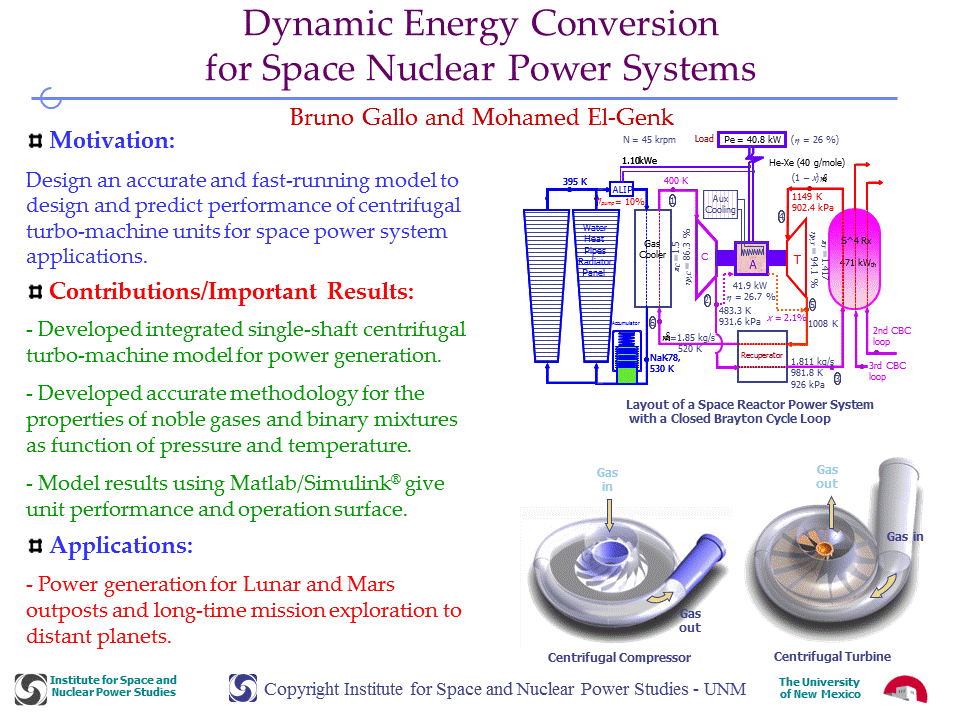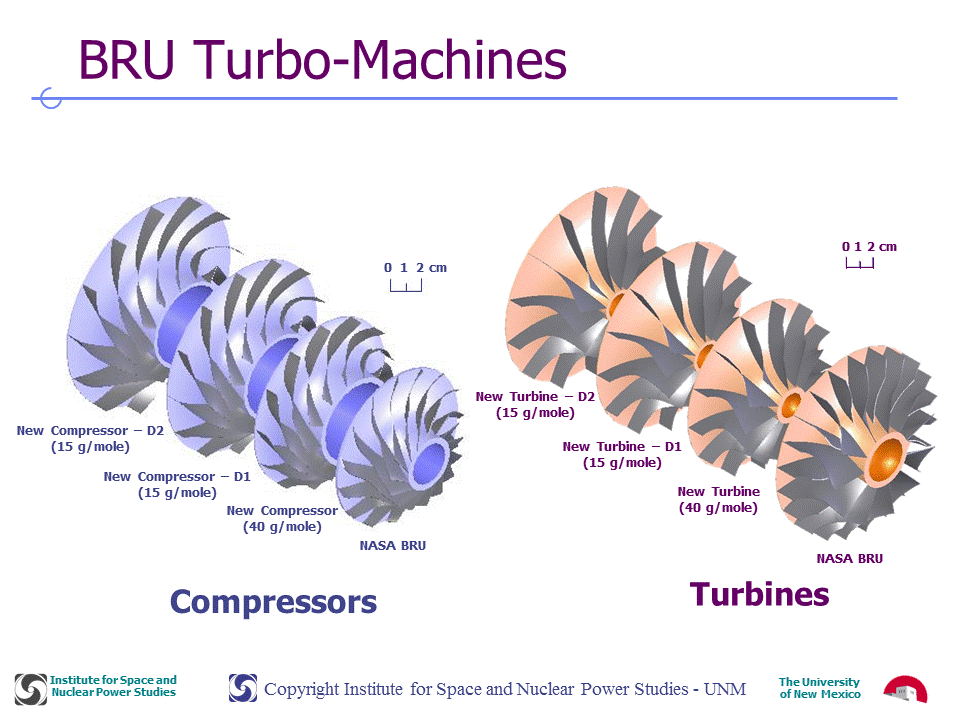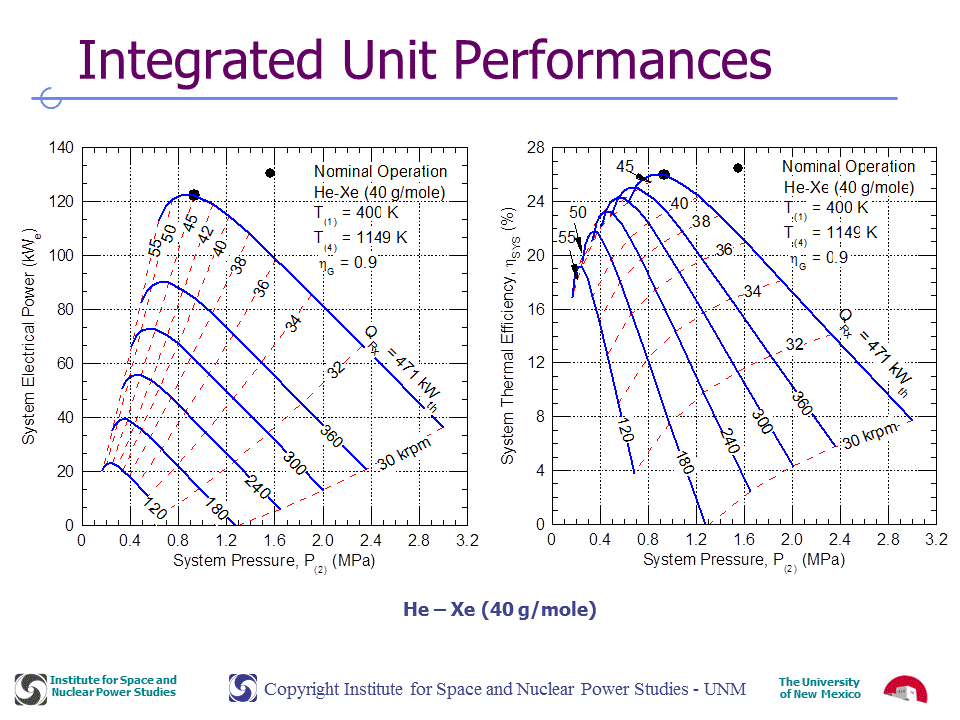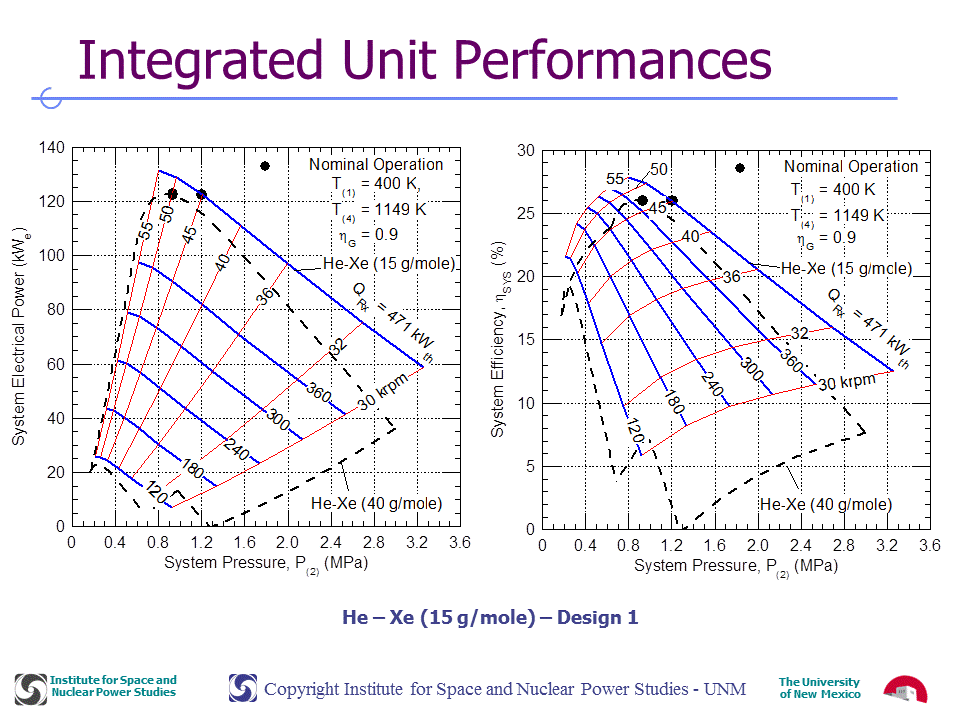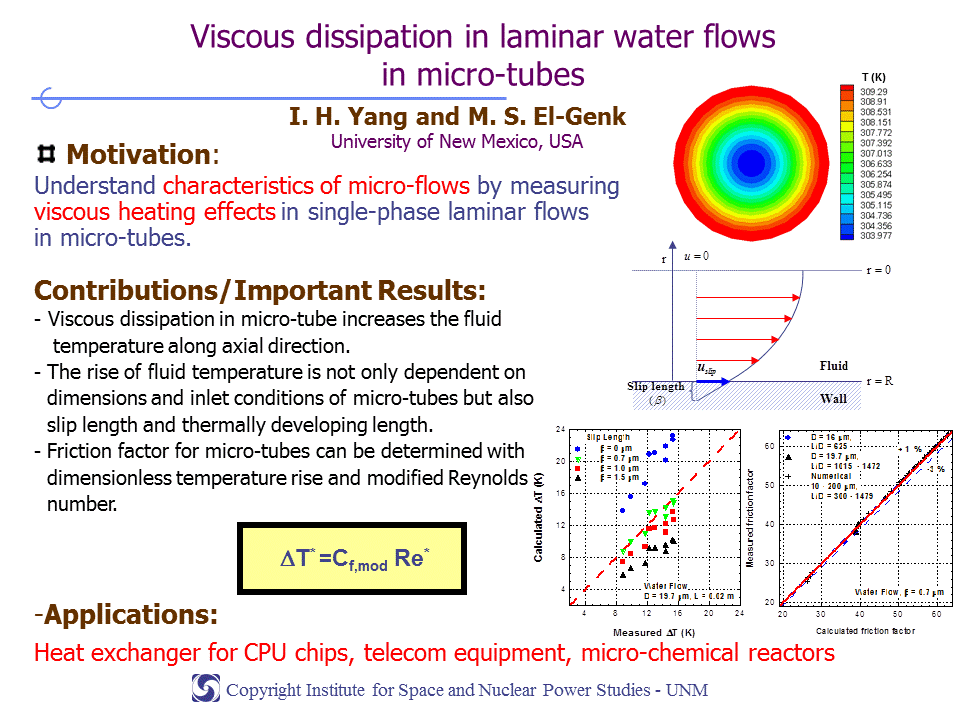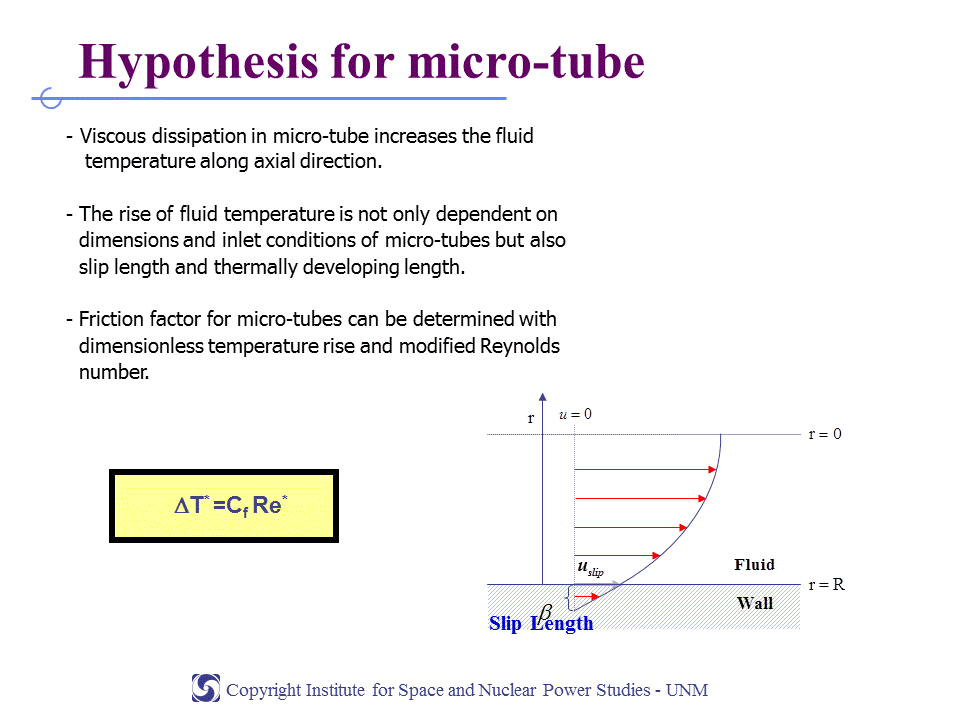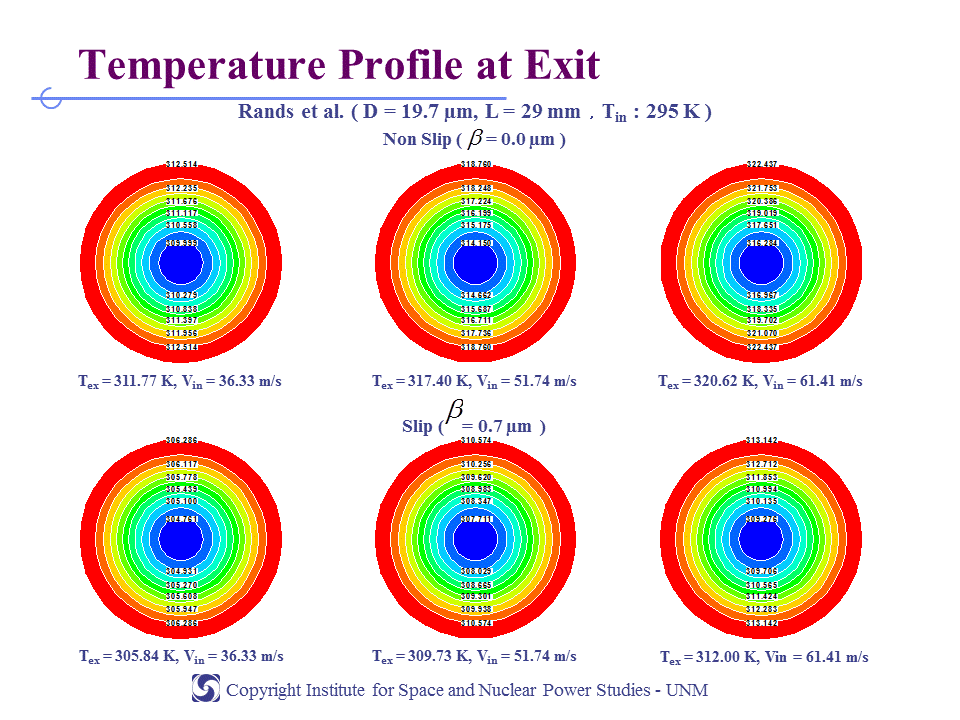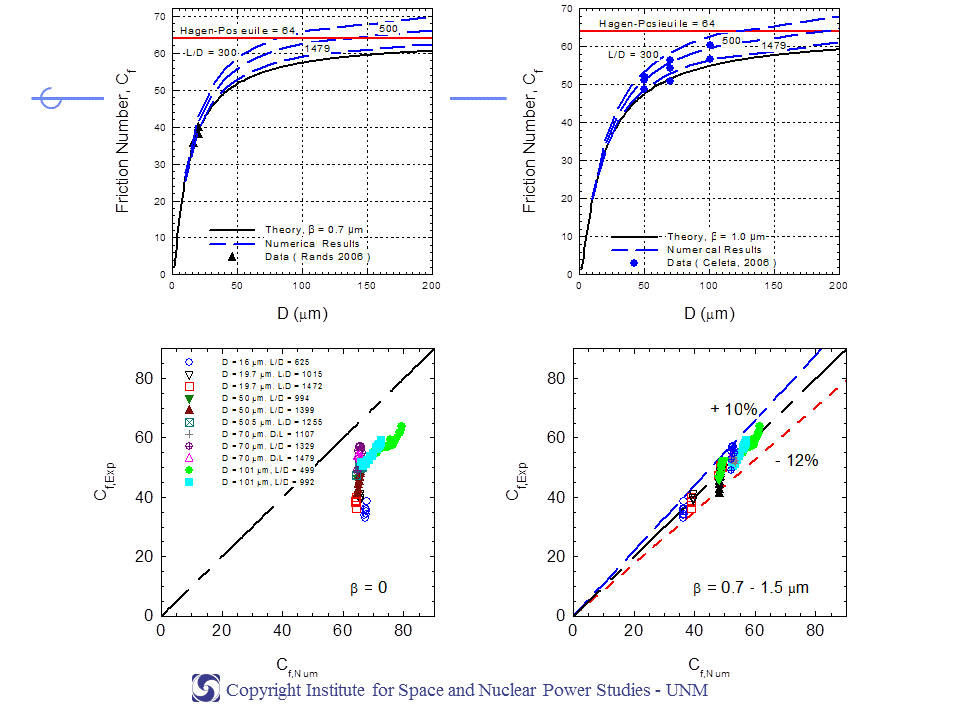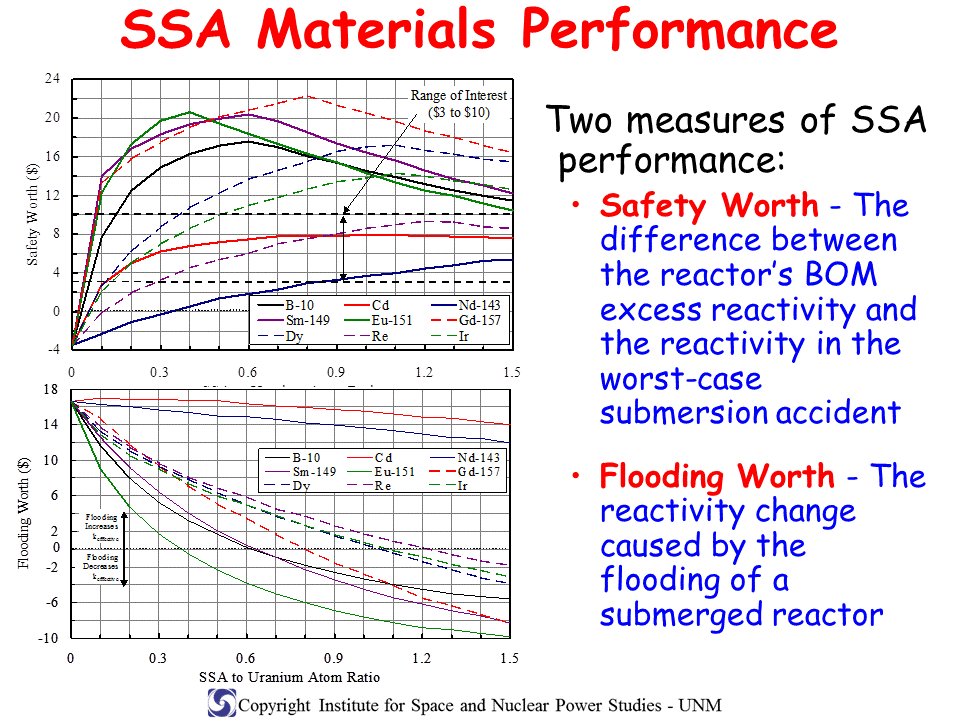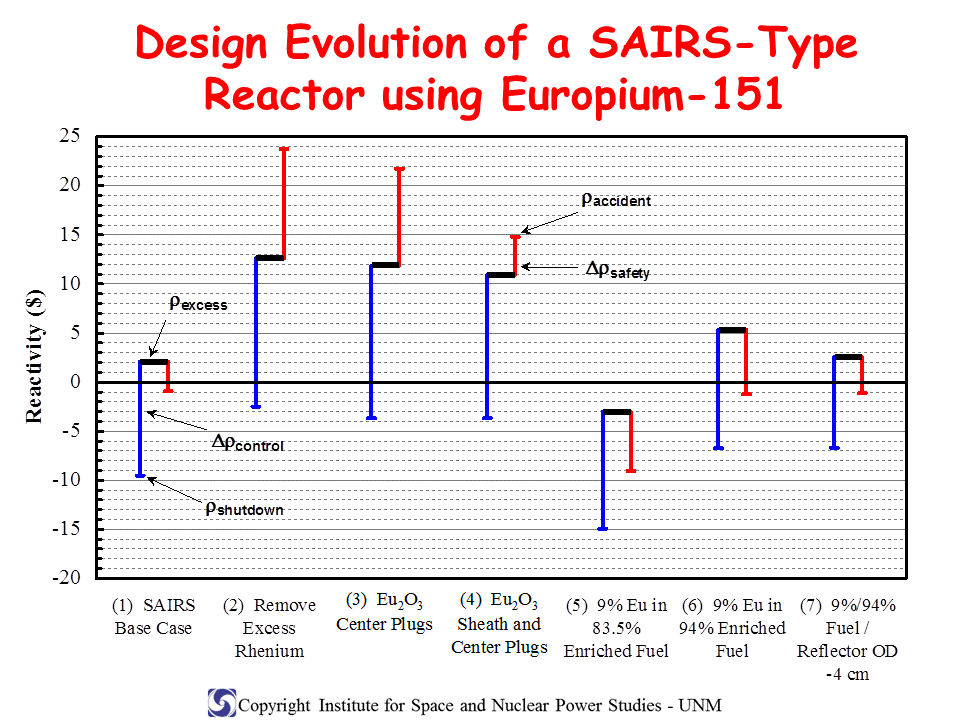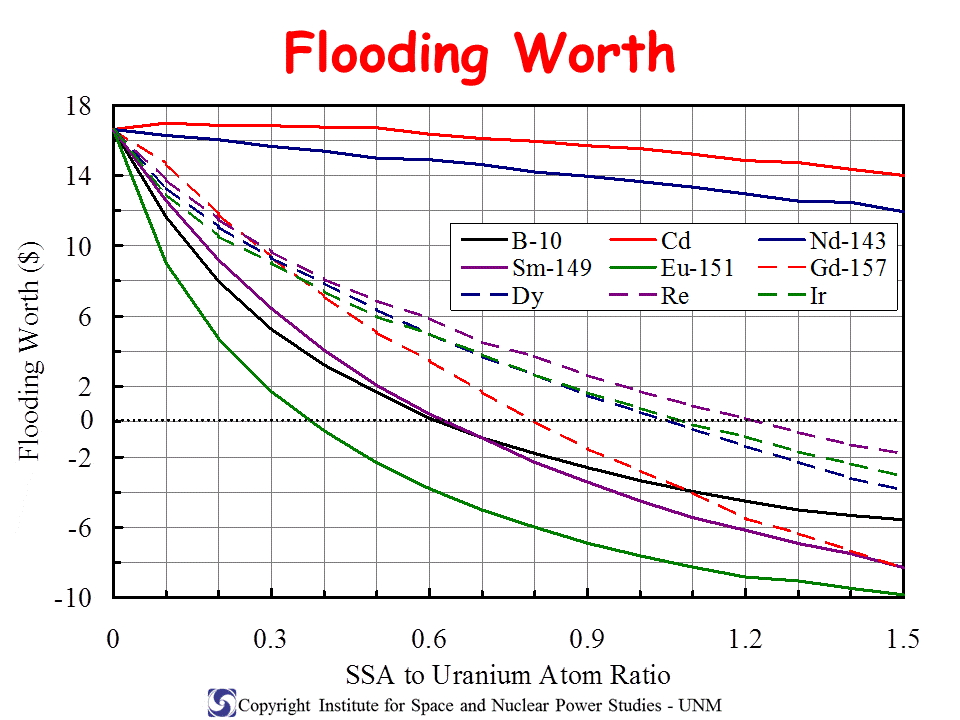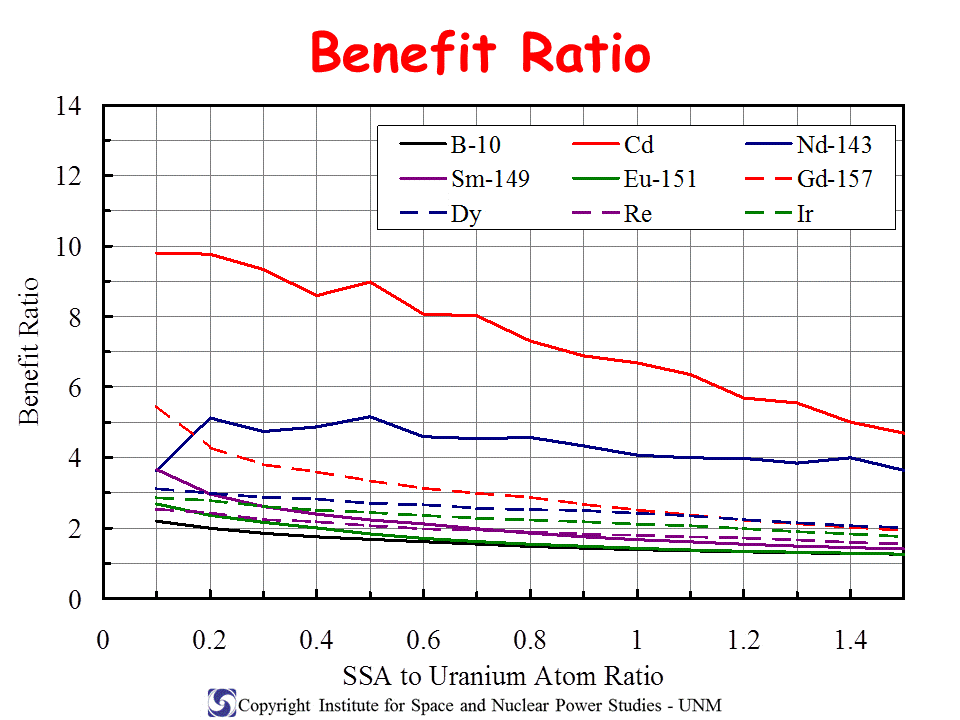- El-Genk, M.S., T. Schriener, Lightweight Heat Pipe Radiator for Nuclear Reactor Power Systems on Lunar Surface. J. Nuclear Technology, 2025. 211(3) 400-428
- Kresl-Hotz, K.R., El-Genk, M.S., Schriener, T.M., Numerical Mesh Refinement for Flow Mixing in Pool Type SFR. Proceedings ANS Student Conference 2025, 2025.
- Kresl-Hotz, K.R., El-Genk, M.S., Schriener, T.M., CFD Analyses of the Flow Mixing and Stratification in Pool Type SFR. Proceedings ANS Student Conference 2025, 2025.
- Schriener T.M., M.S. El-Genk, Armoring Lightweight Foldable Radiator Panel for Lunar Surface Fission Power Systems. J. Nuclear Technology, 2025. 1-25
- Schriener T.M., M.S. El-Genk, Launch Solid Stress Analyses of Ultra-Light Heat Rejection Radiator Module and Panel for Lunar Fission Surface Power. J. British Interplanetary Society, 2025. 78(3) 74-83
- El-Genk, M.S., T.M. Schriener, A.N. Shaheen, Machine-Learning Algorithms for Remote-Control and Autonomous Operation of the Very-Small, Long-Life, Modular (VSLLIM) Microreactor. J. Nuclear Engineering, 2025. 6(4) 54
- El-Genk, M.S., T.M. Schriener, Lightweight Heat Pipe Radiator for Nuclear Reactor Power Systems on Lunar Surface. Nuclear Technology, 2024. 1-29
- Schriener, T.M., M.S. El-Genk, Armored Lightweight Heat Rejection Radiator for Lunar Surface Nuclear Reactor Power Systems. Proceedings ANS 2024 Nuclear and Emerging technologies for Space (NETS 2024), 2024.
- El-Genk, M.S., T. Schriener, Lightweight Heat Pipe Radiator Panel for Lunar Surface Fission Power Systems. Proceedings AIAA ASCEND Conference, 2024.
- El-Genk, M.S., Designs of Space Nuclear Reactor Power Systems for the Avoidance of Single Point Failures, Launch Safety, and a Long Operation Life. Proceedings AIAA ASCEND Conference, 2024.
ISNPS Director Mohamed El-Genk invited to be Panelist at Opening Plenary of 2024 ANS Winter Conference and Expo
12/4/2024
El-Genk invited speaker at the Open Plenary Panel at ANS Winter Meeting, 17-21, 2024
12/9/2024
Masters Graduation - Ahmad Shaheen
Ferris Engineering Center
Room 1120
Mailing Address:
Institute for Space & Nuclear Power Studies
MSC01-1120
1 University of New Mexico
Albuquerque, NM 87131
Phone: 505.277.5442
Fax: 505.277.5433
Online: Contact Form
Projects Overview
Research at ISNPS
ISNPS possesses a wide range of technical expertise, including: design, thermal-hydraulics and
neutronics analysis of gas-cooled, liquid metal-cooled and heat pipe-cooled space nuclear reactors;
design optimization and performance of heat pipe radiators; thermal management of Space Nuclear Reactor
Power Systems (SNRPSs); transient modeling of heat pipes, including the startup from a frozen state;
transient operation, safety and autonomous control of fully-integrated SNRPSs; modeling, design
optimization and vacuum testing of high-temperature energy conversion devices, such as thermionic
diodes, segmented and non-segmented thermoelectric devices, and Alkali-Metal Thermal-to-Electric
Converters (AMTECs); and design, optimization, and thermal and stress analyses of segmented and
cascaded thermoelectric converters for SNRPSs and Advanced Radioisotope Power Systems (ARPSs).
The results of the research conducted at ISNPS since 1984 have been widely published in refereed
technical Journals and Proceedings of technical conferences.
Nuclear Instrumentation and Control Simulation (NICSim)
The University of New Mexico's Institute for Space and Nuclear Power Studies (UNM-ISNPS), in collaboration with Sandia National Laboratories (SNL), Albuquerque, NM, is initiating a new program starting fall 2018 under a multi-year DOE-NEUP grant. The new program is led by Distinguished and Regent's Professor Mohamed El-Genk, with key participation and involvement by Dr. Christopher Lamb, member of technical staff at SNL and Research Assistant Professor at UNM, and Dr. Timothy Schriener, Research Assistant Professor with UNM-ISNPS. The primary focus of the effort is to develop a Nuclear Instrumentation and Control Simulation (NICSim) platform with novel emulytics capability to simulate control systems and components in nuclear power plants. The platform would use the DOE SCEPTRE emulation framework, developed at SNL to evaluate cyberattacks on energy grids, to simulate digital instrumentation & control (I&C) systems in nuclear power plants by running actual software images, or, if needed, specific hardware elements of these systems. It would simulate (via computational models), emulate (via precise firmware and software execution in emulated hardware environments), and embed hardware to evaluate the cybersecurity posture, vulnerability, and potential response of control systems in nuclear power plants to cyber-attacks. The hardware emulation of I&C system components, using real device firmware and software images, would enable the NICSim platform to evaluate with high fidelity the response and behavior of the actual software running system components under cyberattack. The emulated I&C system components would be coupled to simplified, physicsbased models of a given plant's components to enable real and direct feedback of the integrated I&C system's behavior, both nominally and while under cyber-attack. The results of this cooperative and joint effort between UNM-ISNPS and SNL will help increase the understanding of the real risks of cyber- compromise to I&C systems in the existing and future nuclear power plants. This effort will also help educate and train a new cadre of engineers and computer scientists and the next generation of researchers and security specialists.
LOBO Nuclear CyberSecurity (LOBO NCS) Platform
The LOBO Nuclear CyberSecurity (LOBO NCS) Platform is currently under development at ISNPS in collaboration with Sandia National Laboratories (SNL) to investigate cyber-vulnerabilities of nuclear reactor plants. In addition to cybersecurity research, the architecture of the LOBO NCS platform can also provide academic education and professional training. LOBO NCS can support both cybersecurity investigations of existing nuclear plant I&C systems as well as research developing next generation digital I&C systems for autonomous control and remote operation. It links MATLAB Simulink models of a nuclear power plant and components to the emulated or physical hardware Programmable Logic Controllers (PLCs) in the digital I&C systems. By emulating the I&C system using virtual machines (VMs), LOBO NCS provides a higher degree of fidelity than simple functional PLC models, expanding the types of cybersecurity investigations which may be performed on the platform. It can easily be extended to different nuclear power plant types and I&C system architectures including advanced Small Modular and Micro Reactors, research reactors, and space nuclear power systems.
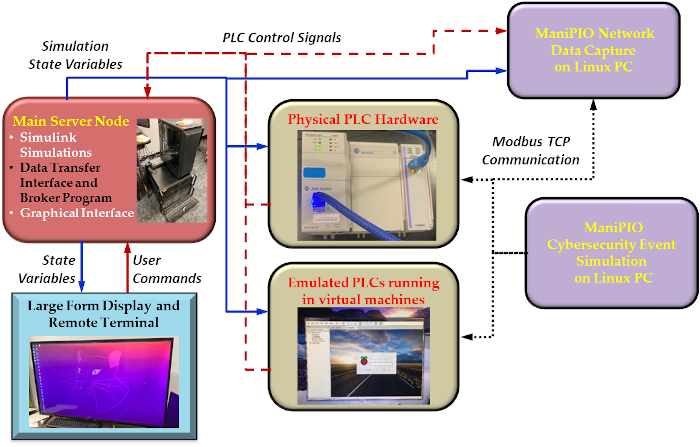
Layout and components within the LOBO NCS Platform.
The Simulink models in the LOBO NCS platform communicate to the emulated PLCs in the I&C systems using a fast and reliable data transfer interface and broker program. The transfer interface and broker programs run on the main server node as the Simulink models. The communication with and between the PLCs in the plant's I&C systems uses real industrial control systems communication protocols, such as Modbus and DNP3. Each of the emulated PLCs in the I&C systems runs within separate VMs located on multi-processor server nodes connected to main server through the testing Ethernet network. Physical hardware PLCs can also be connected to the testing network in place of, or in conjunction with, the emulated PLCs. A user-friendly graphic interface with plotting capabilities in the LOBO NCS provides a real-time display of simulation results on a large format screen. The Manipulate Process Input/Output (ManiPIO) framework initiates simulated cybersecurity events on PLCs in the I&C systems. It is developed for testing purposes and are void of any cybersecurity risks. The ManiPIO data capture module records and performs deep packet inspection of the Modbus traffic sent through the network for further analysis.
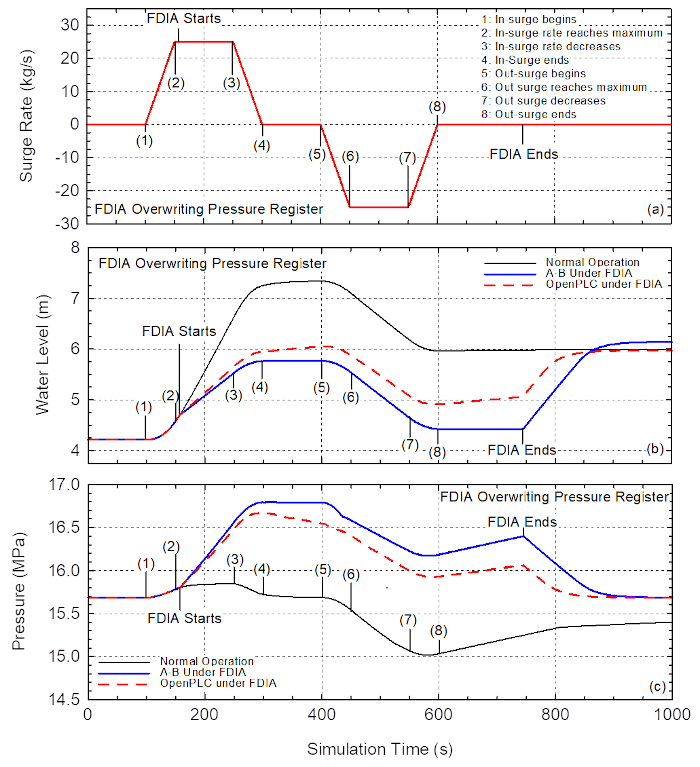
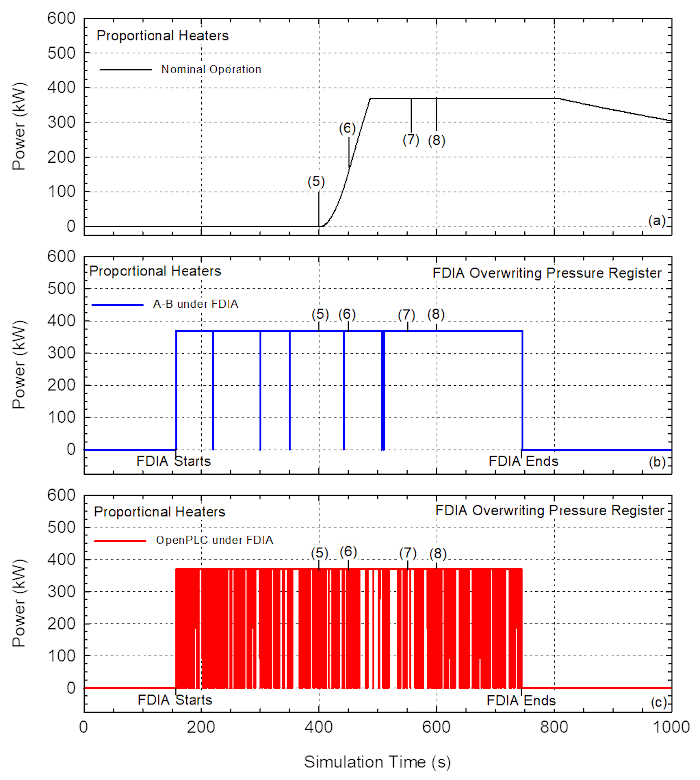
Results of simulated transient of sequential surge-in and surge-out events and of proportional heater control functions for Allen-Bradley commercial hardware PLC and emulated PLC with OpenPLC during normal operation and while under a False Data Injection Attack (FDIA) targeting the Modbus holing register for the system pressure state variable to activate the heaters within the pressurizer.
In addition to supporting the development of next generation cybersecurity and autonomous control technology and methods for terrestrial nuclear reactor power plants and space nuclear power systems, and other energy systems, the LOBO NCS platform would be used for academic education and professional training of a new cadre of nuclear cybersecurity researchers and engineers. The LOBO NCS employs widely used and often open-source modeling and simulation technology and methods. These include the Simulink programing languages, POSIX IPC shared memory data transfer and semaphores in the developed data transfer interface, and the open sources PLCs using OpenPLC. Our team welcomes the opportunities to interact with other groups developing similar capabilities and to compare results of case studies.
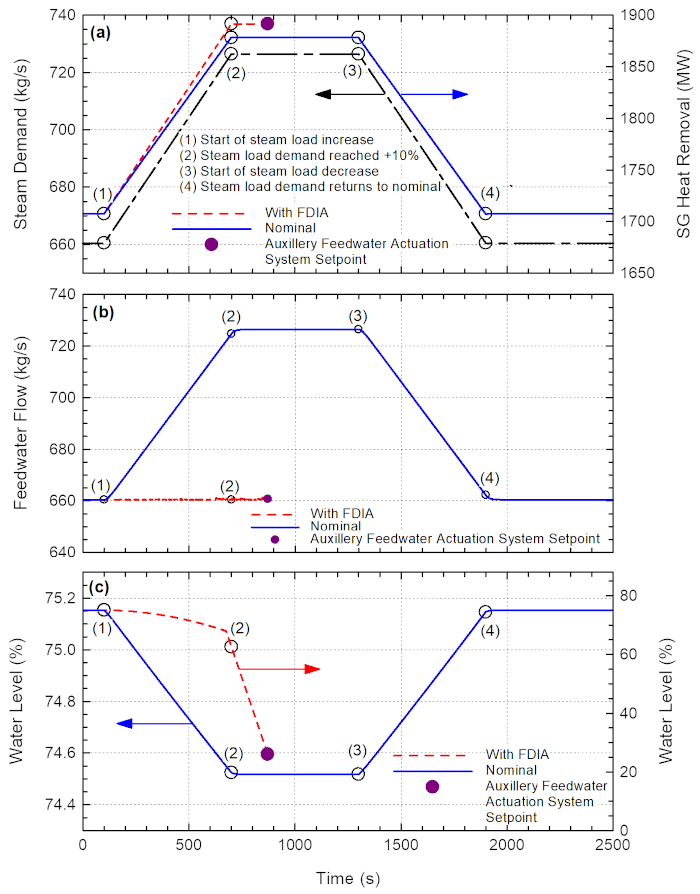
Results of simulated transient of steam generator linked to feedwater control PLC following a 10% increase in steam demand both for nominal operation and for a simulated FDIA using the ManiPIO program.
NEUP Milestone Reports
Milestone 1 Progress Report: Implementation and Validation of PLC Emulation and Data Transfer presents the results of the research effort developing and validating a programmable logic controller (PLC) emulation methodology and developing a reliable, fast running interface that effectively links a PLC to a physics based simulation model within Matlab Simulink framework.
Milestone 3 Progress Report: Emulated Programmable Logic Controllers for the Protection and Safety Monitoring and Operation I&C Systems in a Representative PWR Plant for Cybersecurity Applications presents the results of the research effort developing and test emulated PLCs for a representative PWR plant plant protection and operation I&C systems architectures. The report details the design and testing of the different PLCs as well as simulation results showing their perfromce when connected to the dynamic physics based models of the representative PWR plant.
Milestone 4 Progress Report: A Physics based, Dynamic Model of a Pressurized Water Reactor Plant with Programmable Logic Controllers for Cybersecurity Applications presents the results of the research effort developing a physics based PWR plant model within Matlab Simulink framework to be coupled with the emulated PLCs in the representative I&C system architecture in the NICSim platform. The report details the physics-based component models of the nuclear reactor, pressurizer, steam generator, reactor coolant pump, and primary loop, as well their validation testing and sample transient results.
Milestone 6 Progress Report: Validation of LOBO Nuclear CyberSecurity (LOBO NCS) Platform and Demonstration of Manipulate Process I/O (ManiPIO) Framework for Cybersecurity Testing and Evaluation presents results of the effort validating the LOBO NCS platform and testing the Manipulate Process I/O (ManiPIO) cybersecurity event generation tool. This report presents a comparison of simulated transients with the physics-based models and . emulated PLCs integrated into the LOBO NCS platform and the DOE SCEPTRE platfomr.
Some of the relevant technology and research projects which have been conducted at ISNPS include:
- Design of gas-cooled, liquid metal-cooled and heat pipe-cooled space nuclear reactors; this effort at ISNPS has led to the development of three innovative reactor concepts: the gas-cooled pellet bed reactor (PeBR), the bimodal PeBR for nuclear electrical power and thermal propulsion applications, and the recent liquid metal-cooled, Sectored Compact Reactor (SCoRe) for the avoidance of single-point failure in the reactor cooling system.
- Neutronics design and analysis of SNRPSs; current efforts are investigating the use of Spectral Shift Absorber (SSA) materials, as a passive and effective means to ensure sub-criticality of fast-spectrum space reactors in the event of water/wet-sand submersion with or without core flooding subsequent to a launch abort accident.
- Nuclear fuel design, performance, and chemical and mechanical analyses.
- Thermal management of spacecraft, power systems, and thermal energy storage systems (e.g. employing the melting and freezing of LiF or other energy storage materials, with an understanding of the thermal and change-of-phase processes in microgravity).
- Interaction of lasers with spacecraft structure , and application of Monte Carlo uncertainty analysis for performance assessment and design of future space systems.
- State-of-the-art modeling and design optimization capabilities for heat pipe radiators which use alkali metal (cesium, rubidium, potassium, sodium and lithium) and low temperature (water) heat pipes, including the startup from a frozen state. These capabilities have been extensively verified using test data.
- Design, experimental development and testing of low-temperature heat pipes , such as water heat pipes.
- Modeling of transient and steady-state operations and safety of fully-integrated space nuclear power systems (e.g. the ISNPS models of the SP-100 space nuclear power systems for 100-1000 kWe power levels (SNPSAM) and of TOPAZ-II and other single-cell TFE type space nuclear power systems (TITAM), and the latest Dynamic Simulation Model (DynMo) for SNRPSs developed at ISNPS using the Simulink® platform integrated with Matlab®).
- Autonomous control of space power systems , with application to the SP-100 space nuclear power systems.
- Modeling, design optimization and testing of static energy conversion devices technology for space applications, including Thermionics (TI), segmented and cascaded ThermoElectrics (TE), and AMTEC converters.
- Experimental investigation and performance evaluation of Pluto-Express (PX) vapor-anode, multi-tube AMTEC cells, in collaboration with the AFRL in Albuquerque, Nichols Research, and AMPS. This effort resulted in major improvements in the design of PX-series AMTEC cells that were being tested jointly at AFRL. This testing, modeling and evaluation effort also included the development of thermal conductivity data for Min-K insulation materials and a comparison of its radial and lateral conductance with those of multi-foil insulation for PX cells.
- 3-D transient and steady-state thermal and mechanical analyses of segmented and Skutterudite TE converters to assess the effect of adding different sublimation suppression coatings on the TE converters performance.
- Design and analysis of ARPSs with Cascaded and Segmented TE converters , with complete design and detailed analysis of the TE arrays and their thermal coupling to General Purpose Heat Source Bricks, and the electrical connections needed to achieve the desired load DC voltage.
- Submersion cooling experiments of high-performance computer chips using pool boiling of dielectric liquids such as HFE-7100 and FC-72 from micro-porous surfaces.
 Back to The Top
Back to The TopProjects Completed
I. Nuclear Fuel Technology
- Design and analysis of nuclear fuel storage facilities
- Thermophysical properties and swelling behavior of nitride and carbide fuels
- Coated particle fuel compact (CPFC) for use in radioisotope heater units (RHUs) and general purpose heat sources (GPHSs)
- Compatibility of hydrogen with carbide and structural materials at high temperatures See publications on this topic


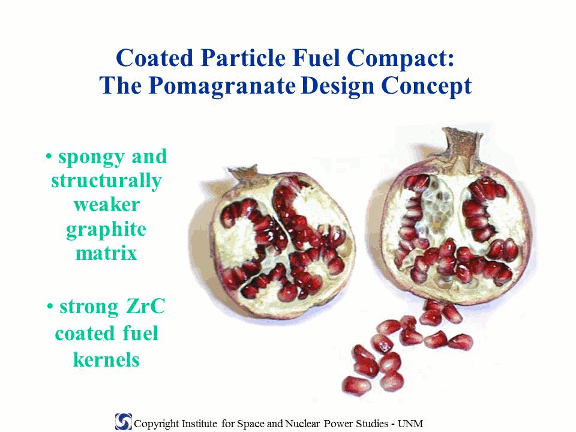
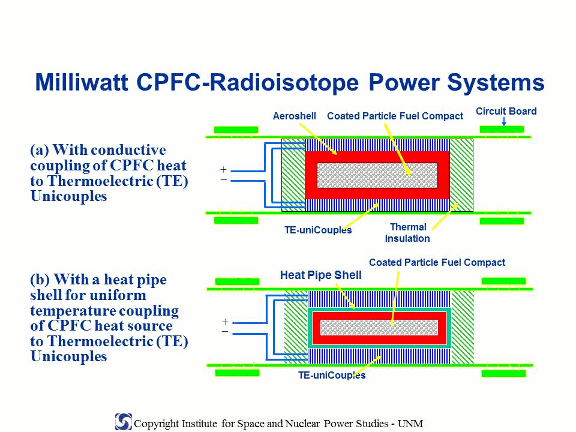

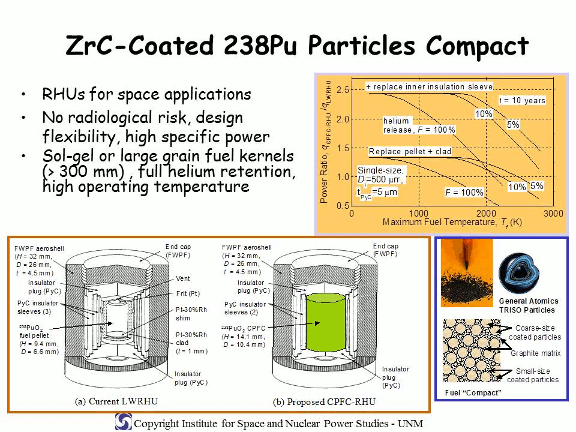
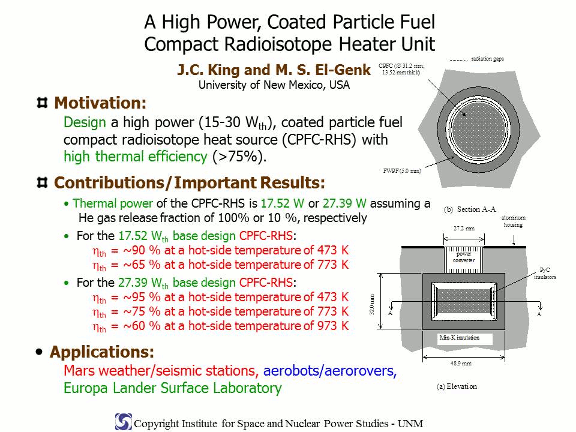
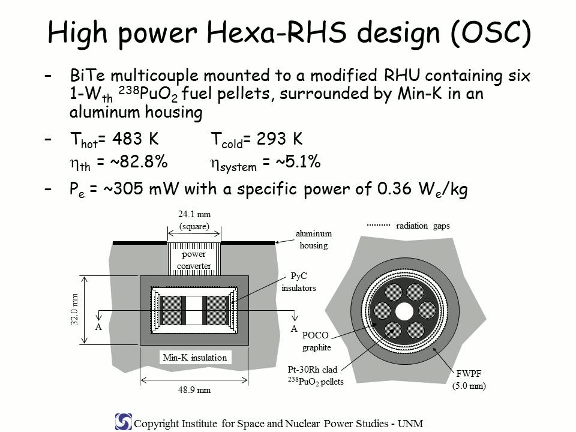
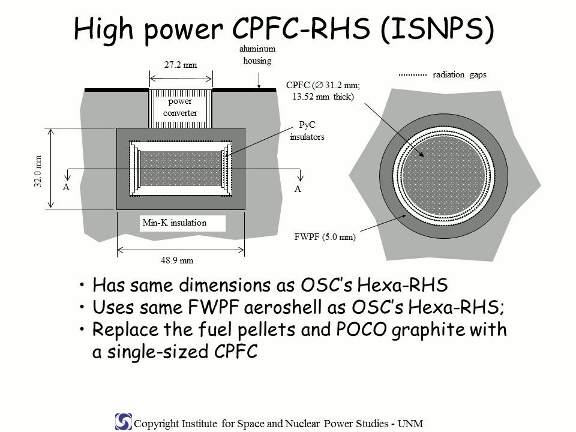
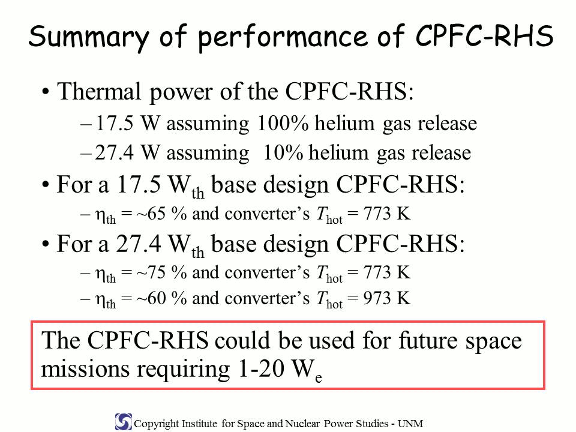
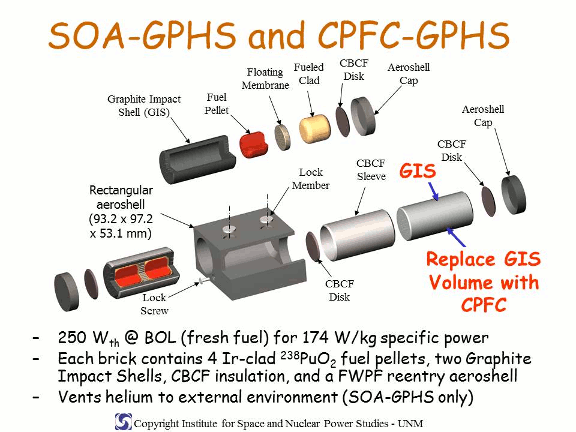

II .Nuclear Reactor Safety
- Analysis of core meltdown accidents and molten fuel-coolant interaction phenomena
- Nuclear fuel swelling and irradiation behavior during normal operation and severe accidents
- Debris bed coolability with application to post-accident heat removal See publications on this topic
III. Nuclear Reactor Thermal-Hydraulics
- Flow visualization and modeling of transition from mixed convection to buoyancy-induced turbulence in vertical annuli
- Pool boiling and critical heat flux from underside of flat and curved surfaces with application to reactor vessel cooling in severe accidents
- Critical heat flux at low flow and low pressure
- Natural and mixed convection of water in multi-rod bundles and vertical annuli See publications on this topic
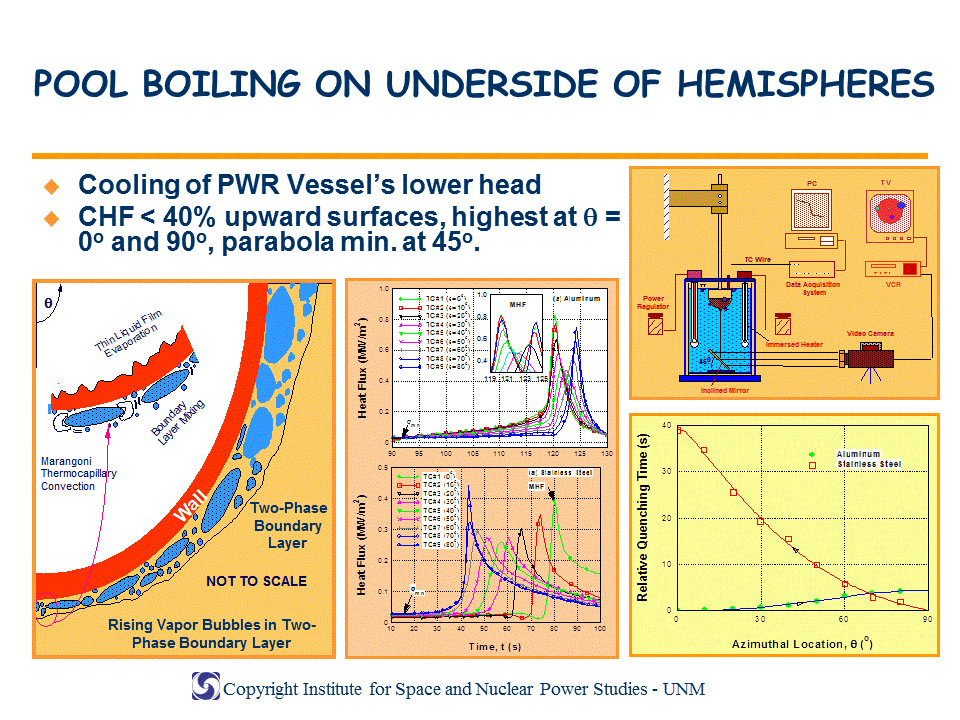
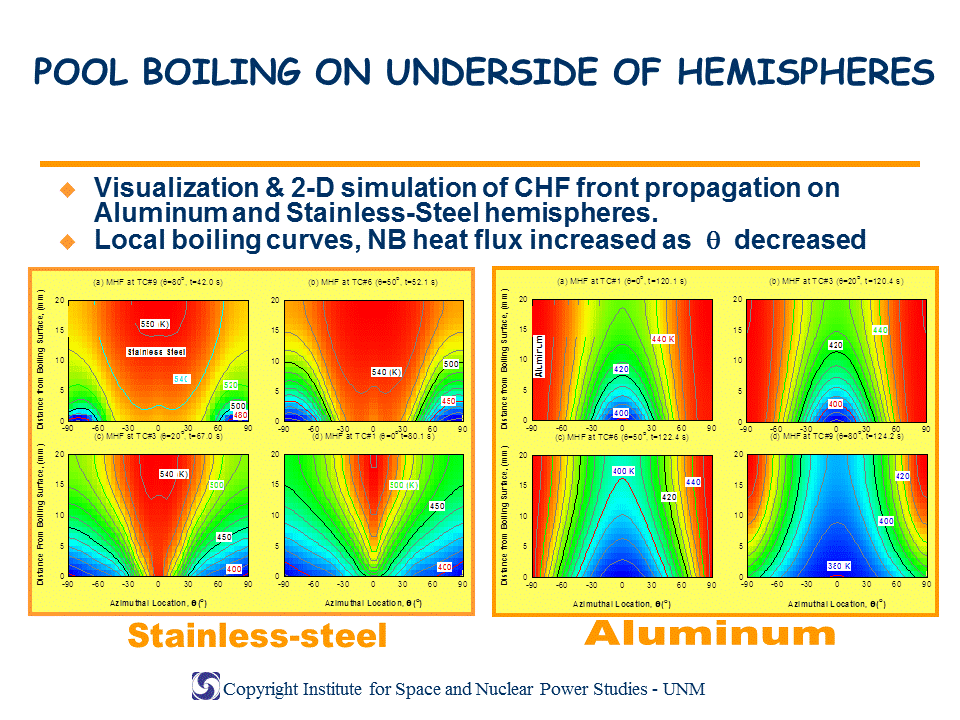
IV. Space Nuclear Power and Propulsion Systems
- Design, optimization, modeling, and analysis of space power systems
- SP-100
- TOPAZ-II
- Pellet Bed Reactor (PeBR) for thermal and electric propulsion missions
- Bimodal systems for electric power and thermal propulsion
- Heat Pipes - Segmented Thermoelectric Module Converters (HP-STMCs) space reactor power system
- Scalable AMTEC Integrated Reactor Space Power System (SAIRS)
- Design and analysis of SP-100 thermoelectric space power system
- Studies of void formation during the freezing of alkali metal coolants
- Design and analysis of TOPAZ-II thermionic space power systems
- Design and analysis of radiation shield and nuclear reactors for space missions and surface power
- Reactor design with high burnup capabilities
- Design of heat pipes-cooled fast spectrum reactors
- Design of heat pipes radiator for space reactor power systems
- Materials studies for use in space nuclear power systems
- i. Refractory metals
- ii. Mechanically Alloyed-Oxide Dispersion Strengthened Steels
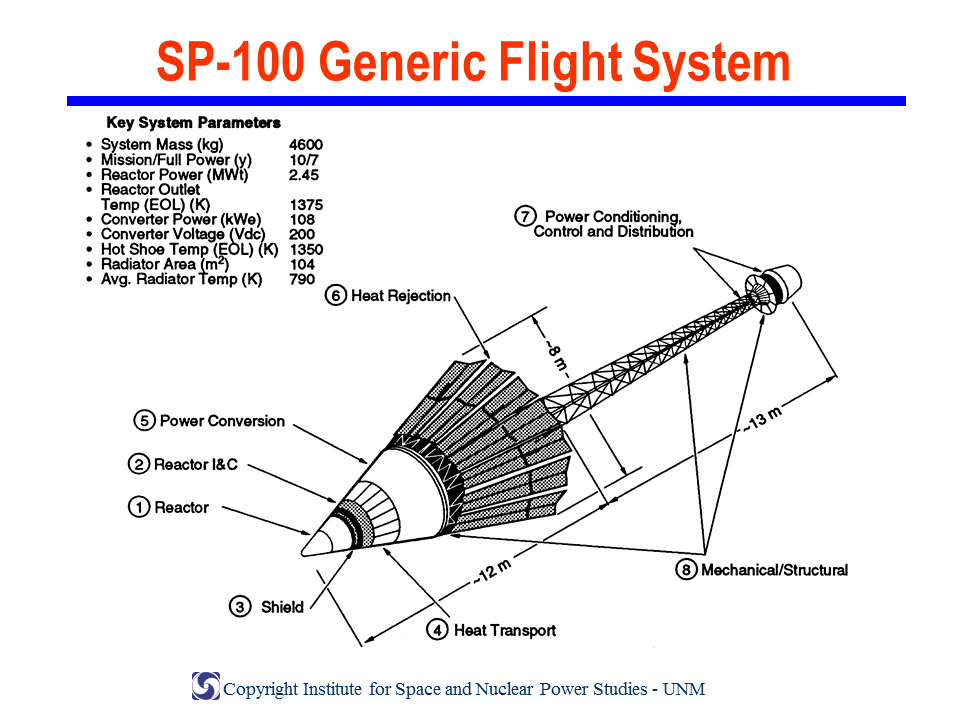
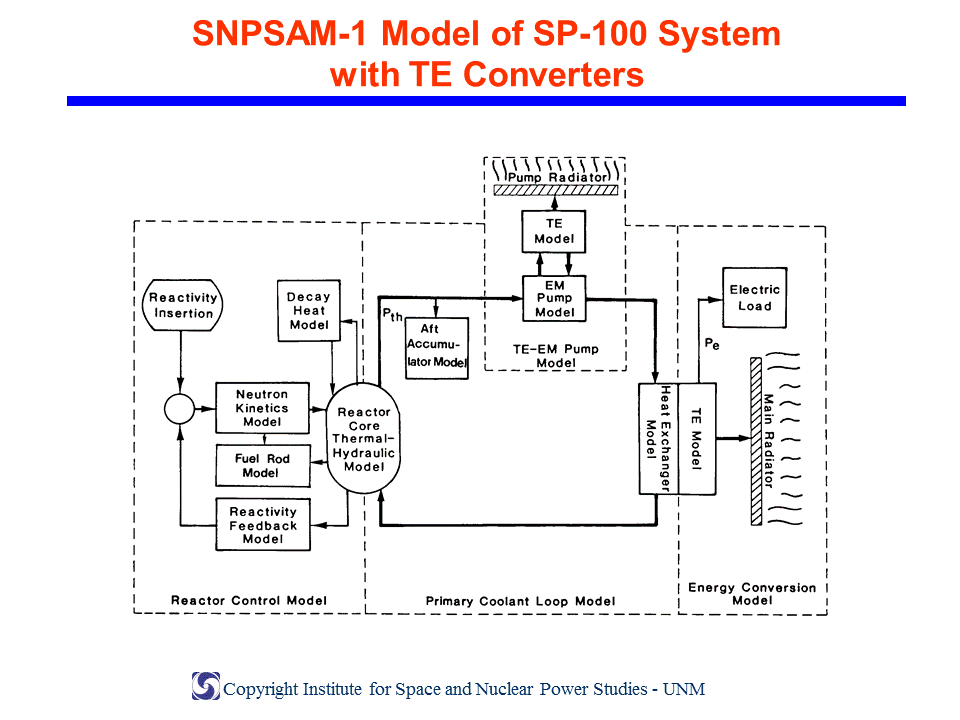

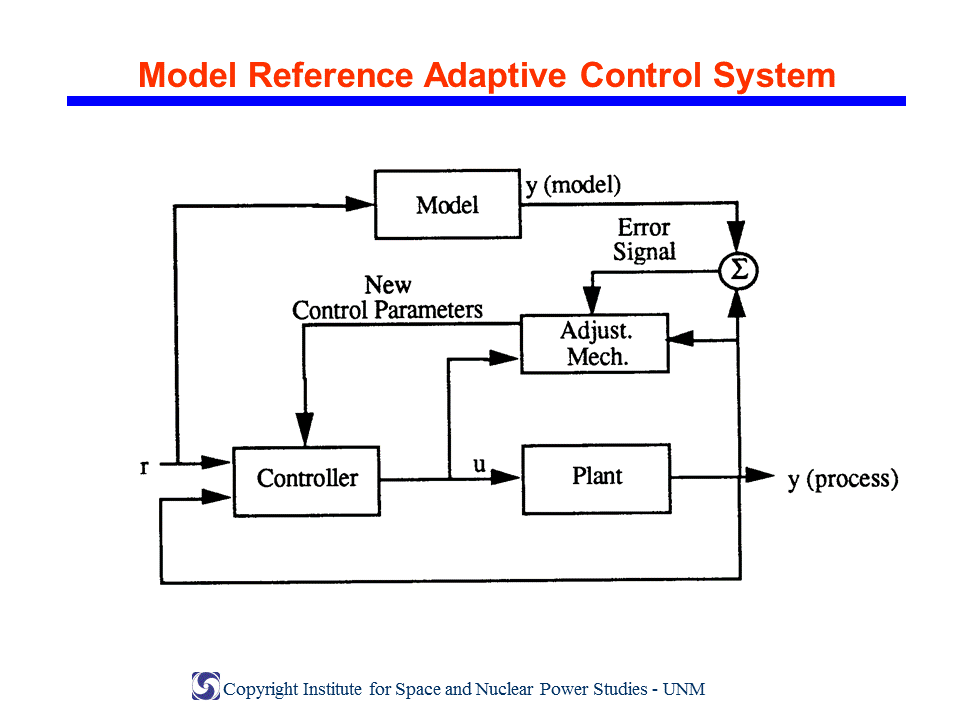



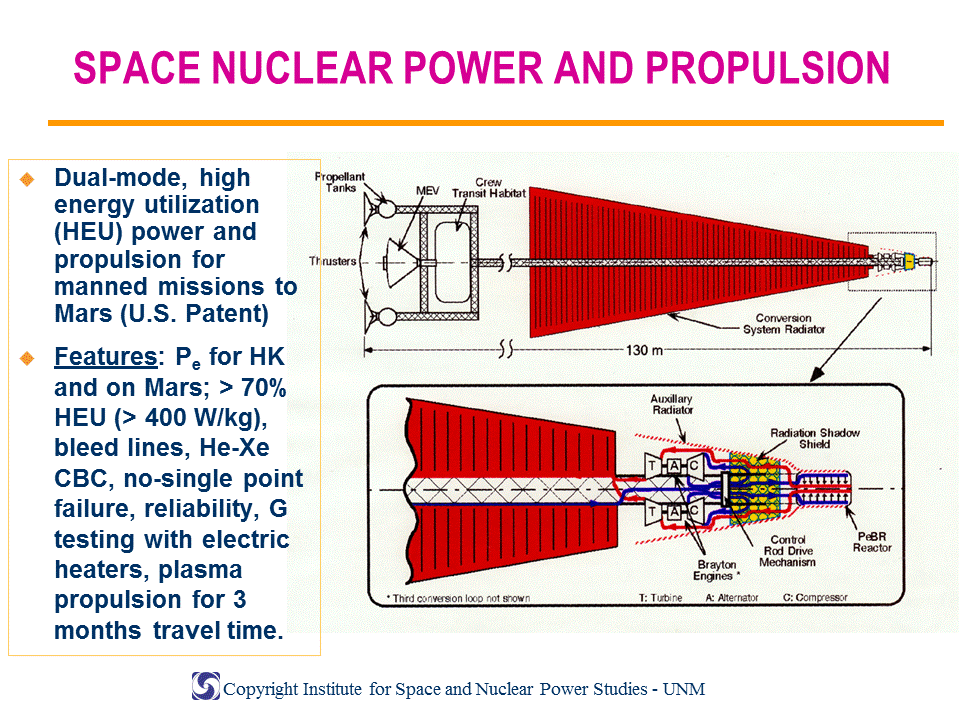
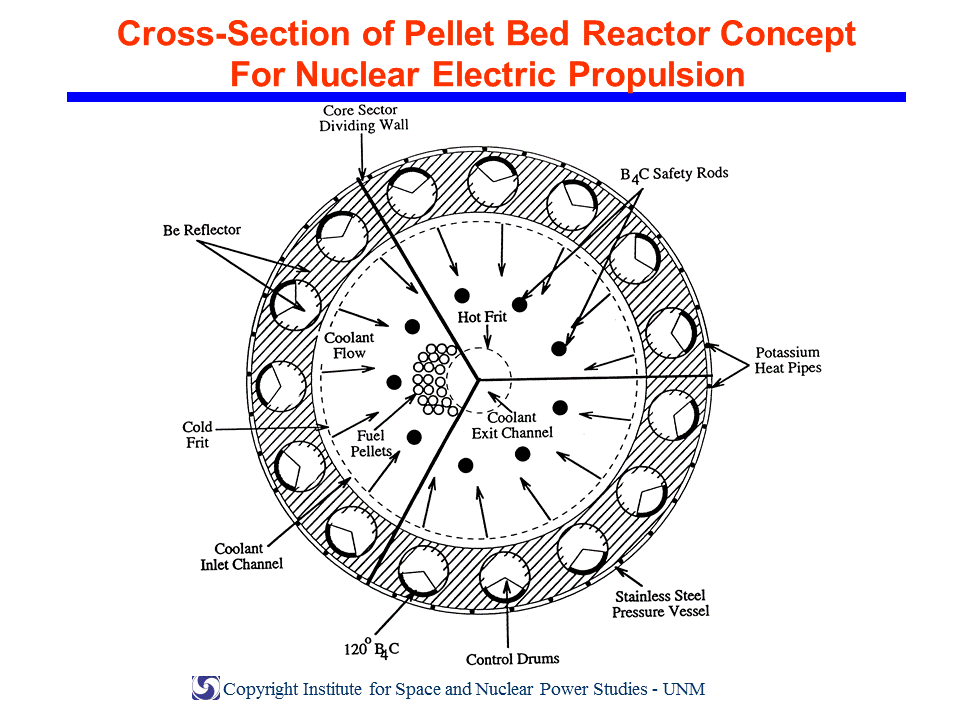
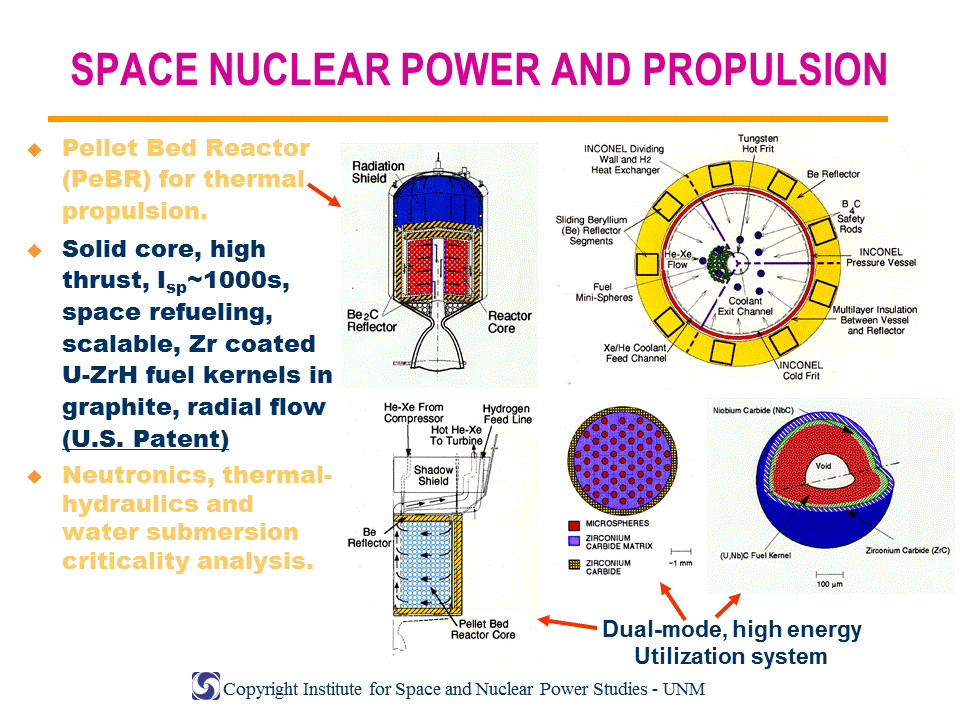
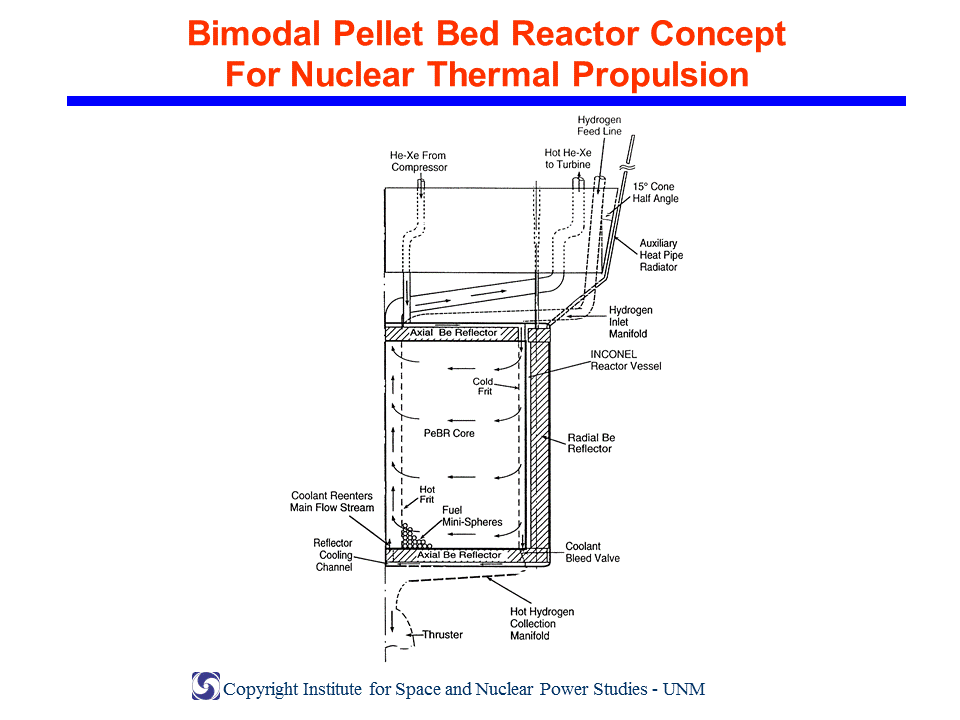
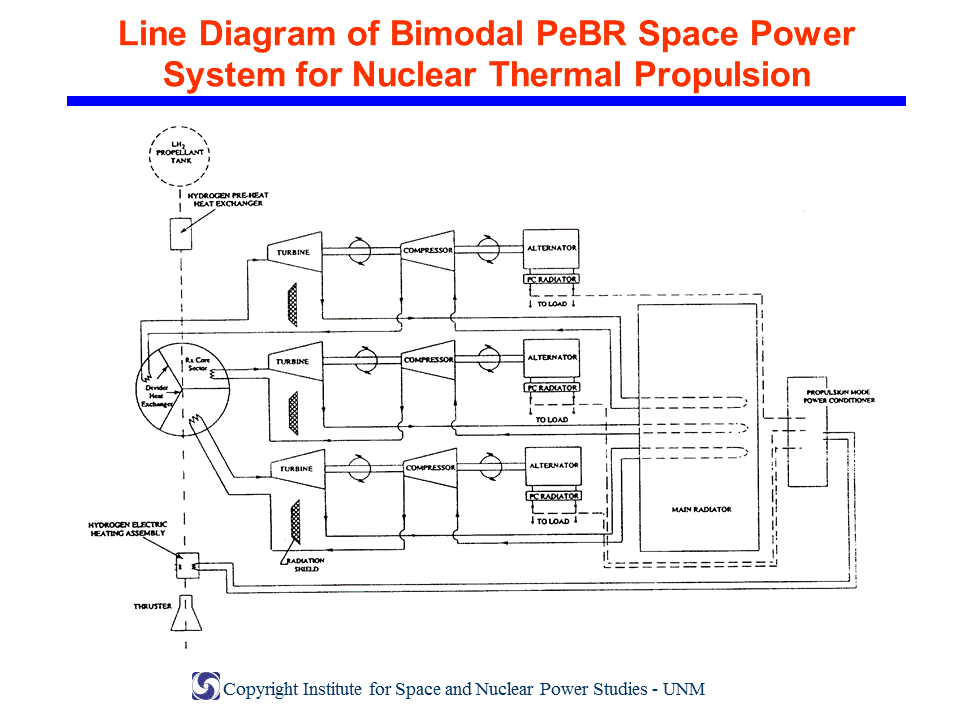
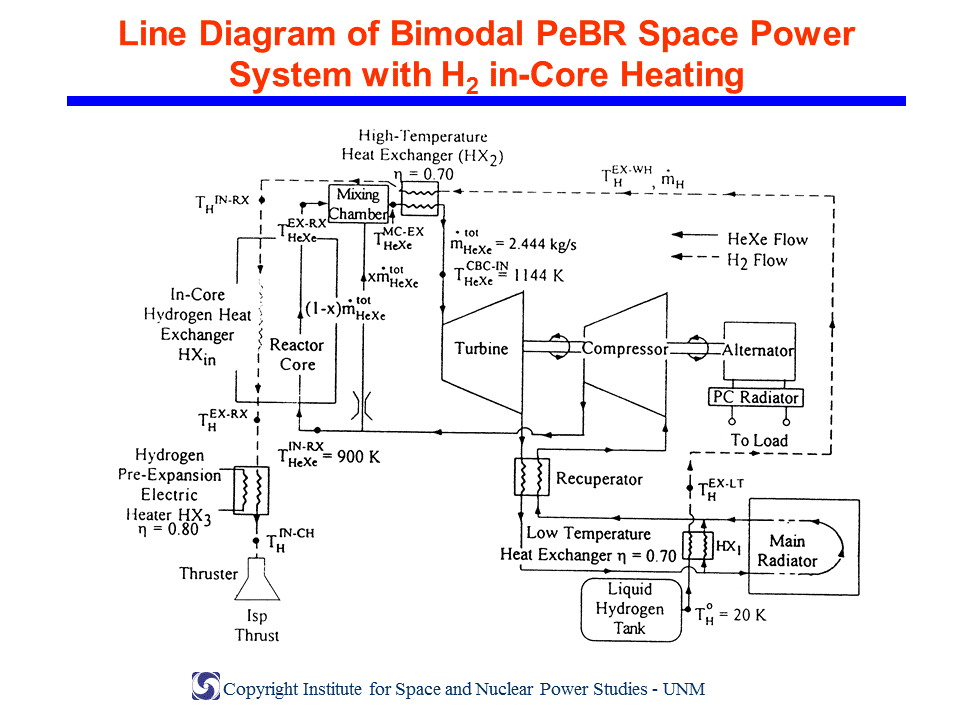


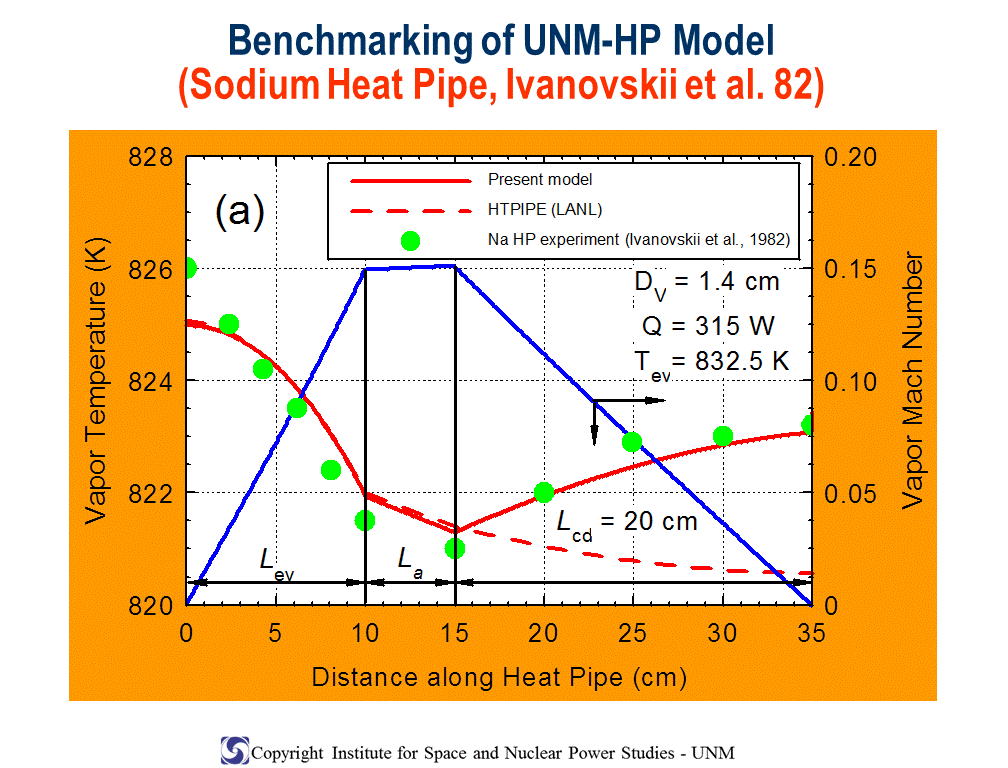
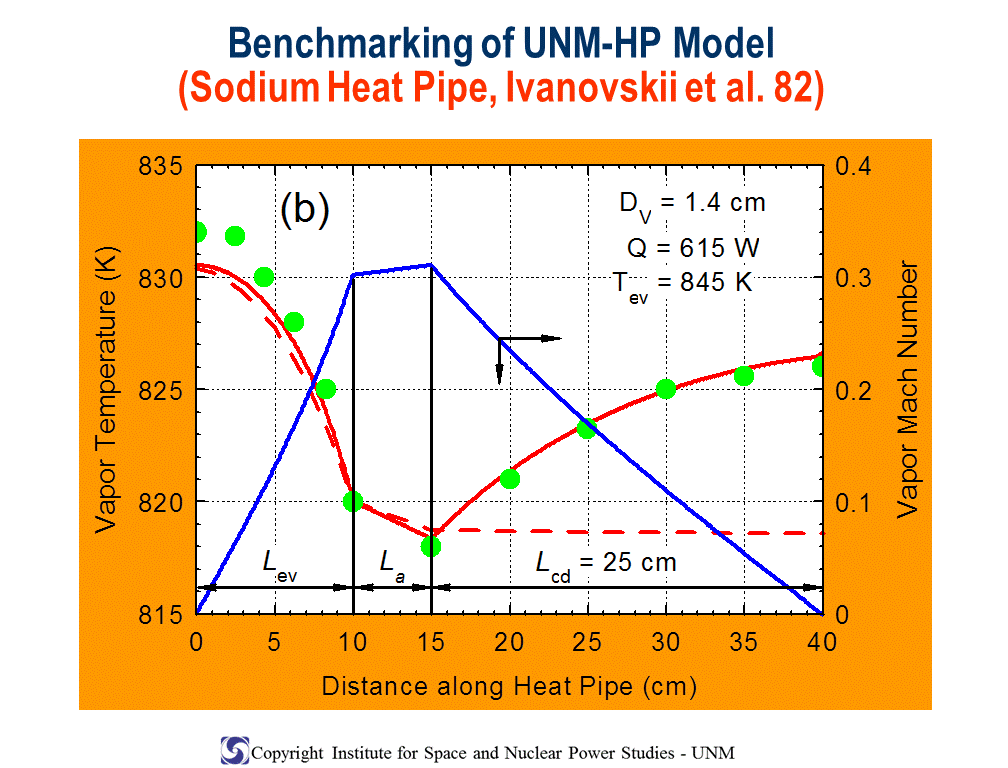
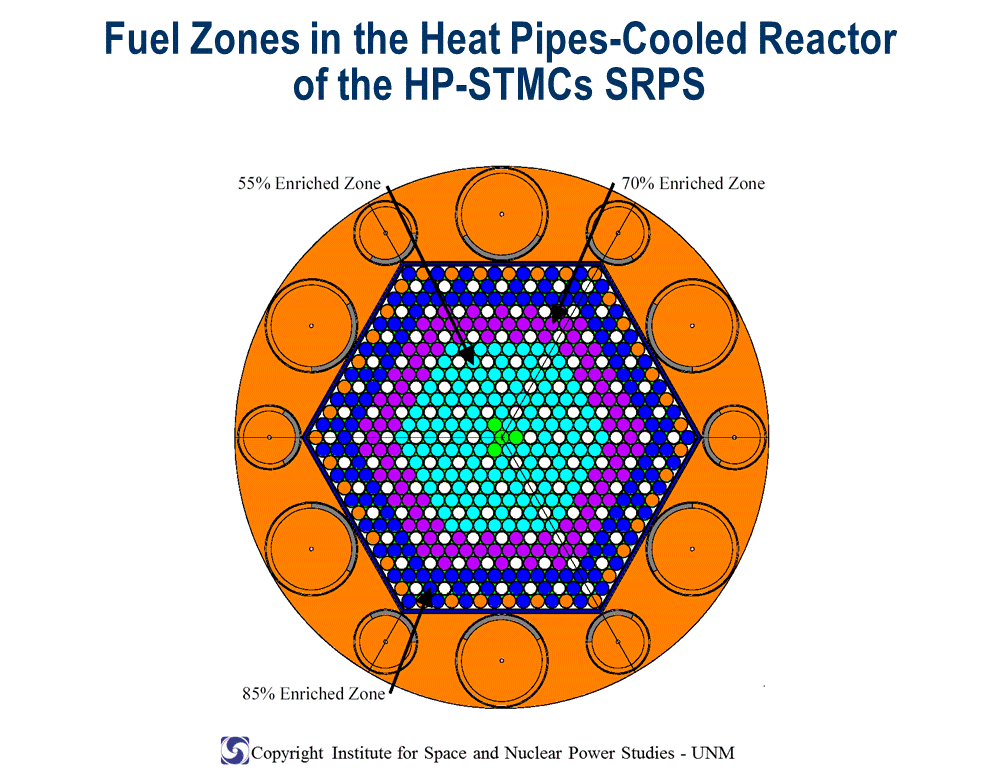
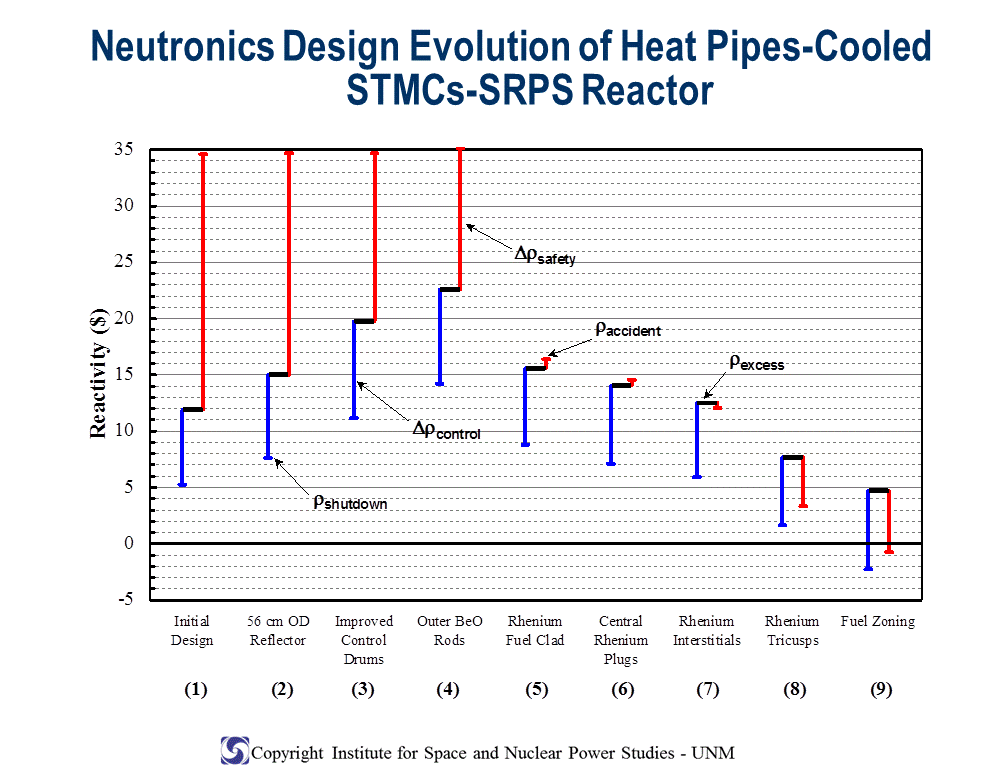
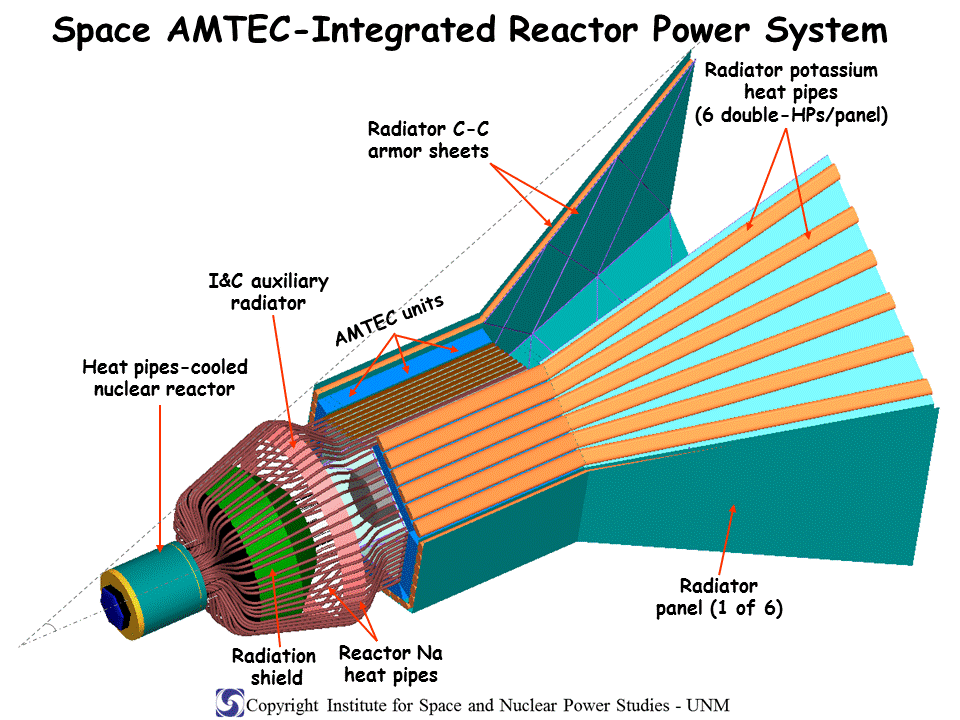
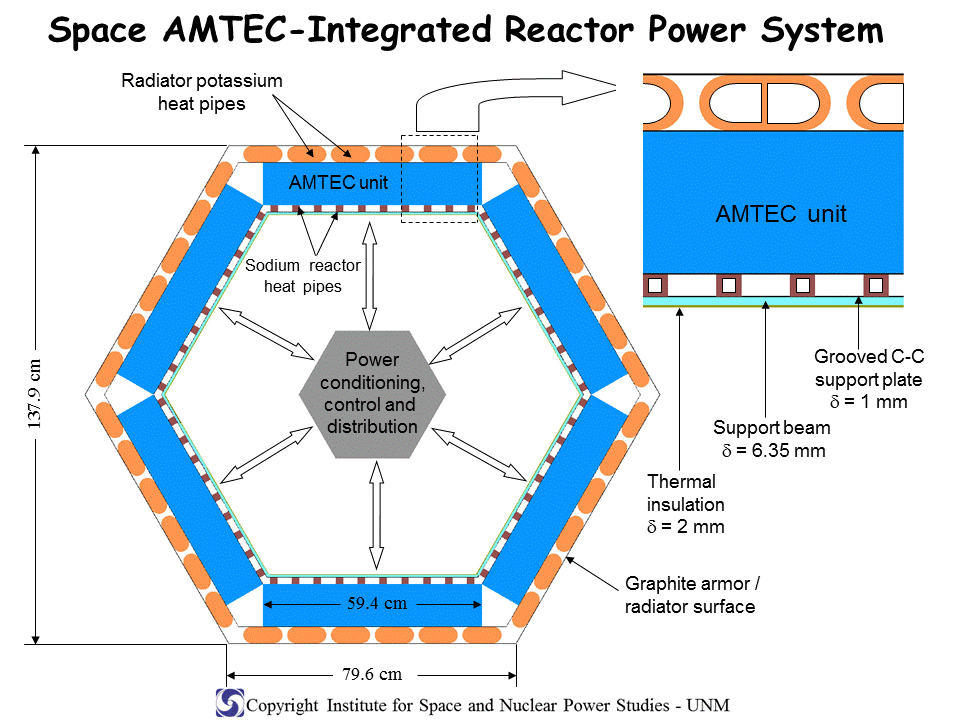


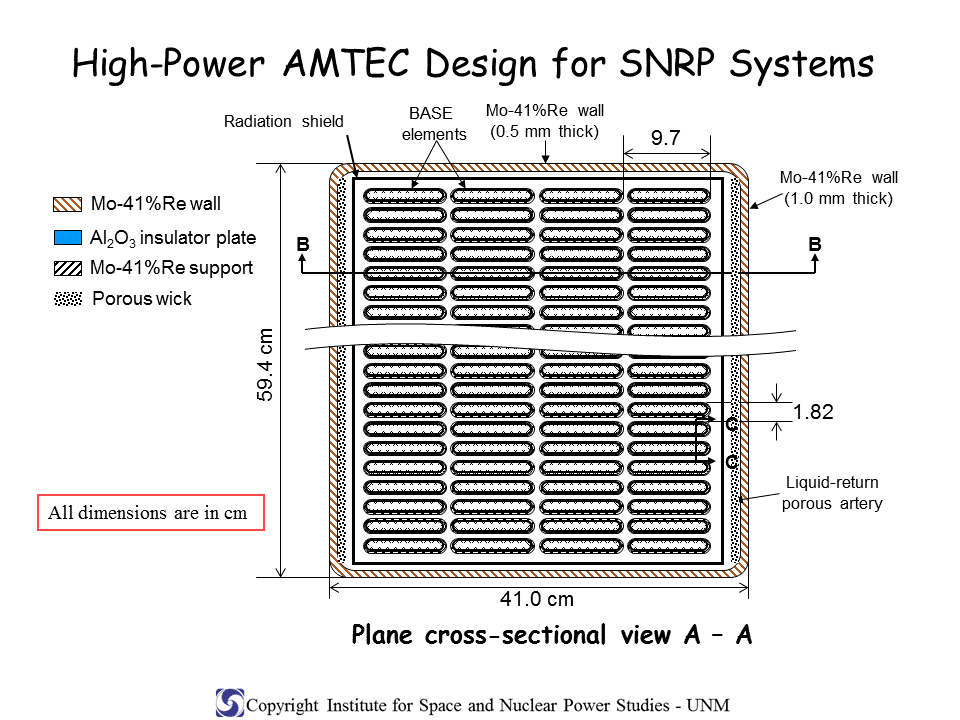
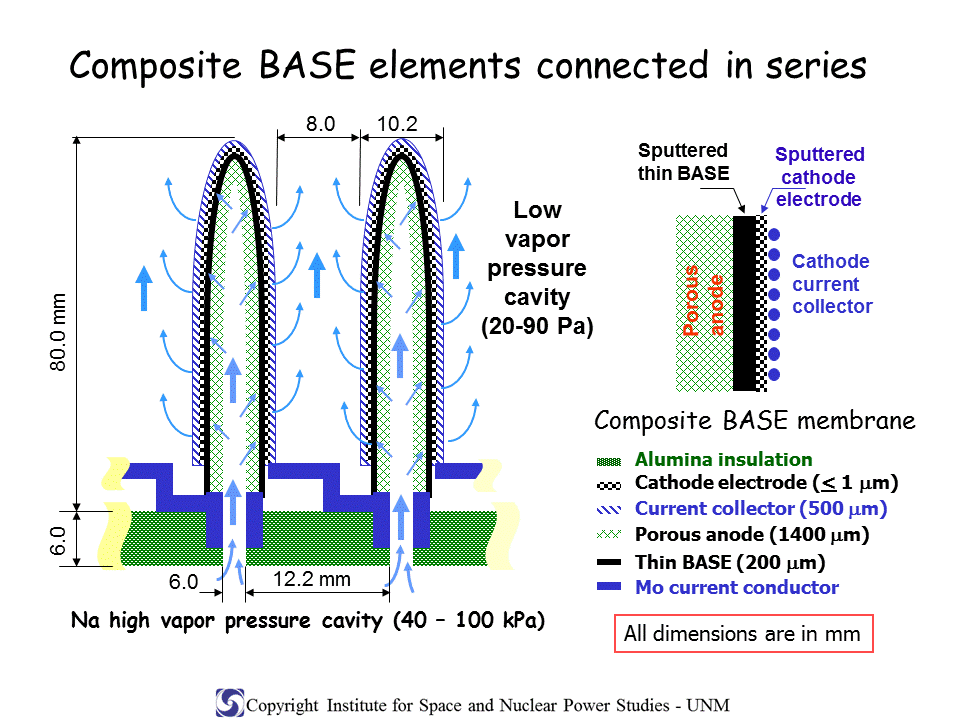
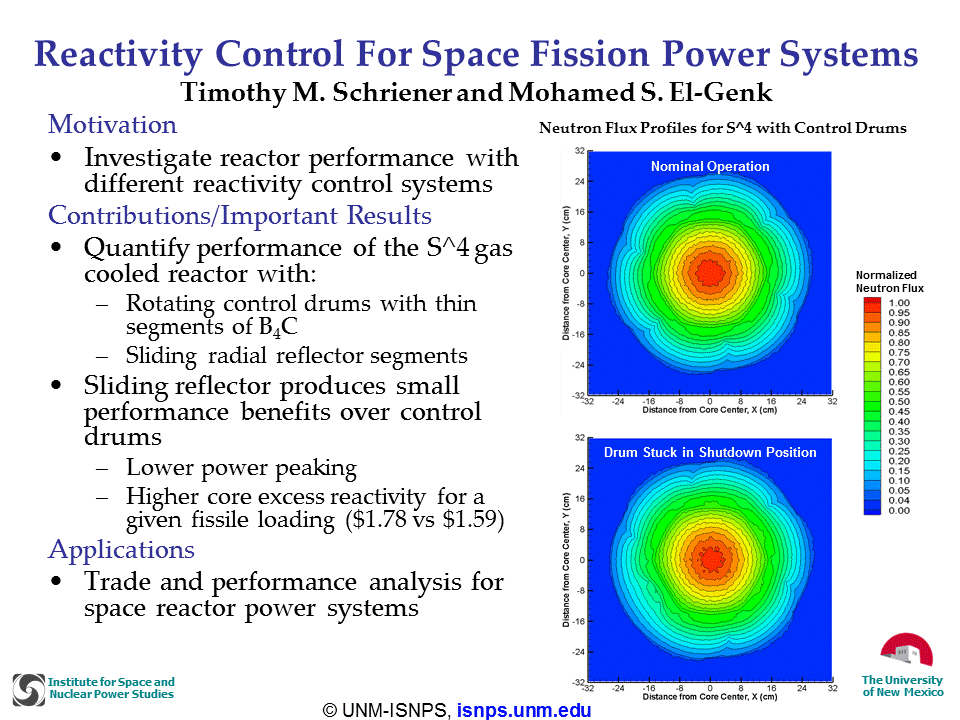

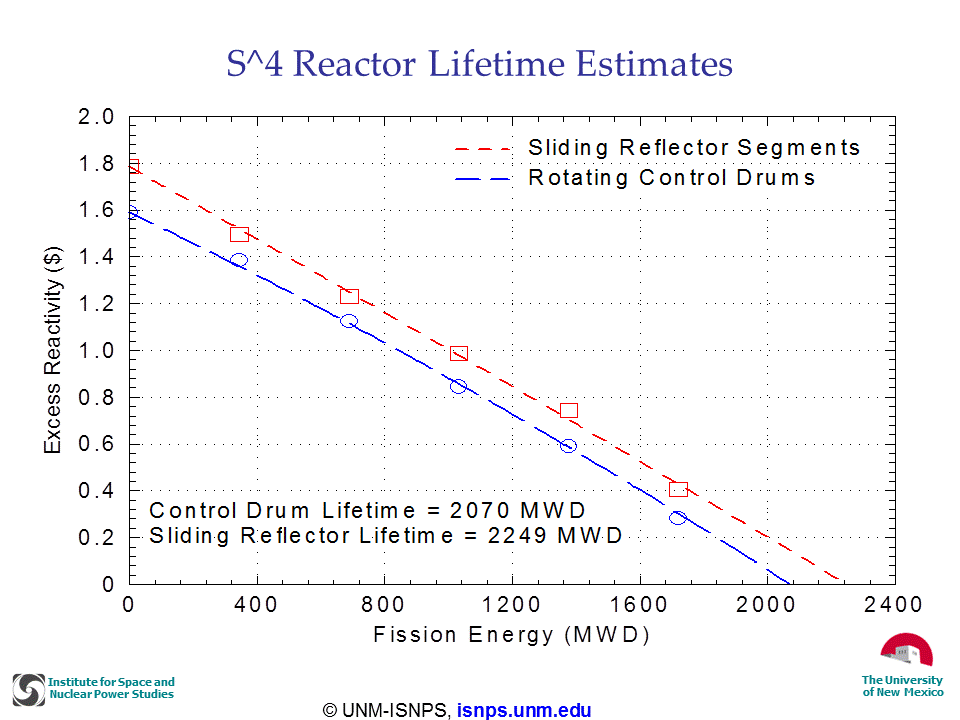
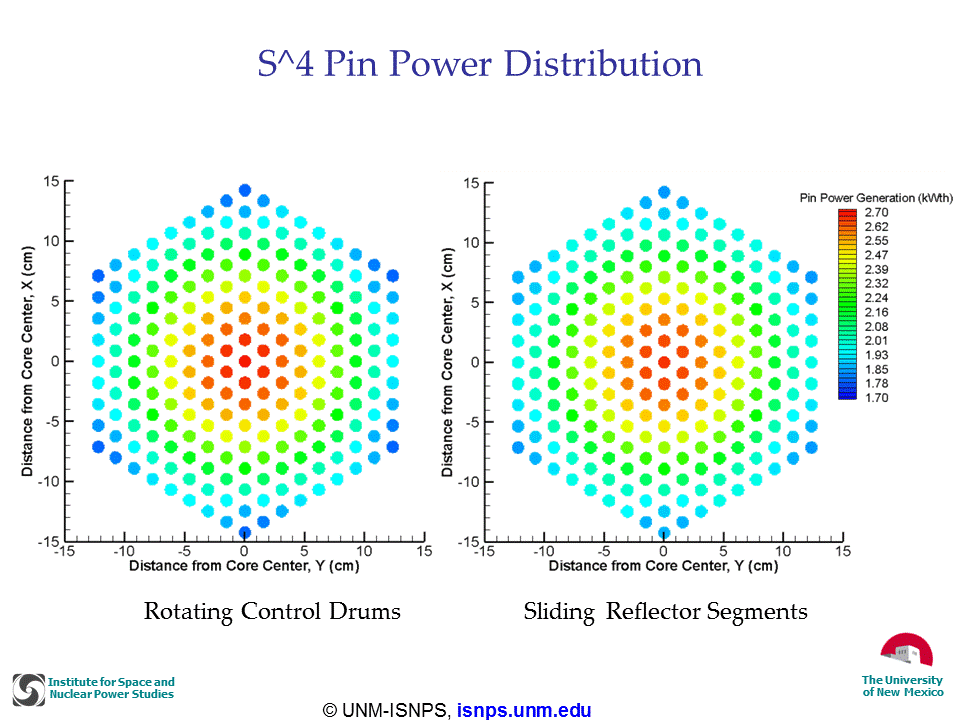

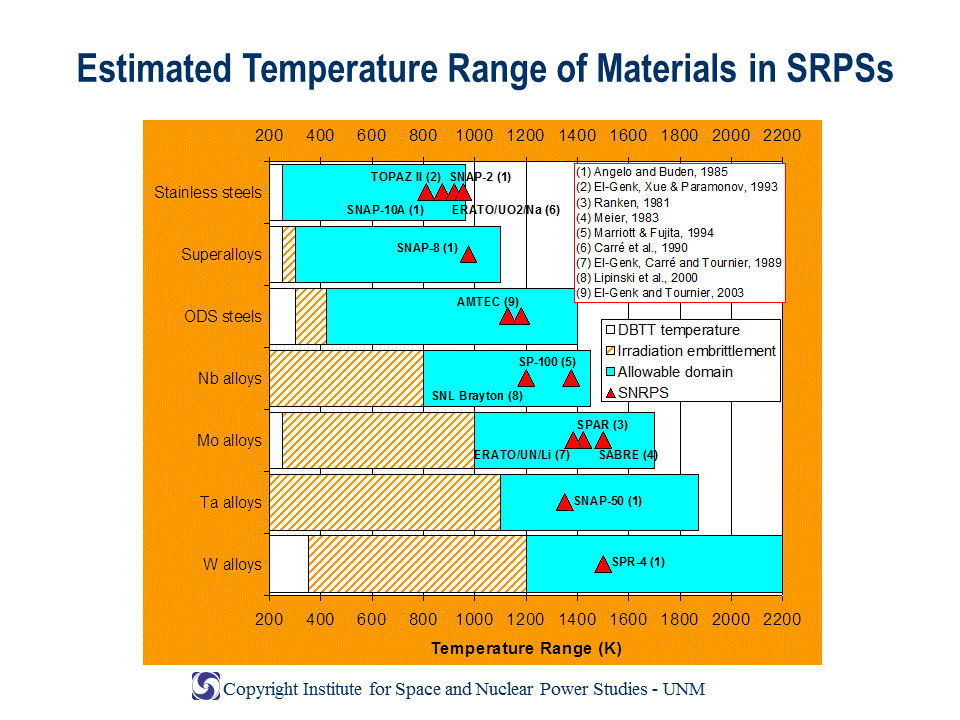
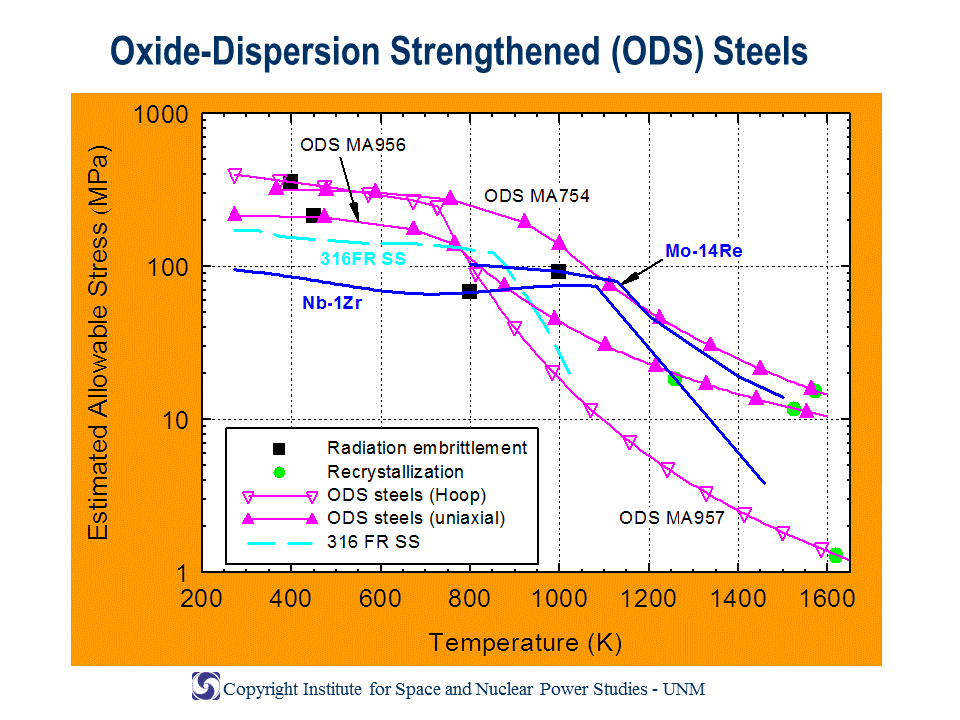
 See publications on this topic
See publications on this topic
V. Planetary Surface Power Systems - Manned Rover and Surface Outpost
VI. Advanced Radioisotope Power Systems (ARPSs)
- Coated particle fuel compact (CPFC) for use in radioisotope heater units (RHUs) and general purpose heat sources (GPHSs)
- Vapor anode, multitube AMTEC cells for ARPSs
- SiGe/Skutterudites cascaded thermoelectrics for ARPSs
- Energy conversion options for ARPSs












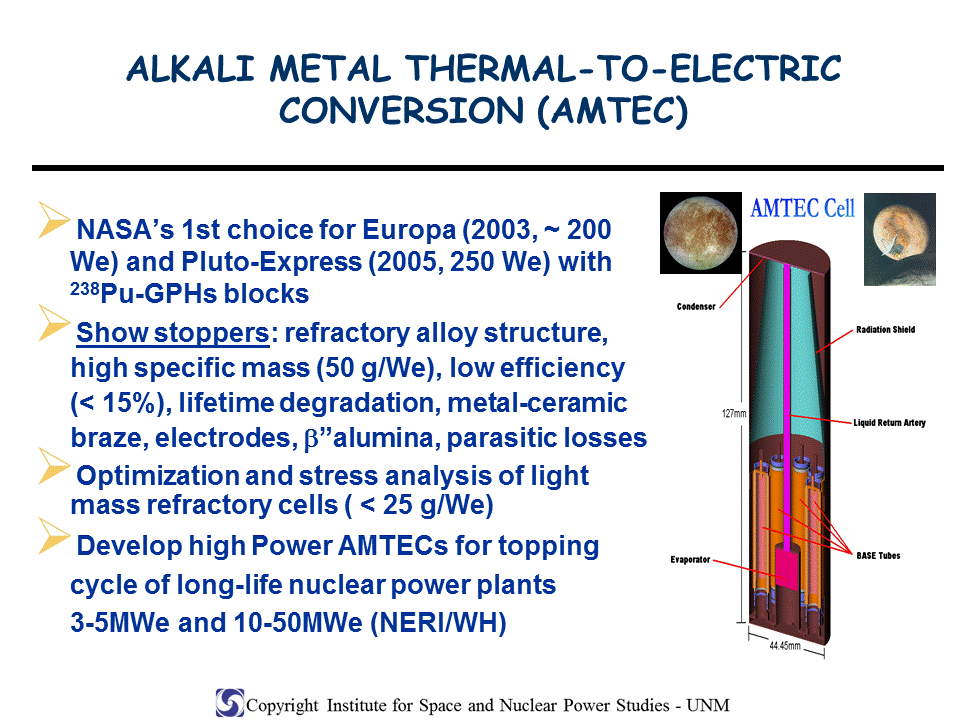
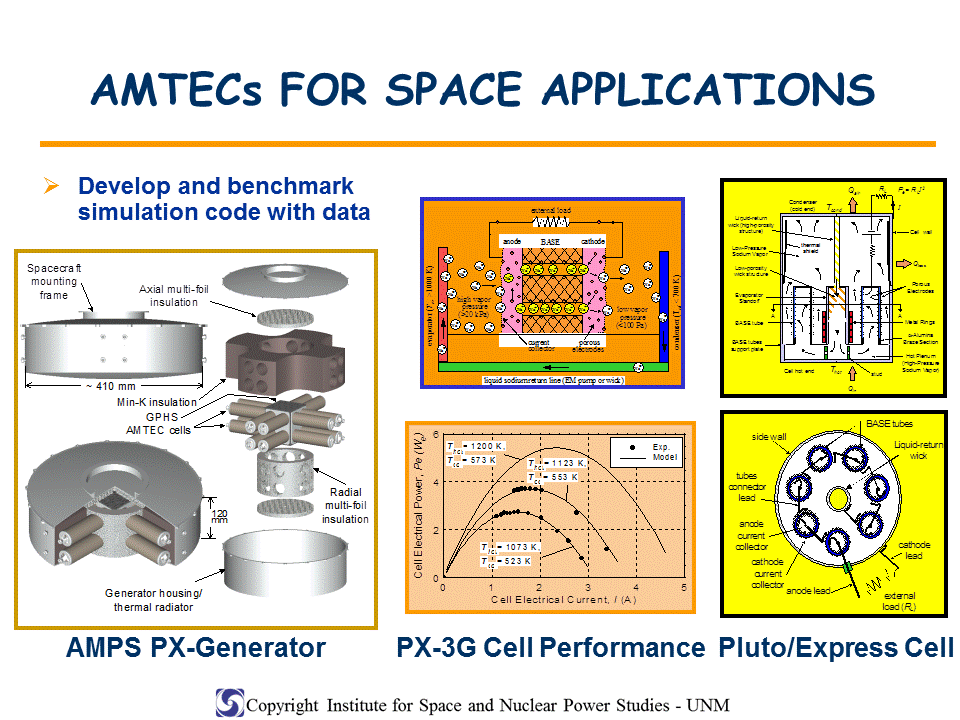

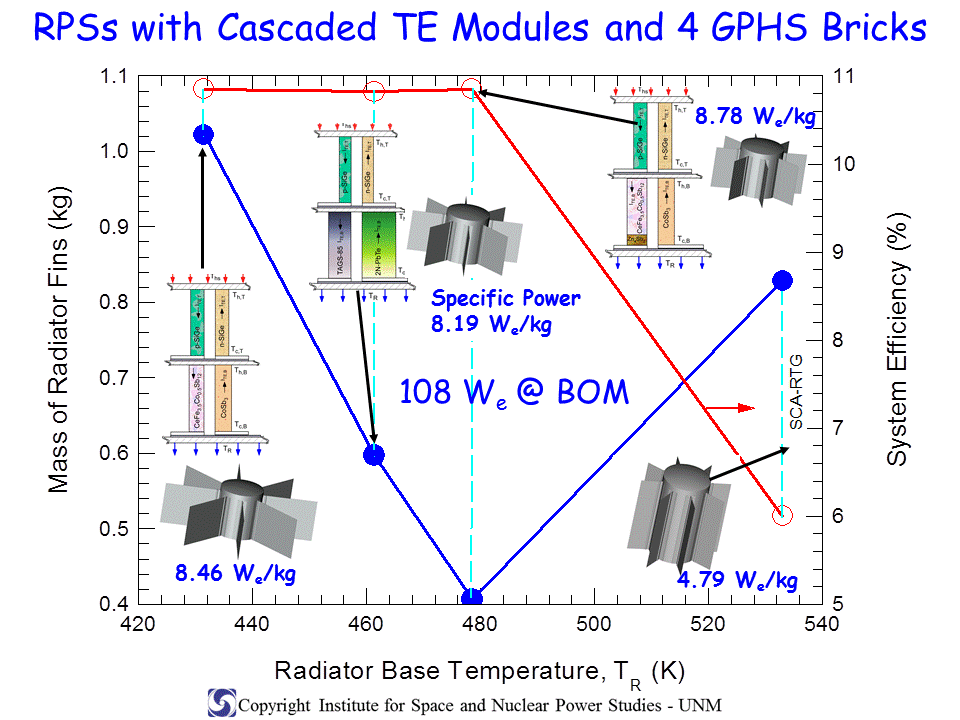
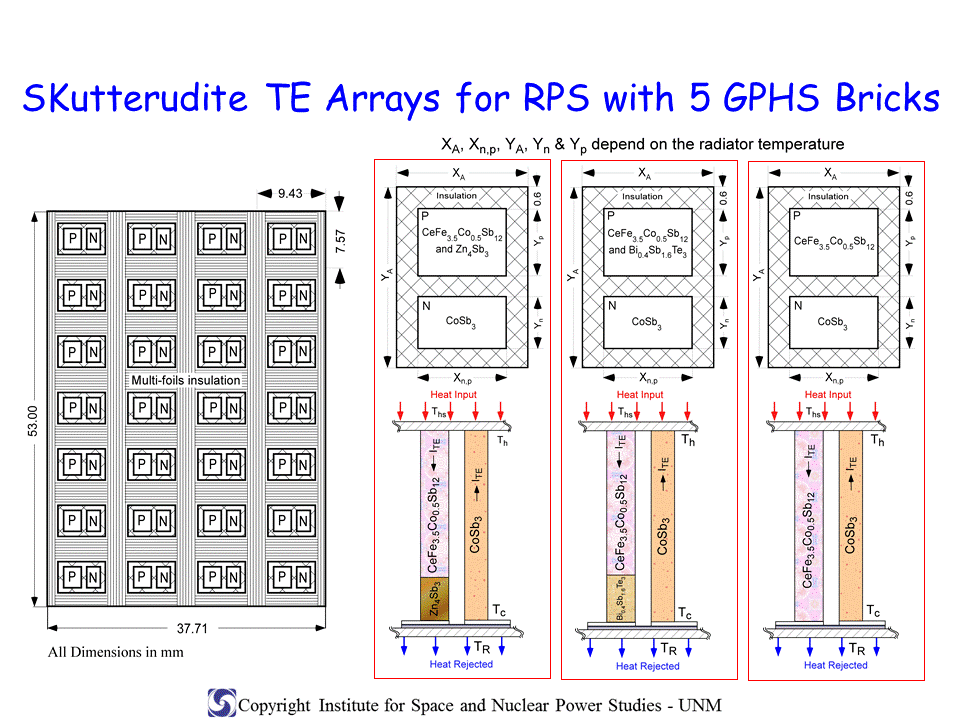
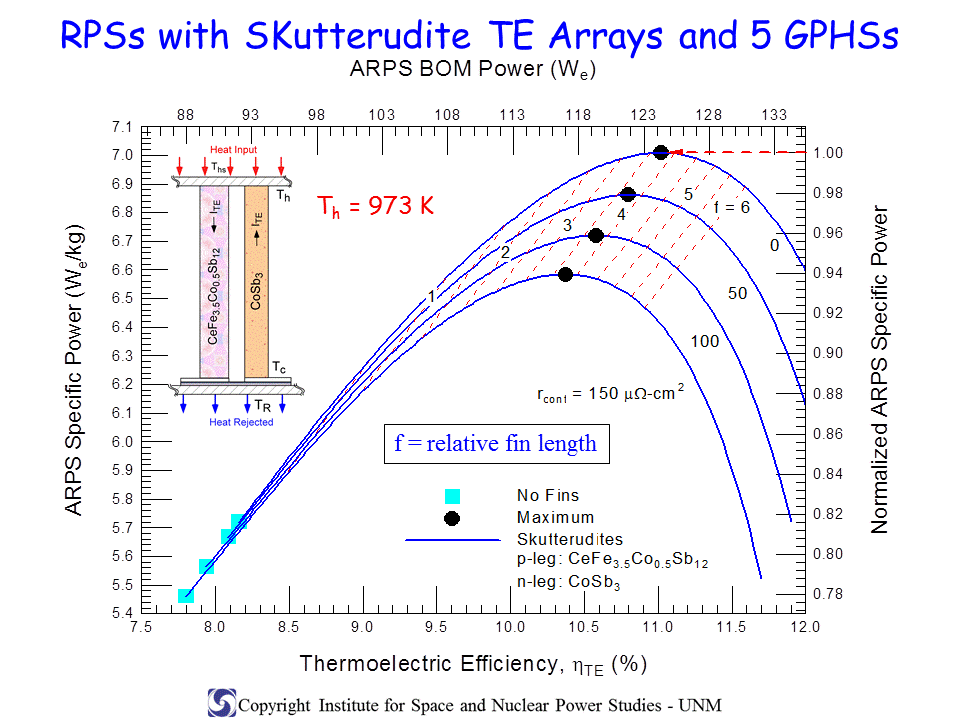
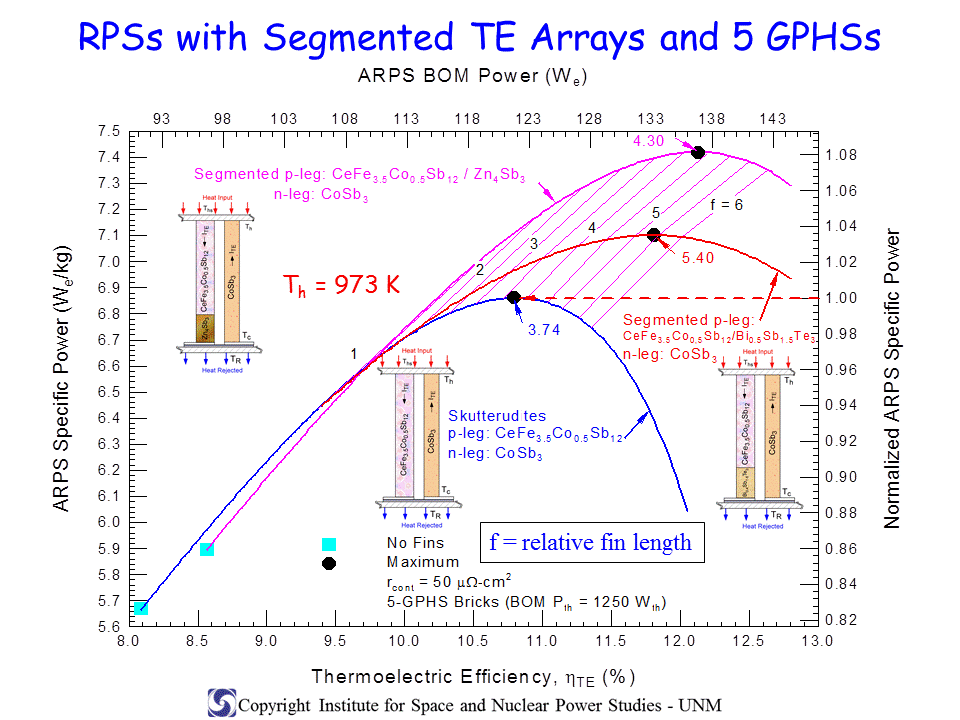
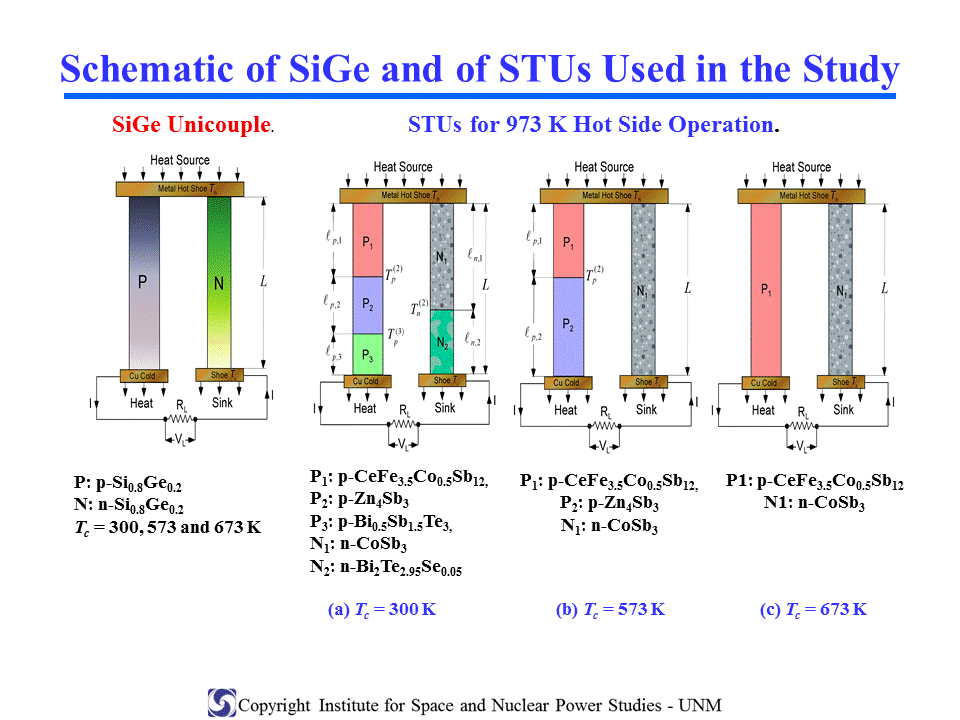 See publications on this topic
See publications on this topic
VII. Terrestrial Nuclear Power
- Nuclear power plant concepts with dynamic and static combined energy conversion

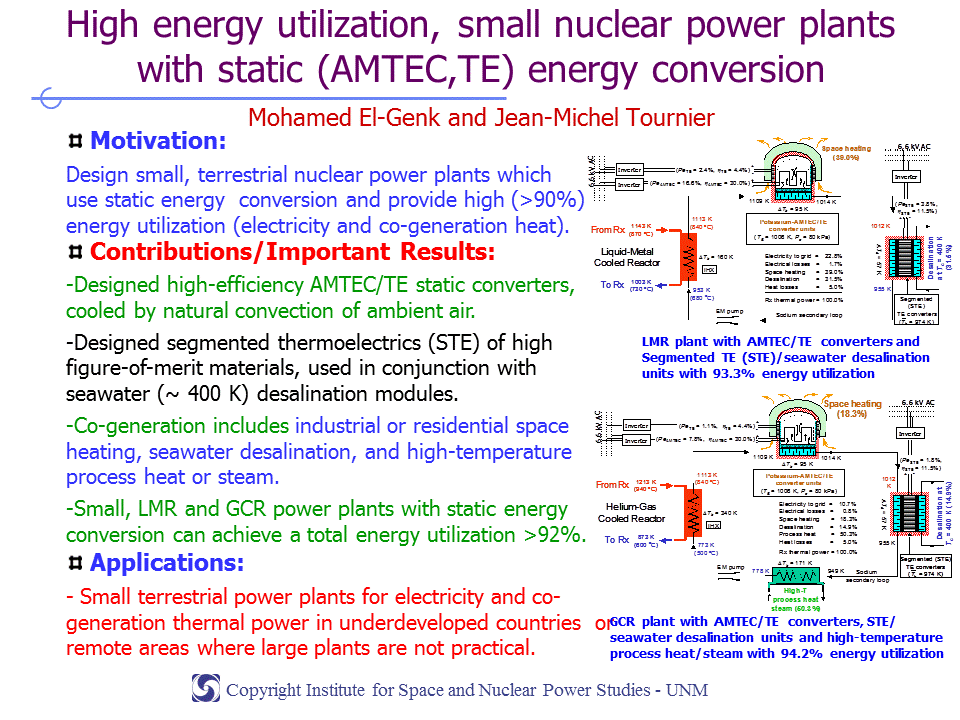

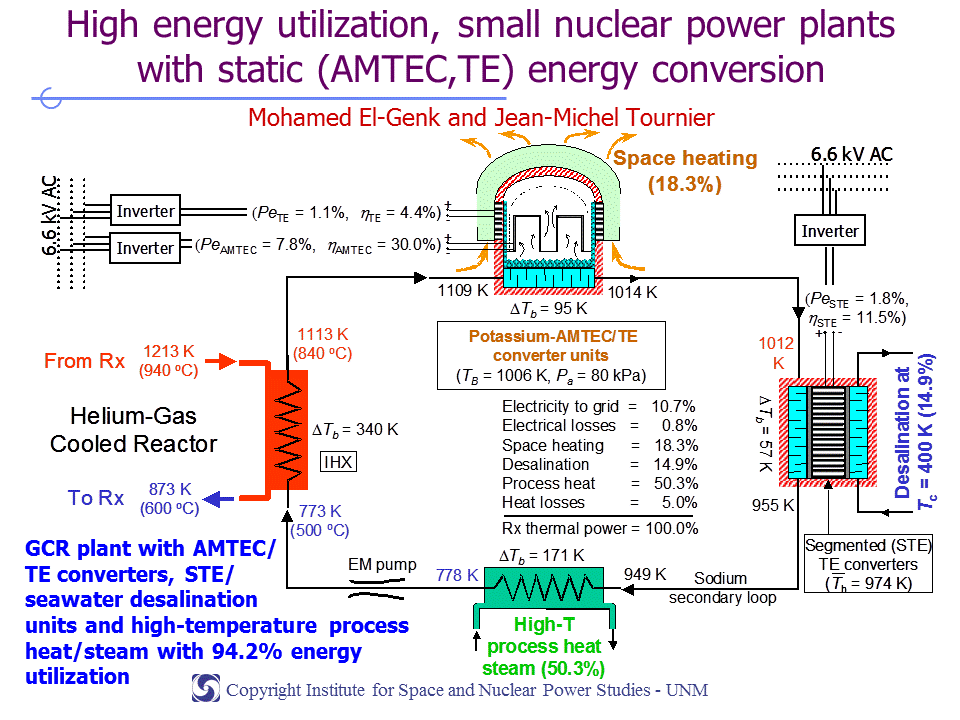 See publications on this topic
See publications on this topic
VIII. Alkali-Metal Thermal-to-Electric Conversion (AMTEC)
- Design, analysis and testing of multi-tube AMTEC cells for space and terrestrial energy applications
- Design and performance of high-power AMTEC units for space reactor power systems




 See publications on this topic
See publications on this topic
IX. Thermoelectric Converters
- High temperature Skutterudites thermoelectrics
- Segmented thermoelectrics
- SiGe/Skutterudites cascaded thermoelectrics for ARPSs
- Performance tests of Skutterudite and Segmented thermoelectric converters

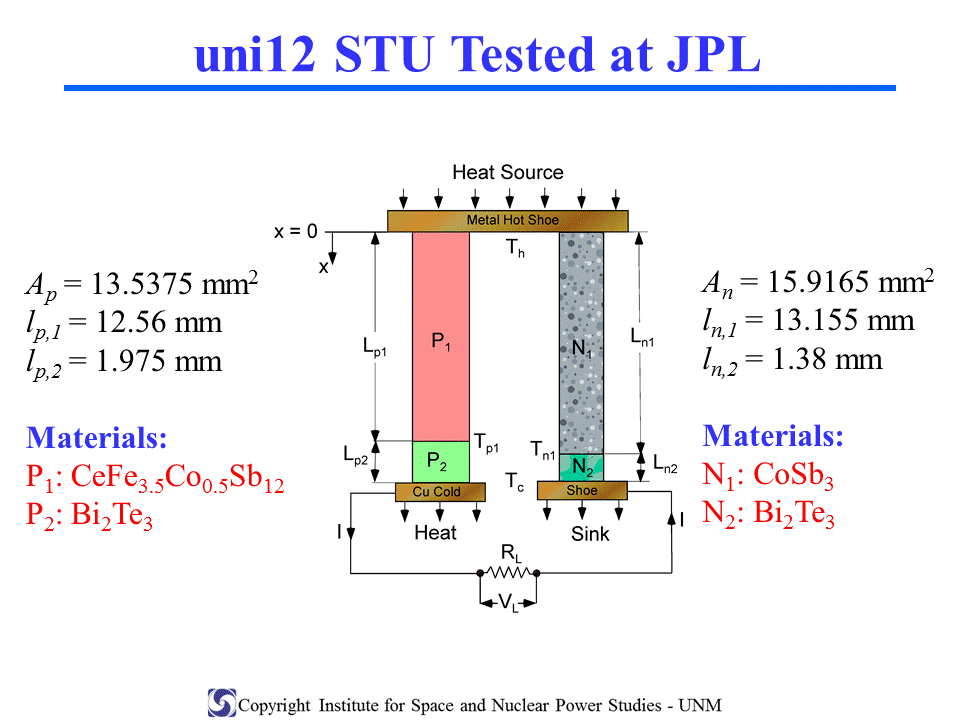
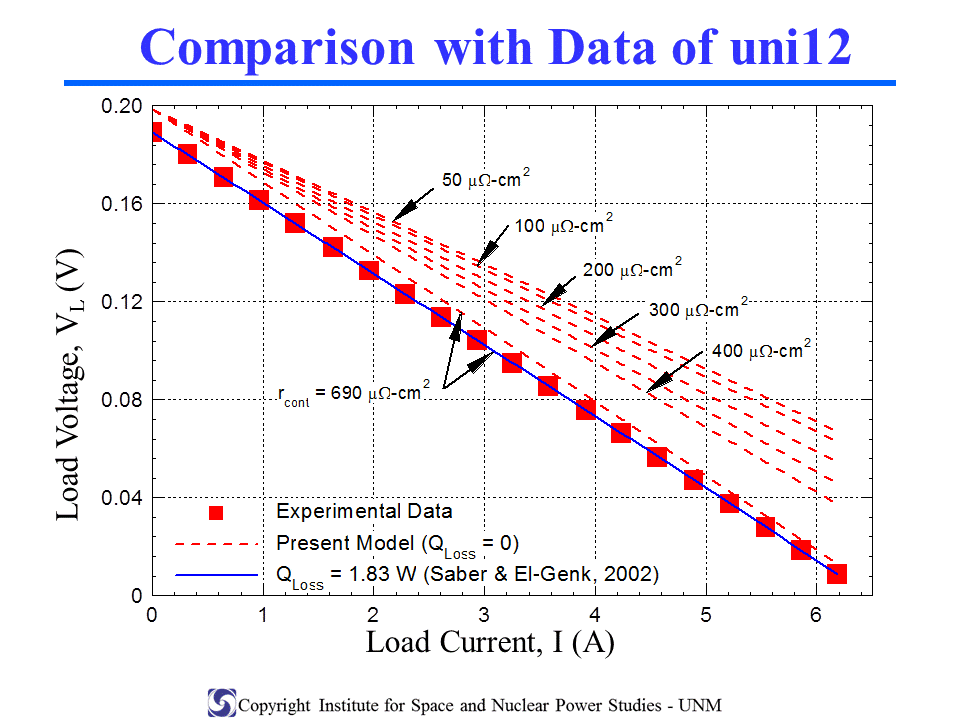
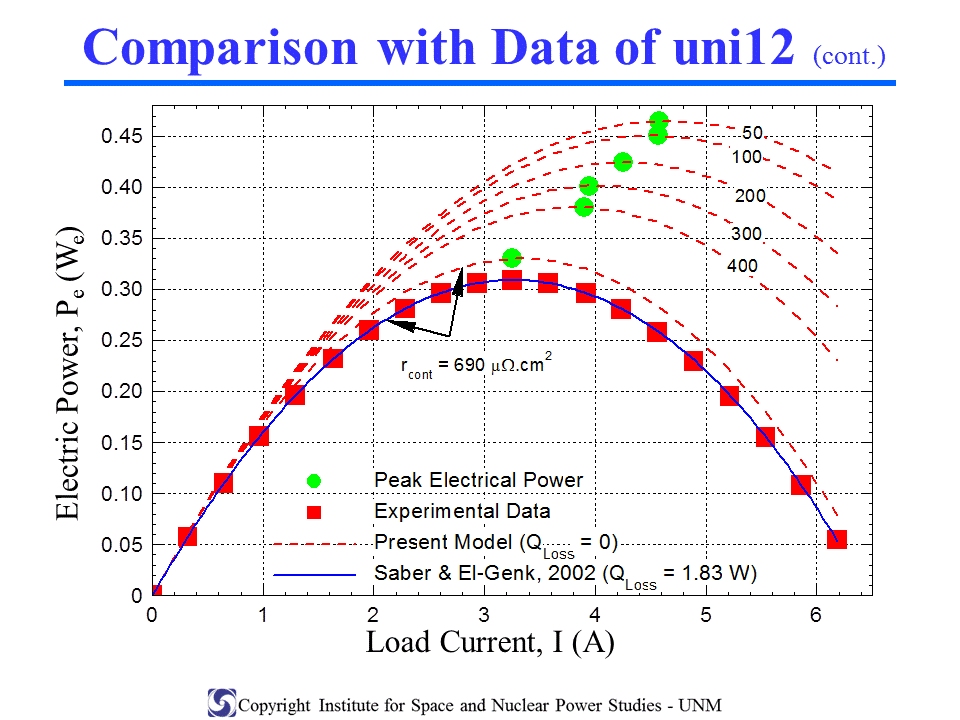
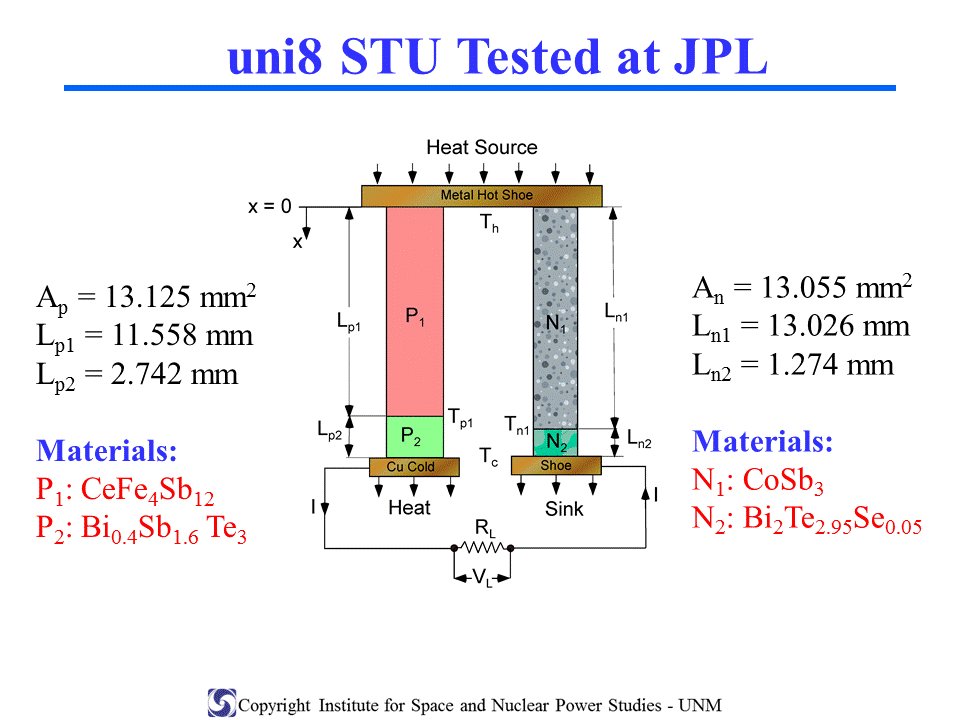
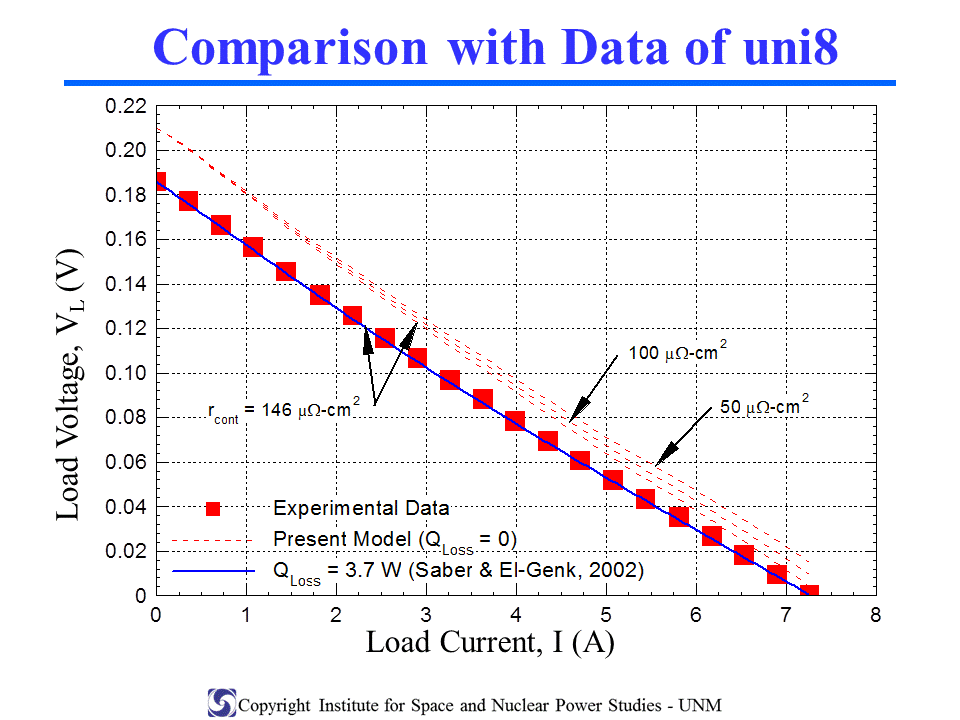
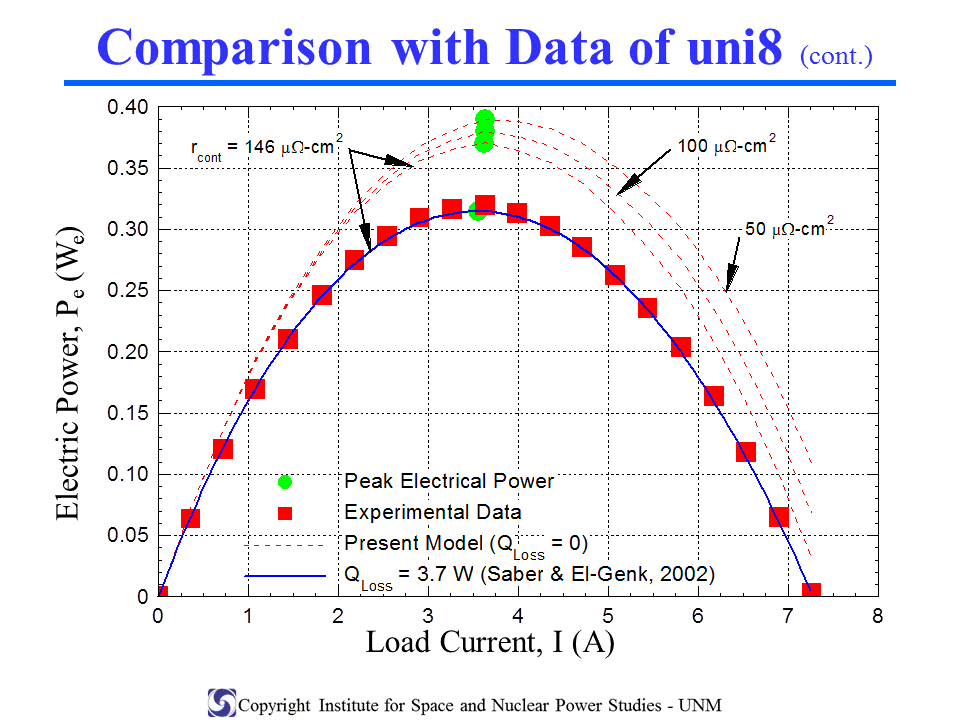
 See publications on this topic
See publications on this topic
X. Thermionic Converters
- Development of grooved thermionic electrodes for high power density
- Experimental testing and modeling of the operation of low pressure Cs-Ba tacitron with application to temperature and nuclear radiation power conditioning
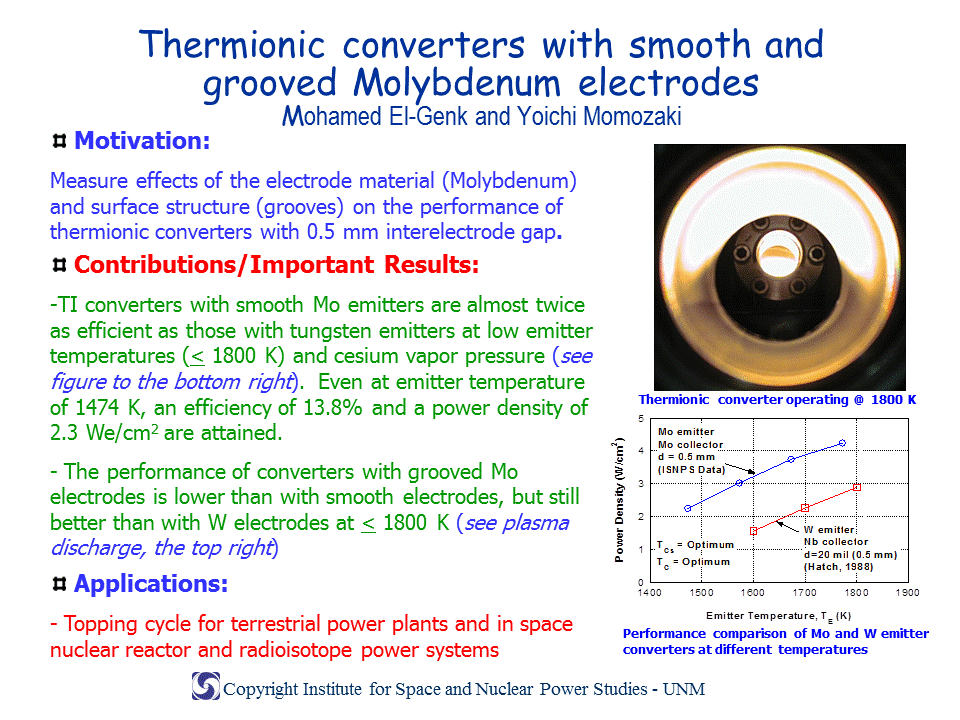

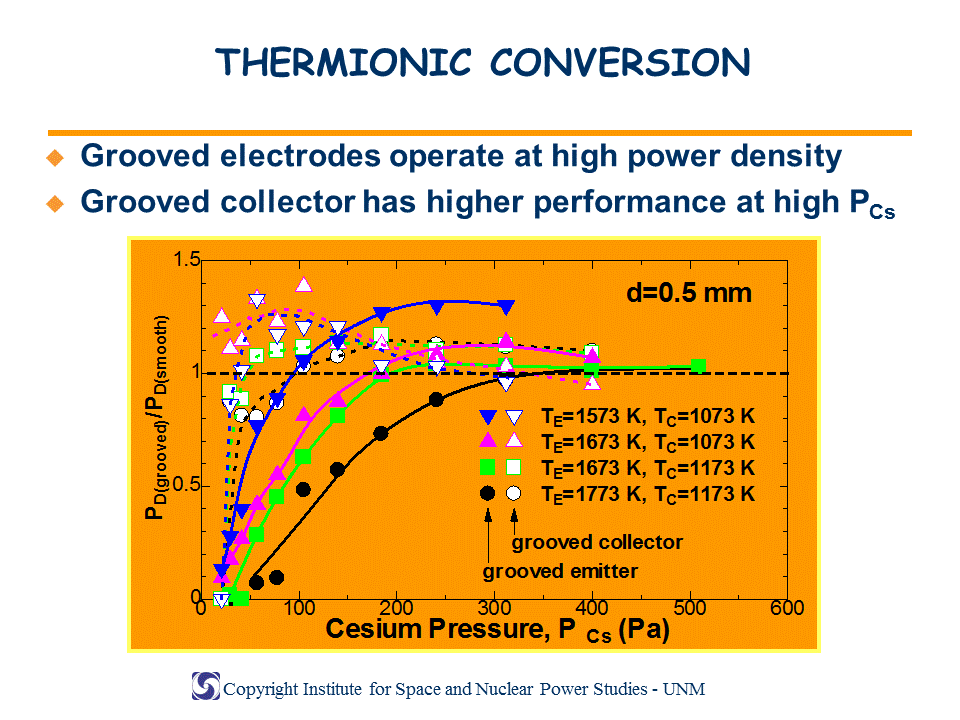

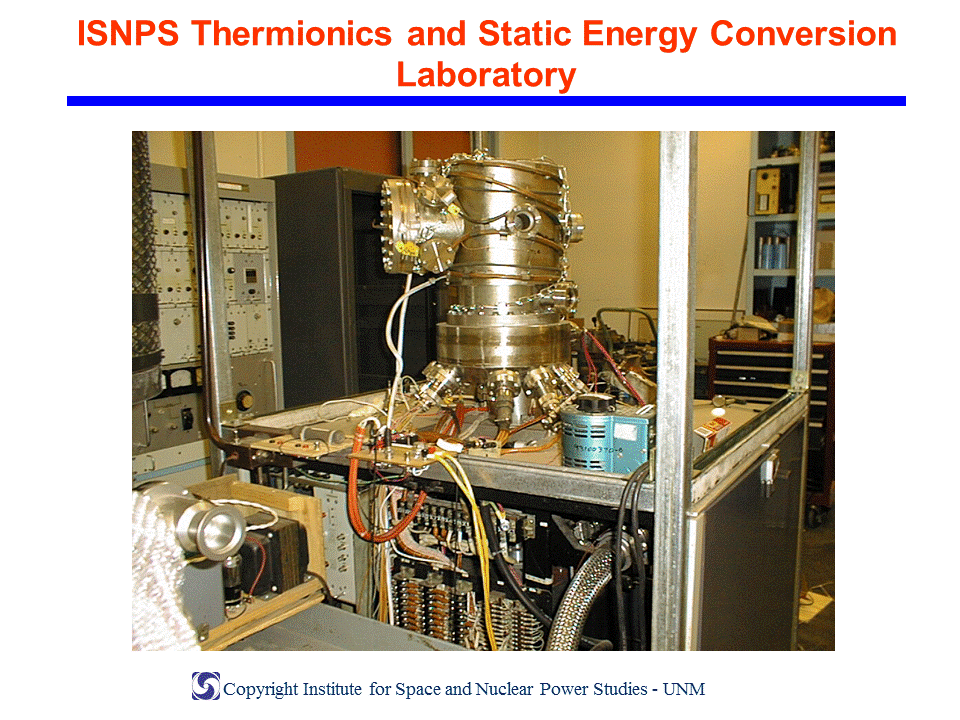
 See publications on this topic
See publications on this topic
XI. Heat Pipe Technology and Thermosyphons
- Experimental and modeling of the transient operation of heat pipes including the start-up from a frozen state
- Design, performance and operation limits of heat pipes, including the start-up from frozen state
- Design and testing of low temperature heat pipes
- Design, performance and operation limits of thermosyphons
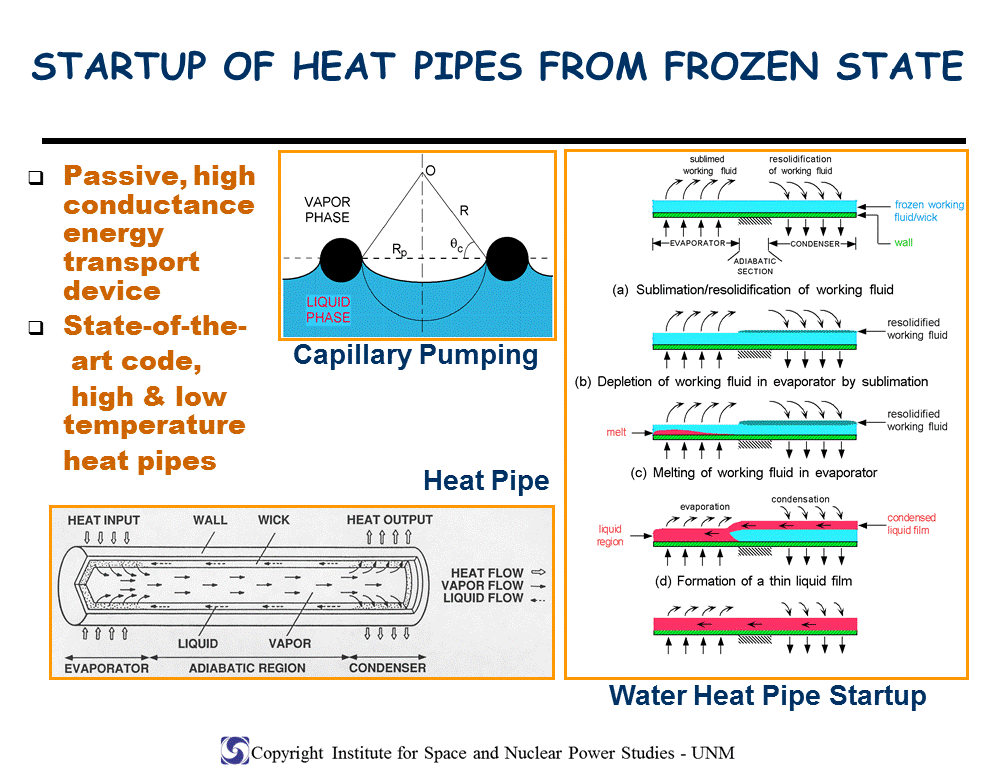
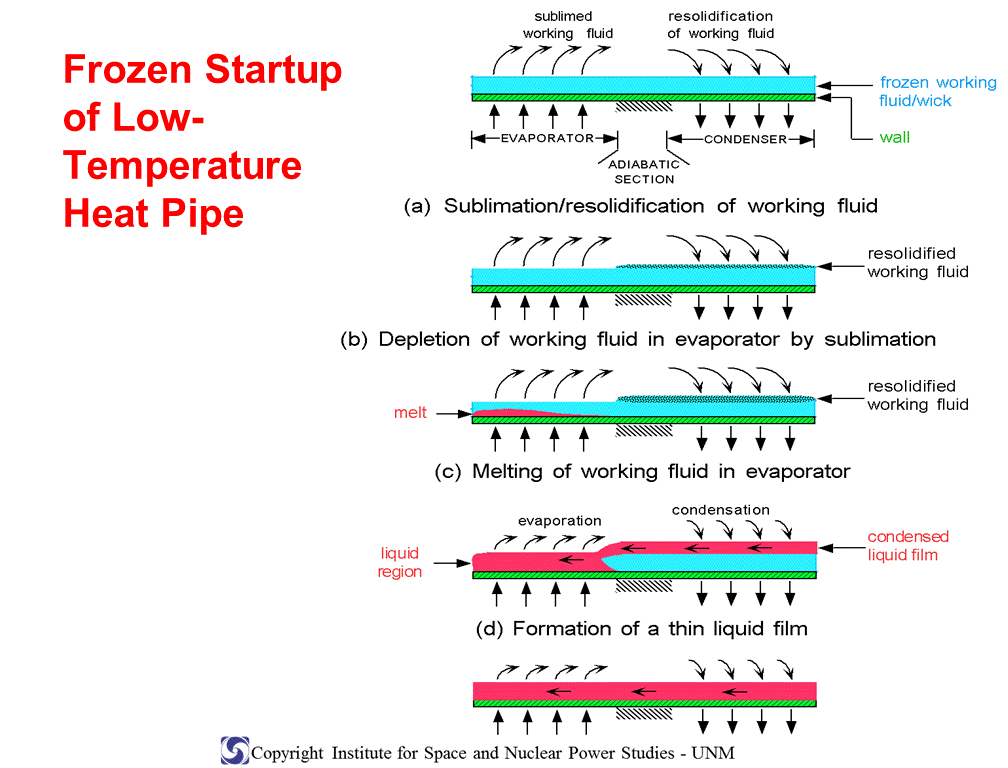


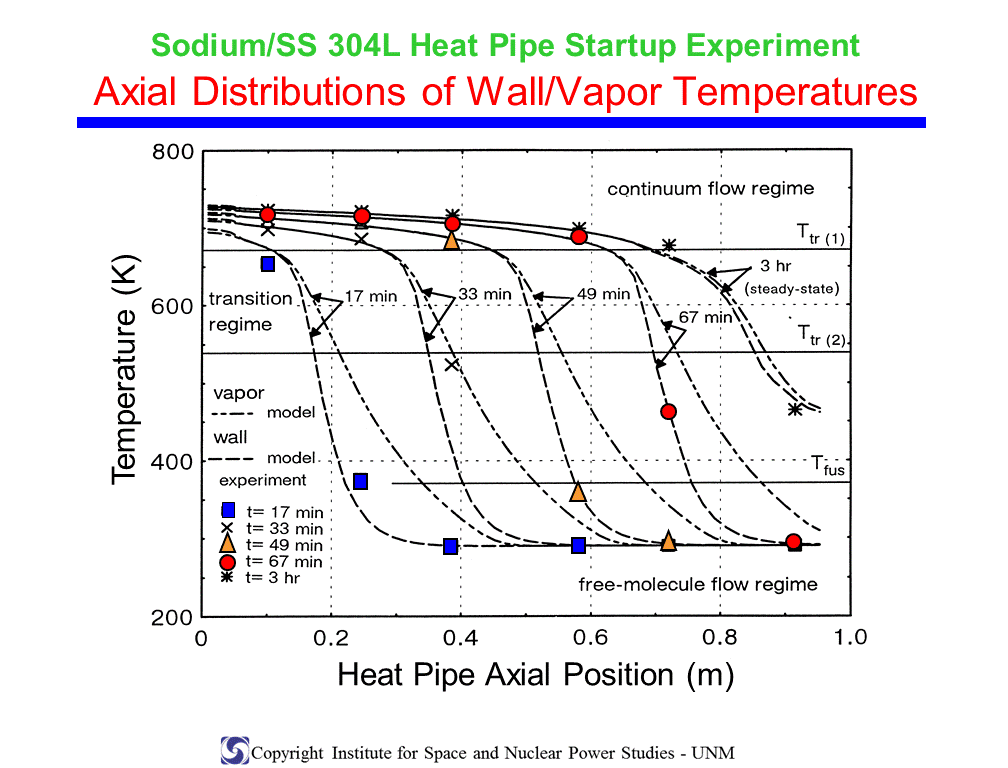
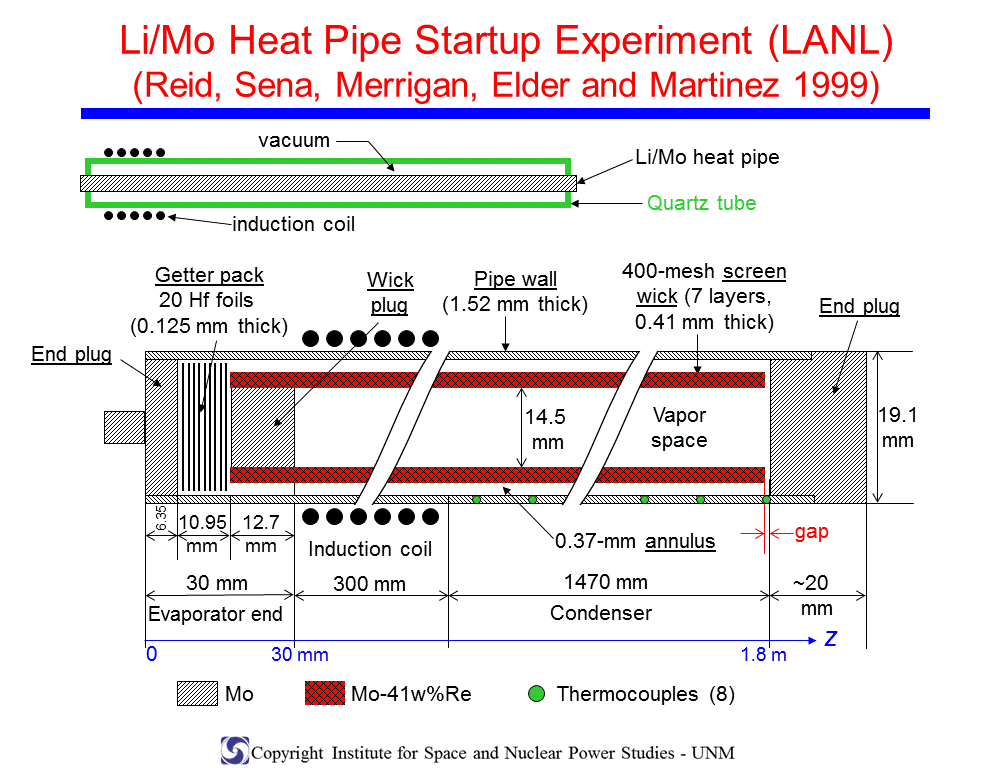
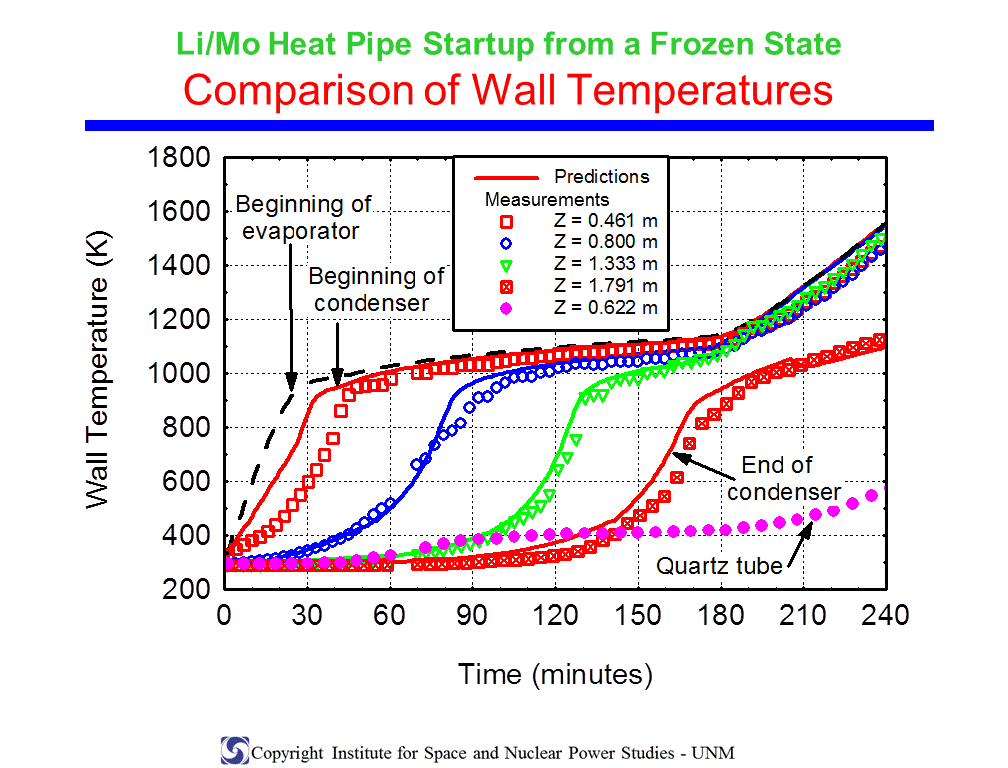

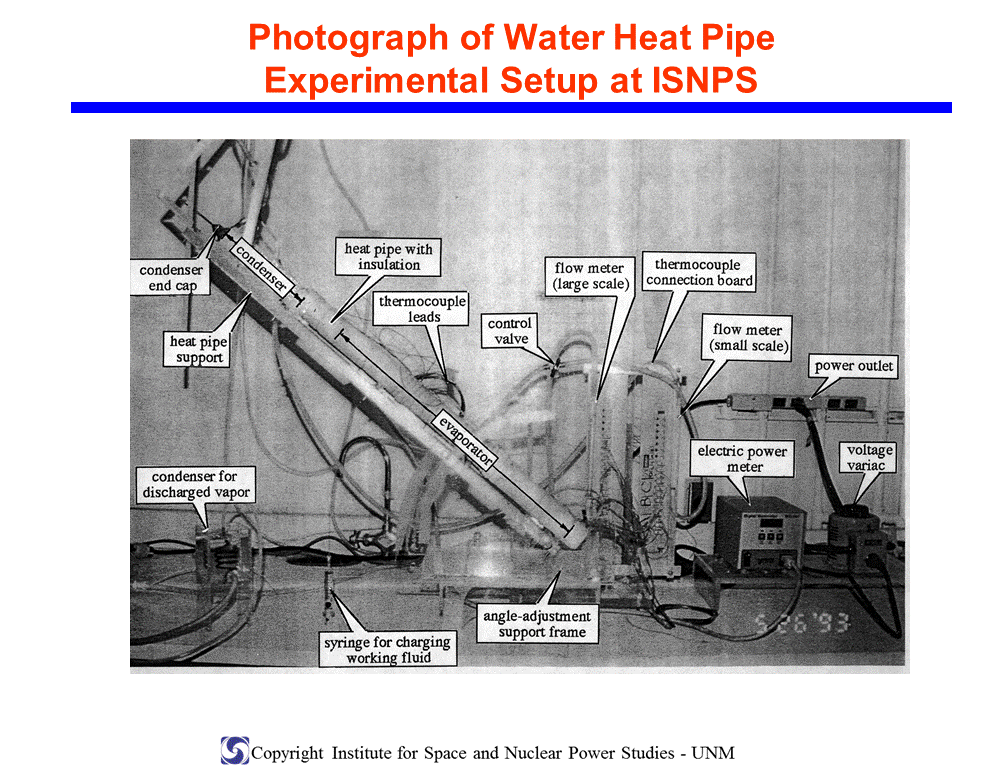
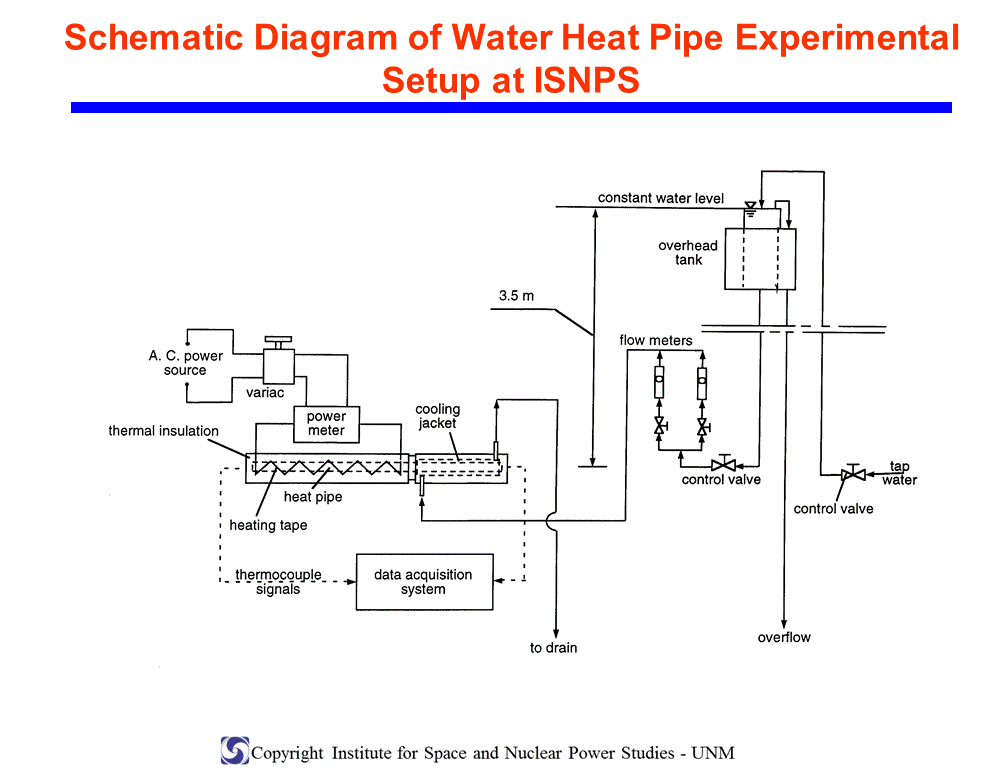
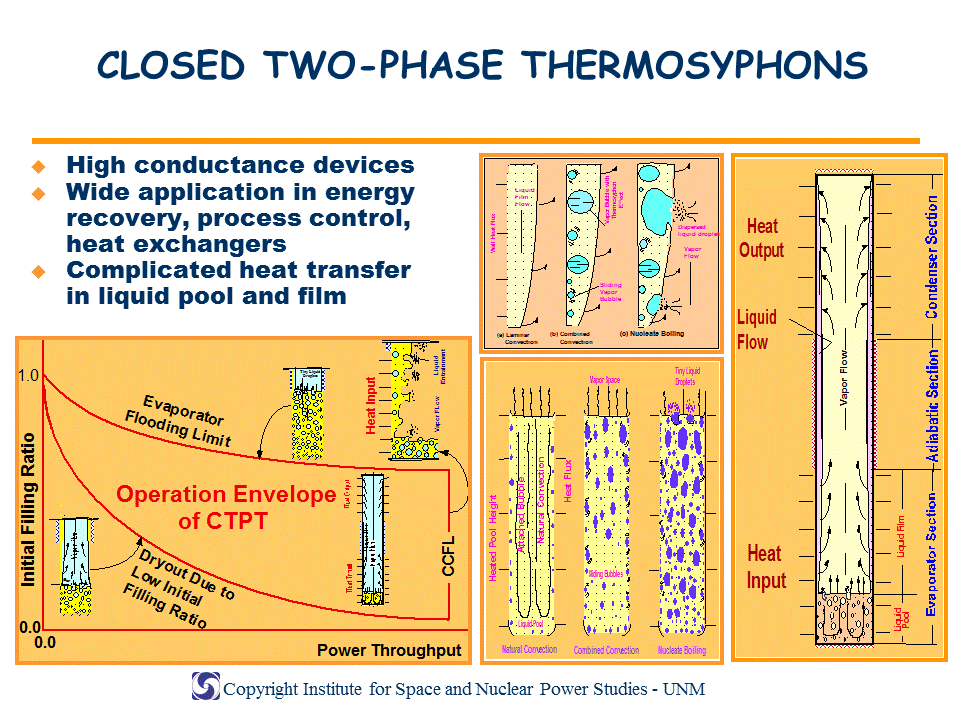
 See publications on this topic
See publications on this topic
XII. Boiling Heat Transfer
- Boiling heat transfer experiments and correlations
- Microlayer evaporation and its effect on nucleate boiling heat transfer
- Flow visualization and high-speed bubble motion studies near critical heat flux
- Effect of material properties and curvature on pool boiling from downward-facing curved surfaces in saturated and subcooled water
- Boiling of dielectric fluids for electronic microchips cooling
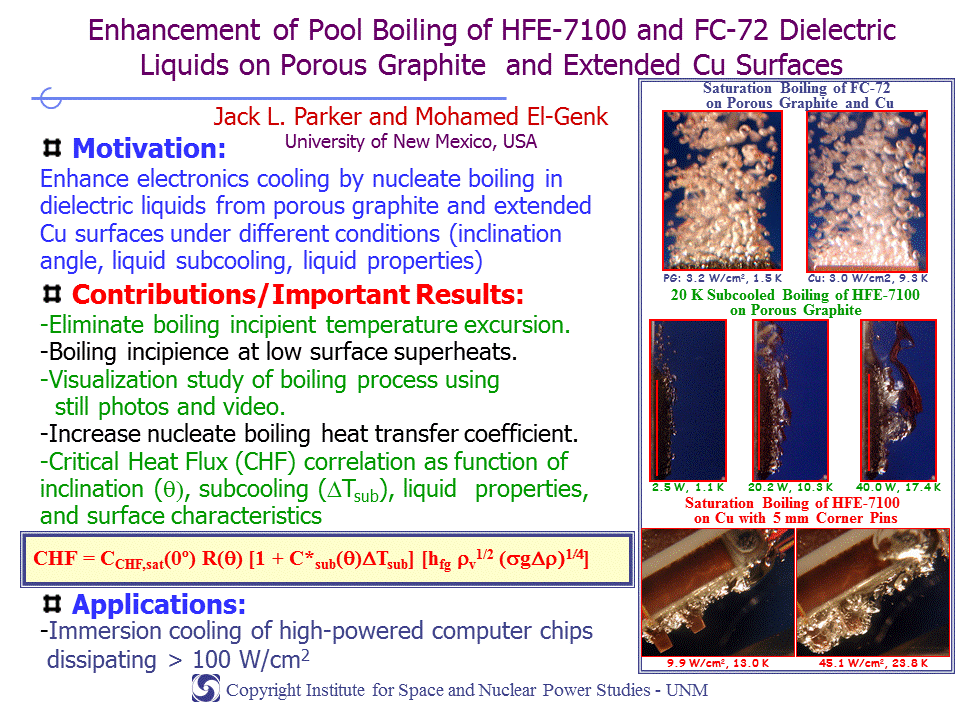
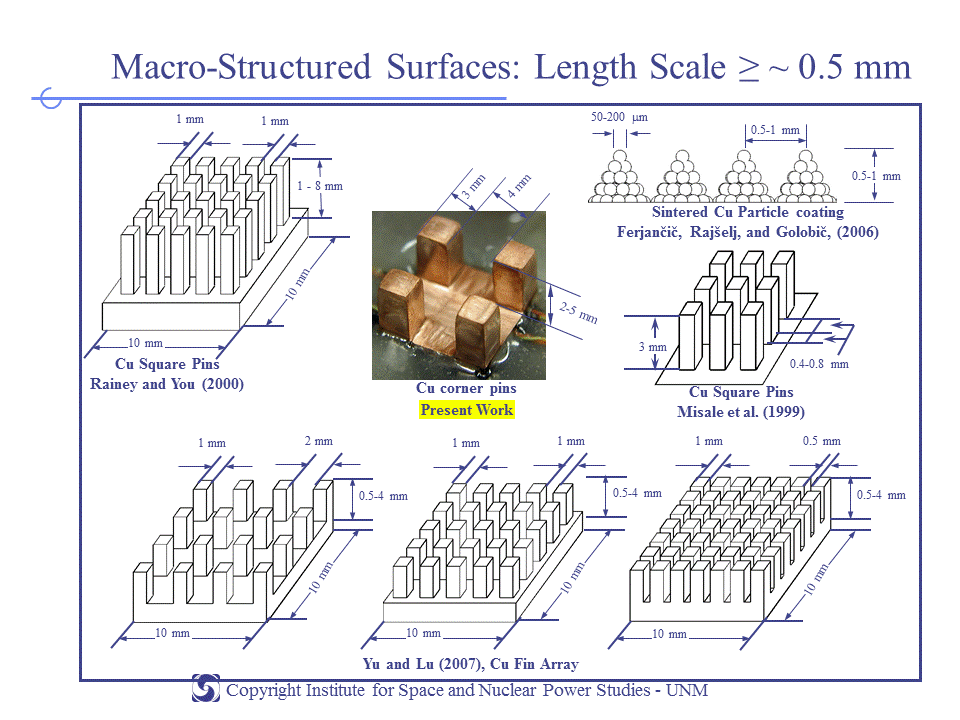
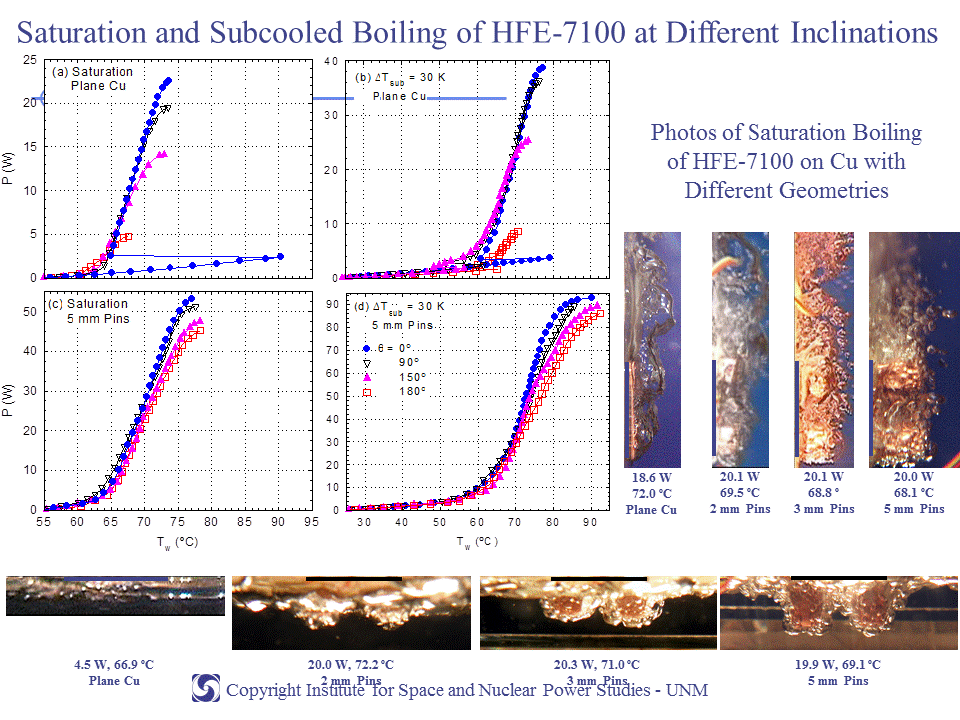
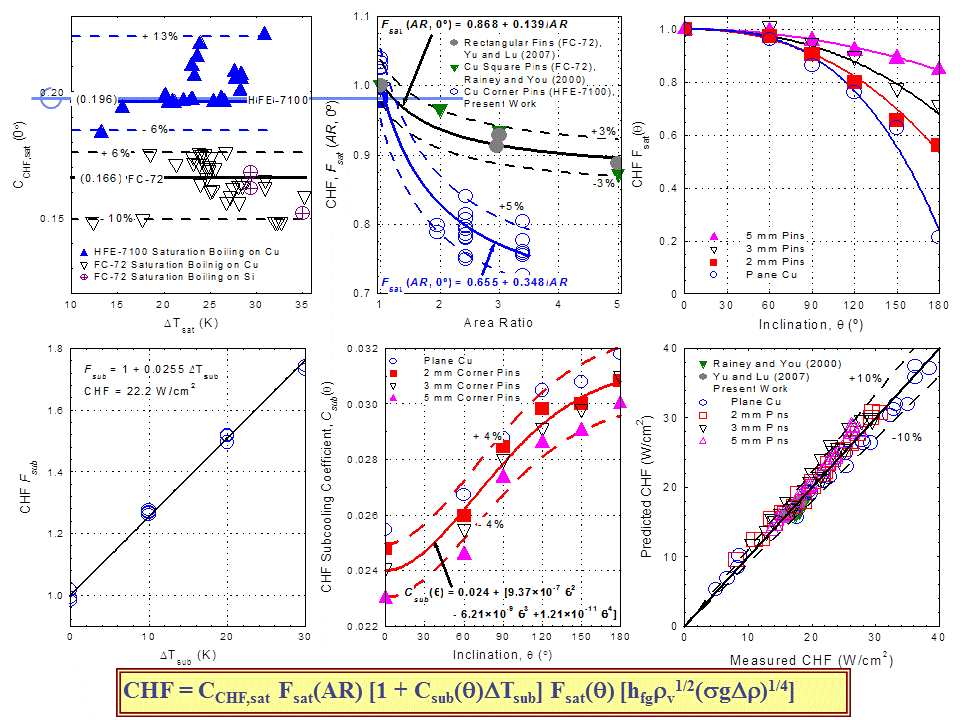


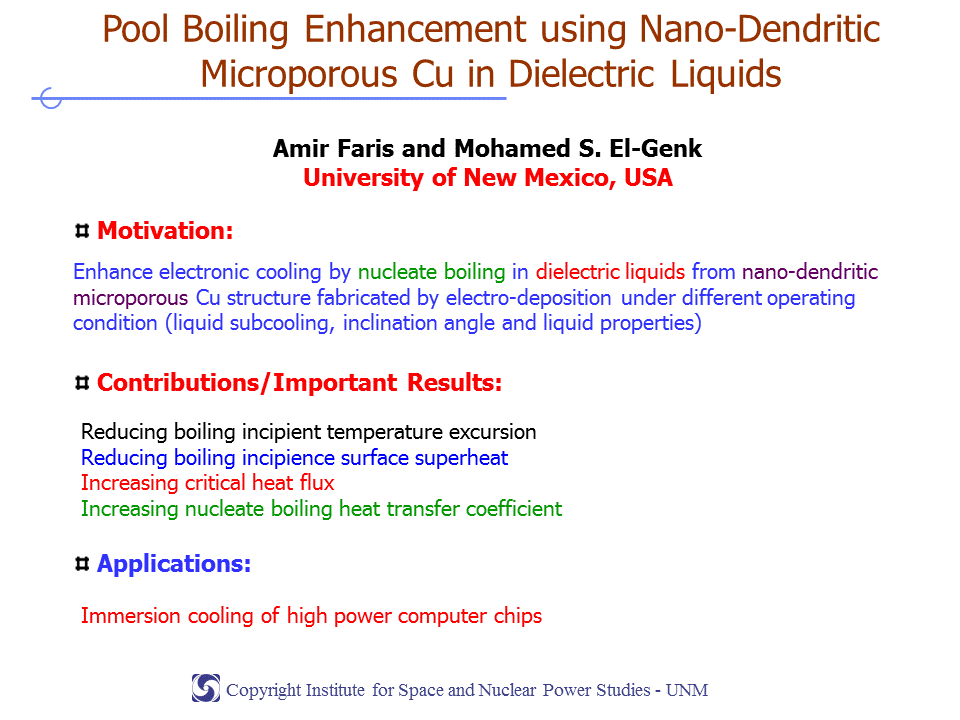

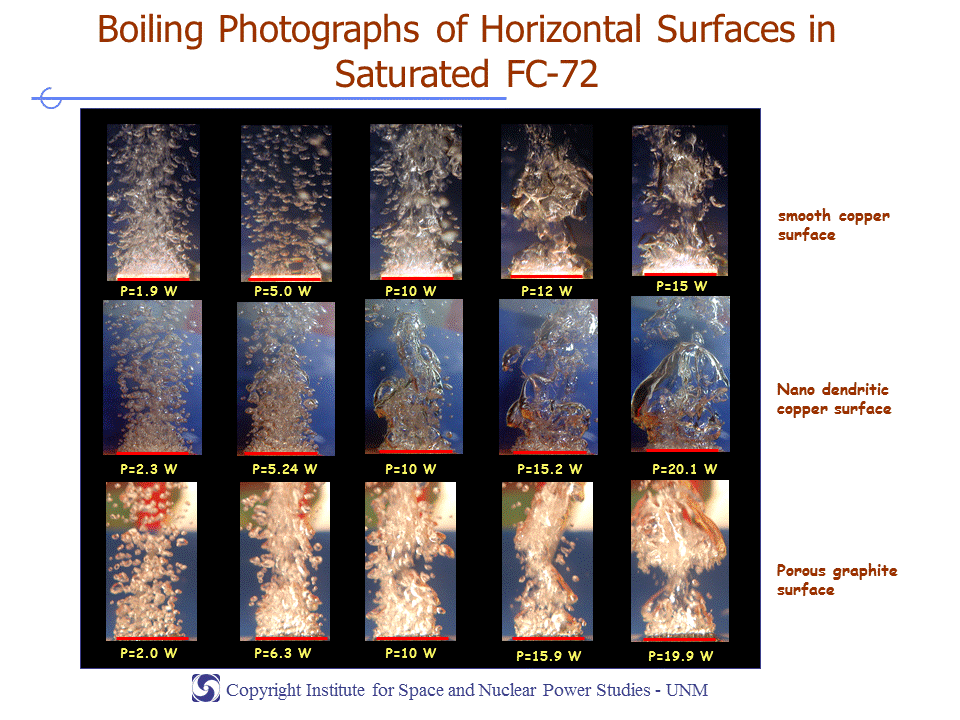
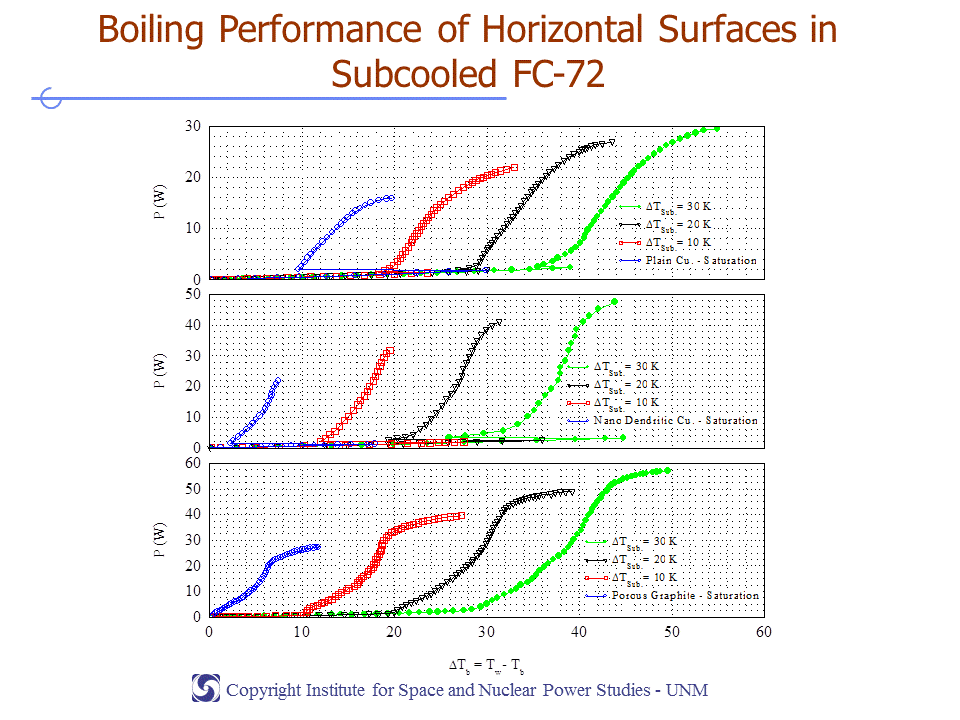

 See publications on this topic
See publications on this topic
XIII. Immersion Cooling of High-Power Electronics
XIV. Convective Heat Transfer
- Convection heat transfer experiments and correlations
- Natural convection and application to electronics cooling
- Marangoni convection and phase-change in microgravity
- Heat transfer in porous media and thermal energy storage modules
- Application of laser interferometry to flow visualization and heat transfer in natural convection of air
- Enhanced cooling using impinging and swirl air jets
- Natural convection of air at high temperatures
- See publications on this topic
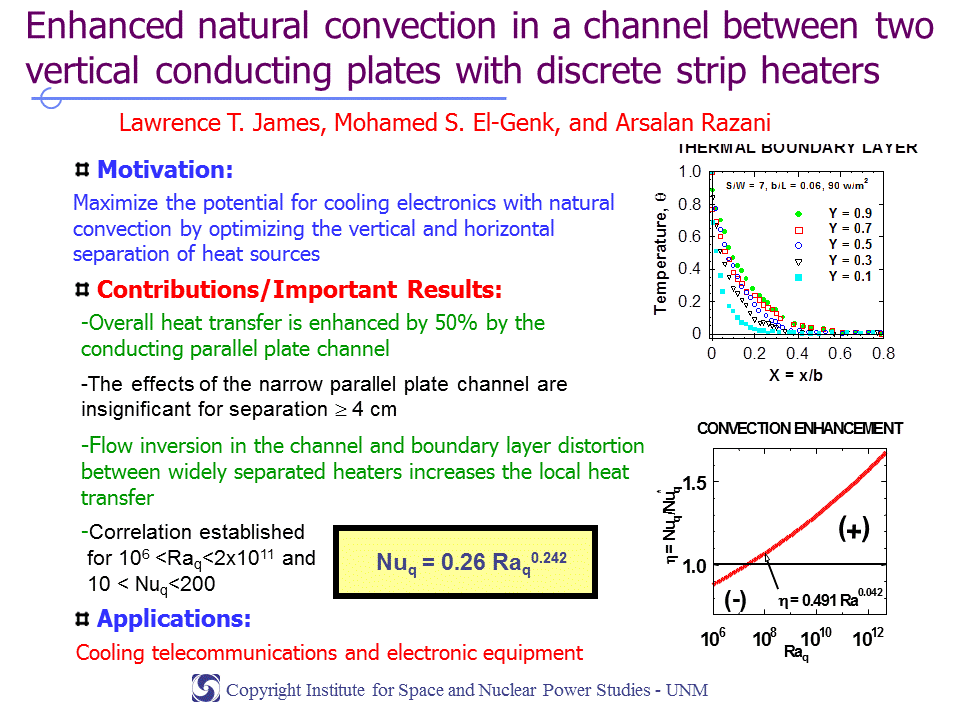
XV. Radioactive and Mixed Waste Treatment
- Interaction of colloids with gas/liquid interface
- Chemical reversibility of chemical reaction between colloids and contaminants
- Effect of pH and ionic strength on colloids stability
- Plasma hearth process and application to the treatment of mixed, chemical and radioactive waste
- Irreversibility of reactions between colloids and actinides at different cations concentrations
- Effect of subsurface colloids on hydraulic characteristics of porous media
- Applicability of filtration theory and correlations to shallow subsurface transport of colloids
- Attachment kinetics of colloids to gas bubbles in subsurface environment
- RF plasma for decontamination of transuranic elements
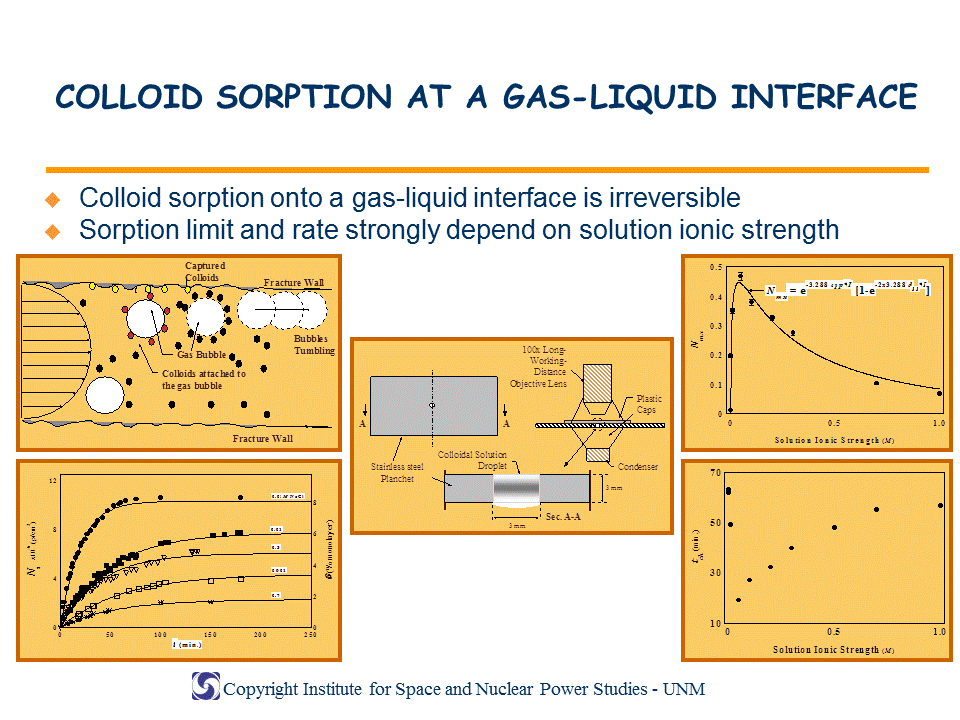
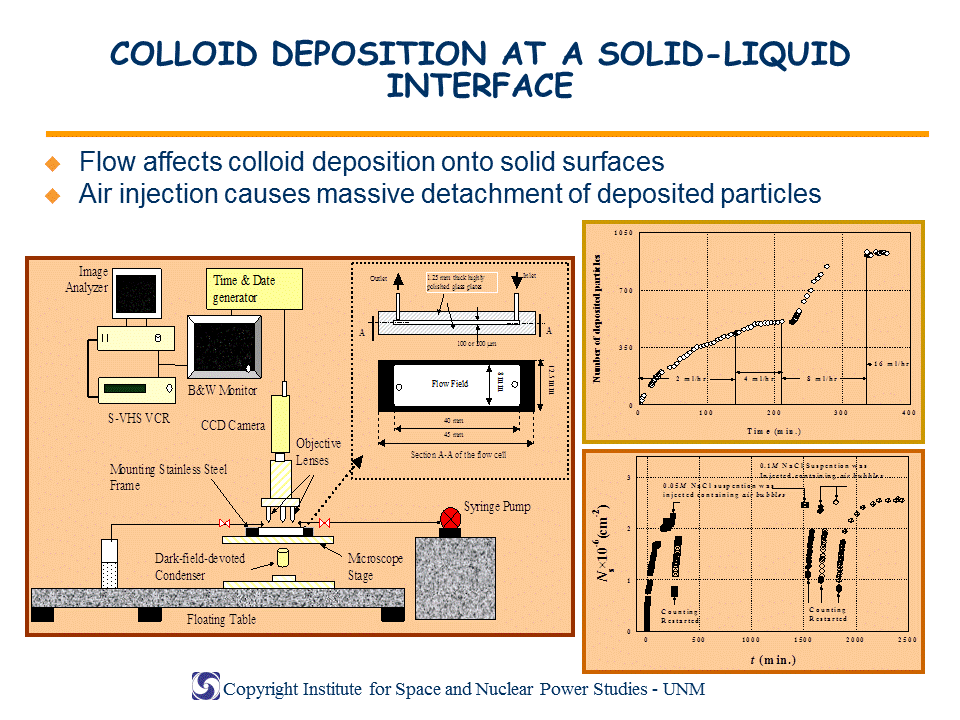
 See publications on this topic
See publications on this topic
XVI. Dynamic Energy Conversion
XVII. Flow in Microchannels and Microtubes/Microfluidics
IVIII. Shielding Solar Energetic Particles
- Interactions of High Energy Solar Protons with Potential Shielding Materials
- Displacement Damage Dose in Silicon with Different Shielding Materials
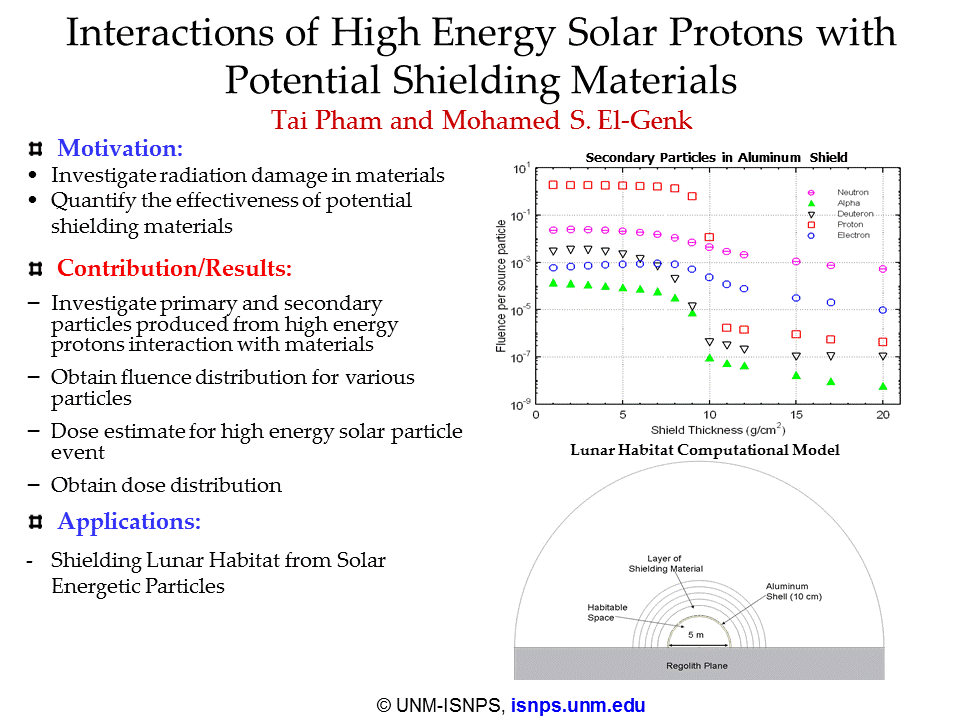
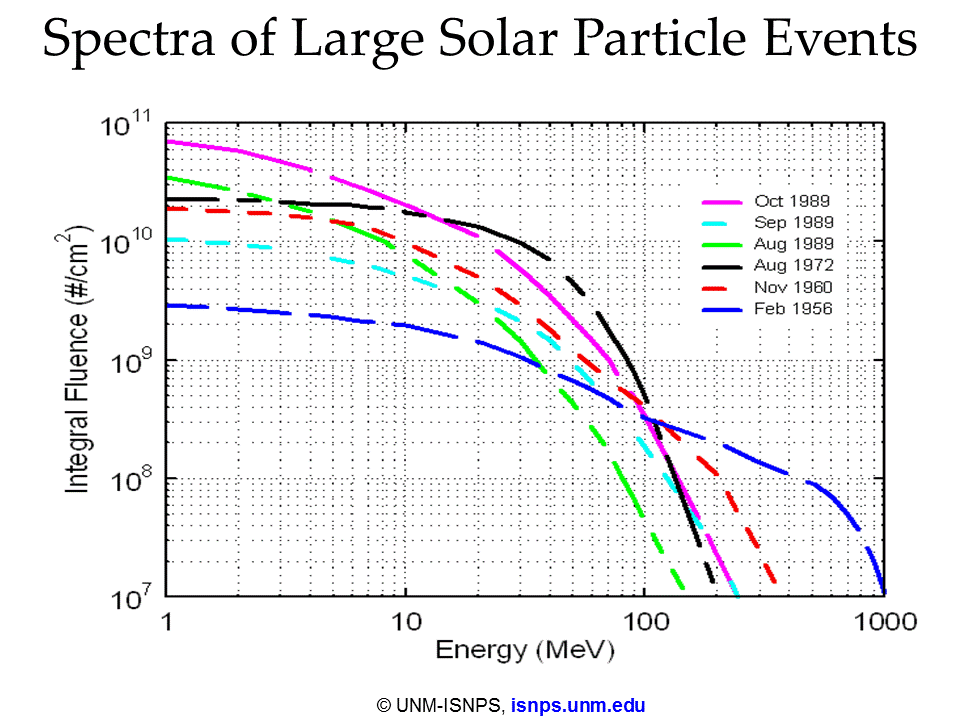
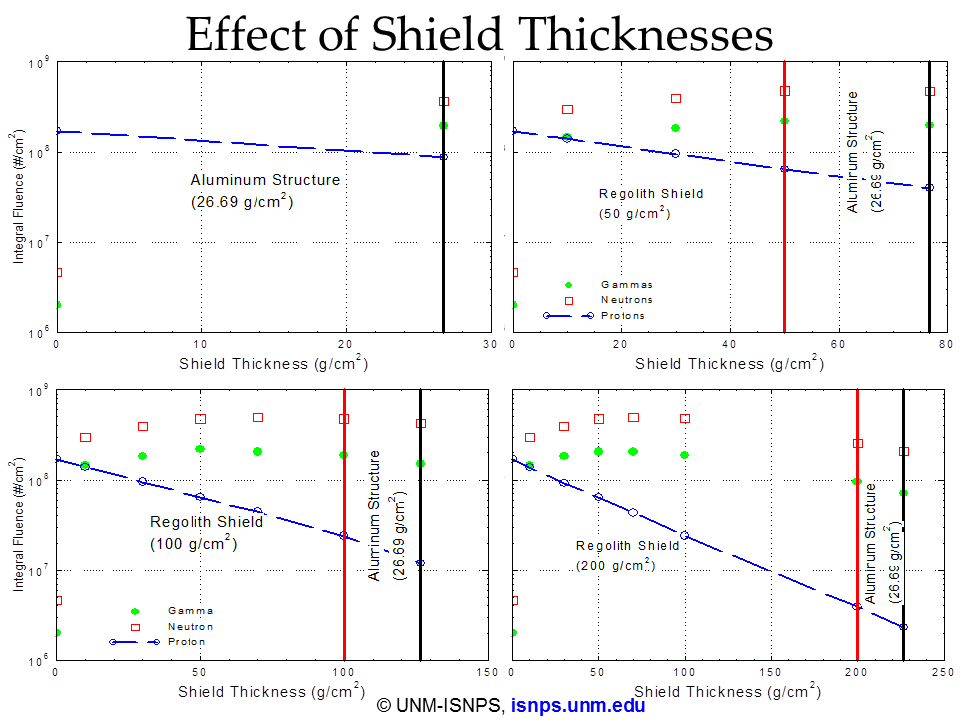
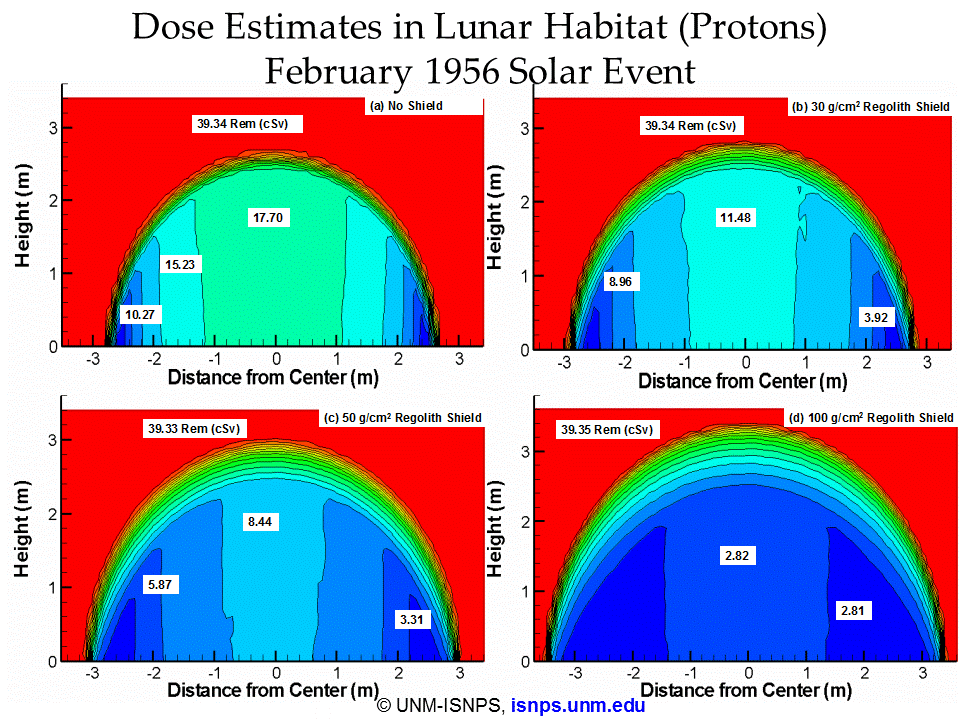
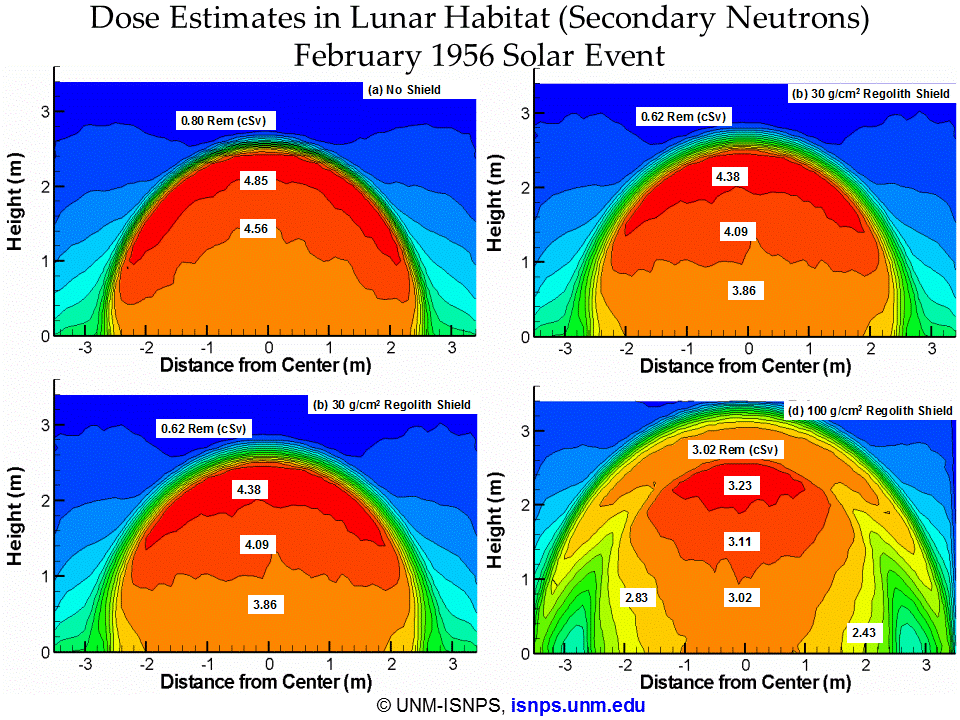
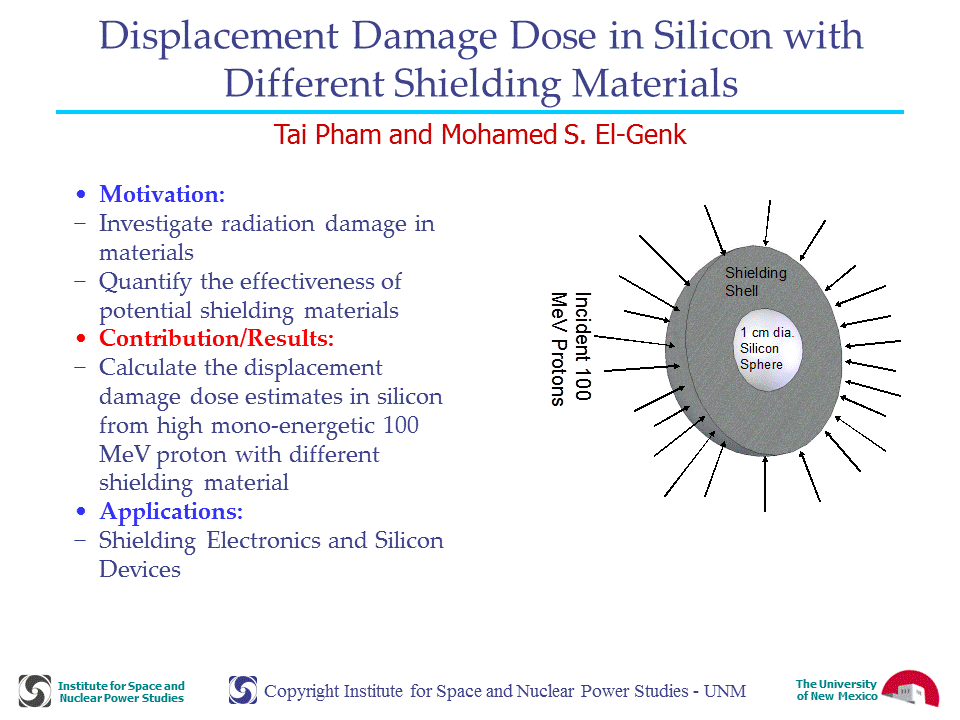
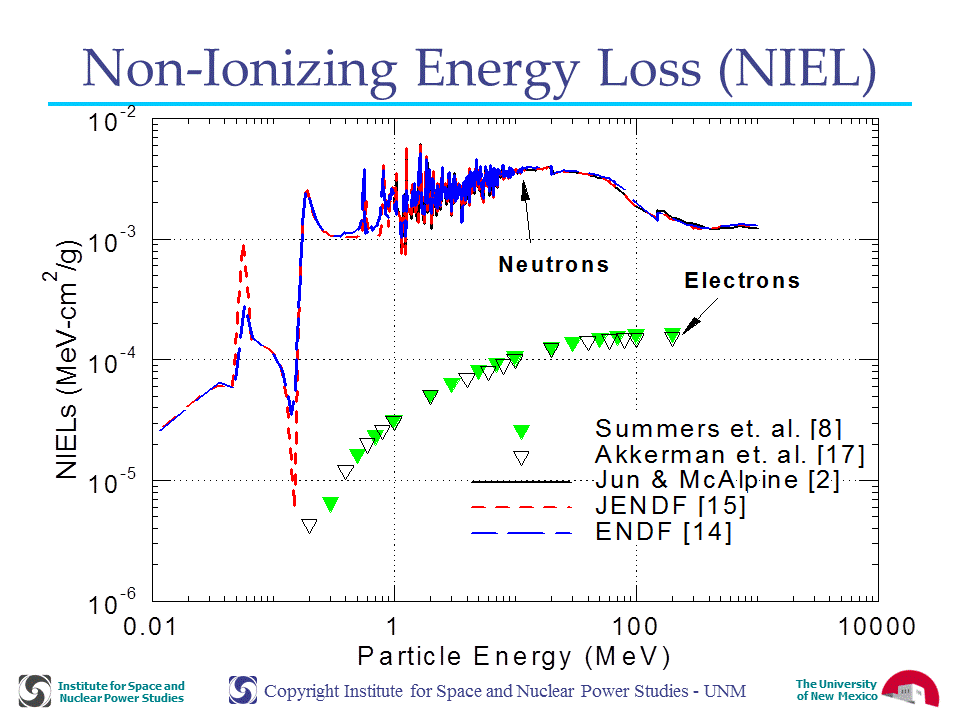
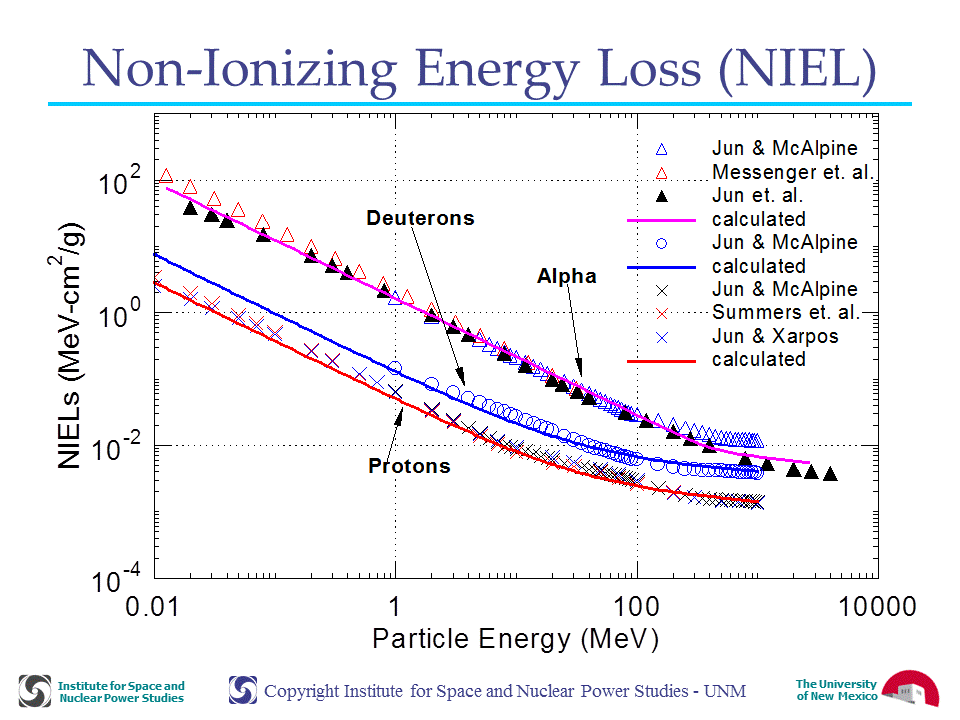

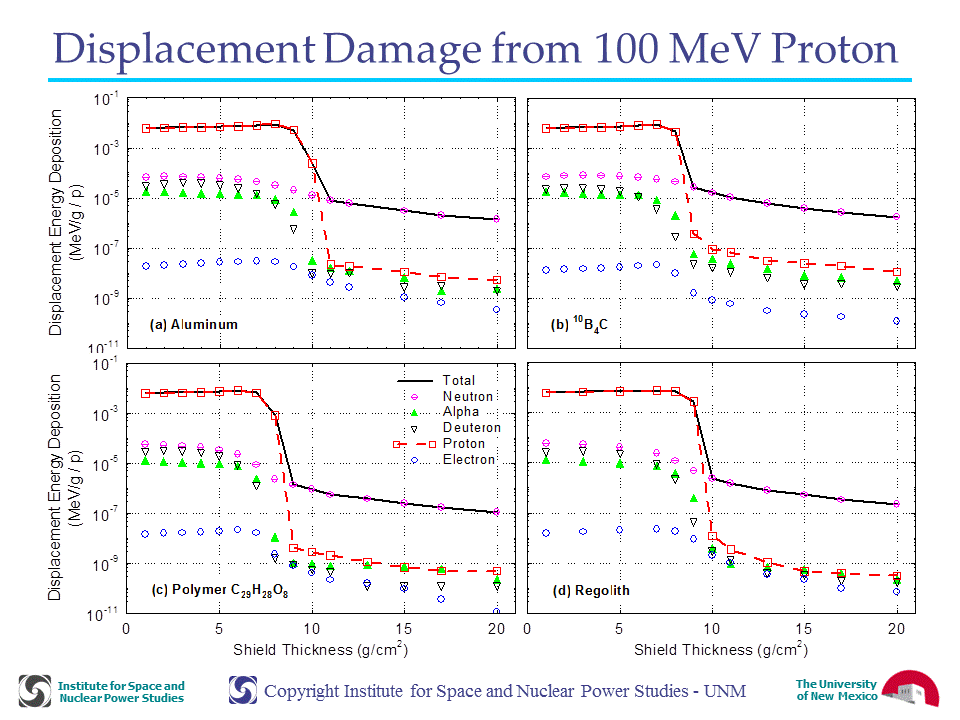 See publications on this topic
See publications on this topic
XIX. Very High Temperature Reactor (VHTR) Plants
XX. Neutronics
 Back to The Top
Back to The TopRecent Publications
Below are our ten most recent publications. You may view the rest by browsing our publications
by year, by author, or by topic.
- El Genk, M.S., T.M. Schriener, A. Hahn, C. Lamb, R. Fasano, C. Lamb, LOBO Nuclear Reactor Power Plants CyberSecurity (LOBO NCS) Platform. Proceedings of the 12th Nuclear Plant Instrumentation, Control and Human-Machine Interface Technologies (NPIC&HMIT 2021), 2021.
- Schriener, T.M. and M.S. El-Genk, Response of Programmable Logic Controllers of the Pressurizer in a Representative PWR Plant Following a False Data Injection. Proceedings of the 12th Nuclear Plant Instrumentation, Control and Human-Machine Interface Technologies (NPIC&HMIT 2021), 2021.
- Schriener, T. and M. S. El-Genk, Multi-Physics Design and Analyses of Long life Reactors for Lunar Outposts. Technical Report No.UNM-ISNPS-1-2015, 2015.
- Suszko, A. and M. S. El-Genk, Enhancement of Nucleate Boiling on Rough and Dimpled Surfaces with Application to Composite Spreaders for Microprocessors Immersion Cooling. Technical Report No.UNM-ISNPS-2-2015, 2015.
- Breedlove, J. J., M. V. Zagarola, T. M. Conboy, A. Shah, C.Yu Lu, M. S. El-Genk, T. Schriner, Turbo-Brayton Converter for Radioisotope Power Systems. In Proceedings, Nuclear and Emerging Technologies for Space (NETS-2018), American Nuclear Society, 2018.
- Fasano, R., C. Lamb, M.S. El Genk, T.M. Schriener, A. Hahn, Emulation methodology of programmable logic controllers for cybersecurity applications. Proceedings of the 2020 28th International Conference on Nuclear Engineering Joint with the ASME 2020 Power Conference IC, 2020.
- El Genk, M.S., T.M. Schriener, R. Altamimi, A. Hahn, C. Lamb, R. Fasano, NICSim: Nuclear Instrumentation & Control Simulation For Evaluating Response To Cyber Attacks. Proceedings of the 2020 28th International Conference on Nuclear Engineering Joint with the ASME 2020 Power Conference IC, 2020.
- Hahn, A., T.M. Schriener, M.S. El Genk, Selection and validation of fast and synchronous interface to the controller of a space nuclear reactor power system. Proceedings of the 2020 28th International Conference on Nuclear Engineering Joint with the ASME 2020 Power Conference IC, 2020.
- El Genk, M.S., T.M. Schriener, L. Palomino, Walk-Away Safe Modular Small and Micro Reactors for Electricity Generation and Process Heat. Proceedings of the 2020 28th International Conference on Nuclear Engineering Joint with the ASME 2020 Power Conference IC, 2020.
- Schriener, T.M., M.S. El Genk, Friction Factor Correlation for Molten Metals Flow in a 3-Rod Bundle in Cylindrical Shroud, with Smooth and Scalloped Inner Wall. Proceedings of the 2020 28th International Conference on Nuclear Engineering Joint with the ASME 2020 Power Conference IC, 2020.
- El-Genk, M.S., J.Y. Yang, and N.J. Morley, Thermal-Hydraulic Analysis of Pellet Bed Reactor. AIAA/NASA/OAI Conference on Advanced Space Exploration Initiative (SEI) Technologies, 1991.
- El-Genk, M.S. and D. Rao, Critical Heat Flux Prediction for the Annular Core Research Reactor. Proc. Int. Topical Meeting on Safety of Noncommercial Nuclear Reactor Research and Irridiation Facilities, 1990.
- El-Genk, M.S. and D.V. Rao, Thermal Hydraulics Model for the Annular Core Research Reactor. Proc. Int. Topical Meeting on Safety of Noncommercial Nuclear Reactor Research and Irridiation Facilities, 1990.
- El-Genk, M. S., Personnel Development and Educational Needs of the Universities as they Relate to the Development of Space Nuclear Power Systems. Congressional Hearing before the U.S. House of Representative's Sub-Committee on Energy Research and Development, 1989.
- T. M. Schriener and M. S. El-Genk, Neutronic Optimization of UN Fuel Pin Assemblies for a Sodium Cooled, Small Modular Reactor. Proceedings, ASME 2011 Small Modular Reactors Symposium, 2011. paper No. SMR2011-6631
- El-Genk, M.S. and L. Huang, Compact Impinging Jet for Enhanced Cooling. IMechE Conference Transaction-1995-2, 1995. 4th UK Heat Transfer Conference 129-133
- El-Genk, M.S. and H. Saber, Heat Transfer in the Evaporator of Closed, Two-Phase Thermosyphons. Proc. 10th International Heat Pipe Conference, 1997.
- El-Genk, M.S. and H. Saber, Performance Envelopes for Gravity Assisted Two-Phase Thermosyphons. Proc. 10th International Heat Pipe Conference, 1997.
- El-Genk, M.S. and H.H. Saber, Liquid Pool Heat Transfer in Small, Cylindrical Enclosures with Uniform Wall Heating. AIChE Sym. Series-Heat Transfer, Proc. 10th Int. Heat Pipe Conference, 1997. 314(93) 131-137
- El-Genk, M.S. and J.-M. Tournier, Recent Advances in Vapor-Anode, Multi-Tube, Alkali Metal Thermal-to-Electric Conversion Cells for Space Power. Proc. 5th European Space Power Conference, 1998. 257-264
- Harper, F. T., E. D. Gorham, and M. S. El-Genk, Simulation of Liquid Drop Breakup Behavior in a Flow Field Using Discrete Element Techniques. 5th International Topical Meeting on Nuclear Reactor Thermal Hydraulics, 1992.
- Rodriguez, S. B., S. Domino and M. S. El-Genk, Fluid Flow and heat Transfer Analysis of the VHTR Lower Plenum Using the FUEGO CFD Code. Proceedings CFD for Nuclear Reactor Safety (CFD4NRS-3), 2010.
- El-Genk, M.S. and L. Huang, Experimental Investigation of a Low Temperature Heat Pipe Response to Transient Heating. Proc. 8th International Heat Pipe Conference, 1992.
- El-Genk, M. S., and L. Huang, An Experimental Investigation of Low Temperature Heat Pipe Response to Transient Heating. Proc. 8th International Heat Pipe Conference, 1992.
- El-Genk, M.S. and A.G. Glebov, Effect of Subcooling and Wall Thickness on Pool Boiling from Downward-Facing Curved Surfaces in Water. Proc. 7th Int. Meeting on Nuclear Reactor Thermal-Hydraulics, 1995. NURETH-7, 1, NUREG/CP-0142 353-376
- El-Genk, M.S., S.-H. Kim, and D. Erickson, Post-Accident Heat Removal Analysis: An Assessment of the Composition of Core Debris Beds. Proc. 5th International Meeting on Thermal Nuclear Reactor Safety, 1984.
- Gallo. B. M, and M.S. El-Genk, Brayton Rotating Units for Space Reactor Power Systems. J. Energy Conversion and Management, 2009. 50(9) 2210-2232
- El-Genk, M. and H. Saber, Thermal and Performance Analyses of Efficient Radioisotope Power Systems. J. Energy Conversion and Management, 2005. 47(15-16) 2290-2307
- M. R. Taha and M. S. El-Genk, An Investigation of Indigenous Ingredients in New Mexico for Nuclear Compliant Ultra High Performance Concrete (UHPC). Proceedings 9th International Symposium on High Performance Concrete , 2011.
- El-Genk, M.S. and Z. Guo, Transient Critical Heat Flux for Inclined and Downward-Facing Flat Surfaces. Proceedings of the 28th National Heat Transfer Conference, 1992.
- Guo, Z. and M.S. El-Genk, Effects of Liquid Subcooling on the Quenching of Inclined and Downward-Facing Flat Surfaces in Water. AIChE Symp. Series-Heat Transfer, 1992. 288(88) 241-248
- El-Genk, M.S., B. Su, and Z. Guo, Forced, Combined and Natural Convections of Water in a Vertical Nine Rod Bundle with a Square Lattice and P/D=1.5. Proc. 28th National Heat Transfer Conference, 1992.
- El-Genk, M.S., L. Huang, and Z. Guo, Heat Transfer Between a Square Flat Plate and a Perpendicularly Impinging Circular Air Jet. Enhanced Heat Transfer, 1992. HT-202 33-38
- El-Genk, M. S. and Amir F. Ali, Saturation and Subcooled Boiling on Copper Nano-dendrite Surfaces. Proceedings 14th International Heat Transfer Conference, 2010. Paper# IHTC14-22108
- Rodriguez, S. B. and El-Genk, M. S., Cooling of an Isothermal plate using a Triangular Array of Swirling Air Jets. Proceedings 14th International Heat Transfer Conference, 2010. Paper# IHTC14-22170
- El-Genk, M.S. and H. Xue, Two-Dimensional Transient Analysis of an Electrically Heated Thermionic Fuel Element. Proc. 29th Intersociety Energy Conversion Engineering Conference, 1993.
- Murray, C., M.S. El-Genk, and V. Kaibyshev, Self-Extinguishing in a Low Pressure Cesium Discharge. Proc. 28th Intersociety Energy Conversion Engineering Conference, 1993.
- Rider, W.J. and M.S. El-Genk, Reliability and Vulnerability Studies of the SP-100 System. Proc. 24th Intersociety Energy Conversion Engineering Conference, 1989.
- McGhee, J., M.S. El-Genk, and R. Rothrock, An Assesment of Helium Gas Behavior in SP-100 Class Reactors. Proc. 24th Intersociety Energy Conversion Engineering Conference, 1989.
- El-Genk, M.S., F. Carre, and J.-M. Tournier, A Feasibility Study of Using Thermoelectric Converters for the LMFBR Derivative ERATO-20 kWe Space Power System. Proc. 24th Intersociety Energy Conversion Engineering Conference, 1989.
- El-Genk, M.S. and L. Huang, Effect of Impinging Air Jet Diameter on Local and Average Heat Transfer. Proc. 30th National Heat Transfer Conference, 1995. HTD-303 35-42
- Huang, L. and M.S. El-Genk, Enhanced Cooling using a Swirling Impinging Air Jet. Proc. 30th National Heat Transfer Conference, 1995. HTD-303 27-33
- Metzger, J. D. and M. S. El-Genk, A High Efficiency Thermoelectric Converter for Space Applications. Proc. 26th IECEC Meeting, 1991. 3 218-223
- El-Genk, M.S., C. Murray, and S. Chaudhuri, Effects of Cs Vapor Pressure on Steady-State and Transient Operation of Thermionic Converters. Proc. 26th Intersociety Energy Conversion Engineering Conference, 1991. 3 179-184
- El-Genk, M.S., C. Murray, S. Chaudhuri, V. Kaibyshev, A. Borovskikh, Y. Djashiashvili, and Y. Taldonov, Experimental Evaluation of Cs-Ba Thermionic Switch/Inverter-'Tacitron. Proc. 26th Intersociety Energy Conversion Engineering Conference, 1991. 3 160-165
- Yang, J.Y. and M.S. El-Genk, Shrinkage Void Formation and Its Effect on Freeze and Thaw Processes of Lithium and Lithium-Fluoride for Space Applications. Proc. 26th Intersociety Energy Conversion Engineering Conference, 1991. 1 462-466
- El-Genk, M. S. and B. M. Gallo, High Performance Brayton Rotating Unit (UNM-BRU-3) for Space Reactor Power Systems. Proc. 7th International Energy Conversion Engineering Conference (IECEC-09), 2009. Paper No. AIAA-2009-4577
- El-Genk, M. S. and J.-M., P. Tournier, DynMo-CBC: Dynamic Simulation Model for a Space Reactor Power System with Multiple CBC Loops. Proc. 7th International Energy Conversion Engineering Conference (IECEC-09), 2009. Paper No. AIAA-2009-4577
- Gao, C. and M.S. El-Genk, Numerical Analysis of Transient Heat Conduction in Downward-Facing Curved Surfaces During Quenching. Proc. 31st National Heat Transfer Conference, 1996. HTD-331 103-112
- El-Genk, M.S. and H. Xue, Transient and Steady-State Analyses of an Electronically Heated Topaz-II Thermionic Fuel Element. Proc. 27th Intersociety Energy Conversion Engineering Conference, 1992.
- El-Genk, M.S., V. Kaibyshev, C. Murray, B. Wernsman, and Y. Djashiashvili, Effect of the Grid Aperture on the Operation of the Cs-Ba Tacitron Inverter. Proc. 27th Intersociety Energy Conversion Engineering Conference, 1992.
- El-Genk, M.S. and E. Bergeron, Permeability Measurements in Mixed and Stratified Particle Beds. Proc. Int. Meeting on Light Water Reactor Severe Accident Evaluation, 1983.
- El-Genk, M. S., J. T. Seo, and J. J. Buksa, Load Following and Reliability Studies of Thermoelectric SP-100 System. Proc. 21st IECEC Conference, 1986. 3 25-29
- Tournier, J.-M. and M.S. El-Genk, An Analysis of AMTEC, Multi-Cell Ground-Demo for the Pluto/Express Mission. Proc. 33rd Intersociety Energy Conversion Engineering Conference, 1998.
- El-Genk, M.S. and J.-M. Tournier, An Analysis of Radioisotope Power Systems using Improved AMTEC Cells for the Pluto/ Express Mission. Proc. 33rd Intersociety Energy Conversion Engineering Conference, 1998.
- El-Genk, M.S., L. Huang, and J.-M. Tournier, Development and Performance Analyses of a Multi-Cell, AMTEC Space Power System. Proc. 33rd Intersociety Energy Conversion Engineering Conference, 1998.
- Tournier, J.-M. and M.S. El-Genk, A Model of Electrical Current Collectors in Multitube AMTEC Cells. Proc. 33rd Intersociety Energy Conversion Engineering Conference, 1998.
- Tournier, J.-M. and M.S. El-Genk, An Electrical Model of Vapor-Anode, Multitube AMTEC Cell. Proc. 33rd Intersociety Engineering Conference on Energy Conversion, 1998.
- Tournier, J.-M. and M.S. El-Genk, A Heat Transfer Model of the Conical Evaporator in Pluto/Express, Multitube AMTEC Cells. Proc. 33rd Intersociety Energy Conversion Engineering Conference, 1998.
- El-Genk, M. S. and R. L. Moore, Dual Change-of-Phase in Forced Flow on a Finite Wall with Application to SLSF Safety Analysis. Proc. International Meeting on Fast Reactor Safety, 1979.
- Bastanci . H. and M. S. El-Genk, Effects of Inclination Angle and Subcooling on Nucleate Boiling and Critical Heat Flux of HFE-7100. Proc. 12th International Heat Transfer Conference, 2002.
- James, L.T., M.S. El-Genk, and A. Razani, Enhanced Natural Convection in a Narrow Channel Between Two Vertical Conducting Plates with Discrete Strip Heater. Proc. 12th International Heat Transfer Conference, 2002.
- Veilleux, J.M. and M.S. El-Genk, Plasma Technology for Treating Hazardous, Radioactive, and Mixed Waste: Critical Technology Issues and Preliminary Results. Proc. SPECTRUM 1996, 1996.
- El-Genk, M, H. Saber, J. Sakamoto, and T. Caillat, Life Tests of Skutterudite Thermoelectric Unicouple (MAR-03). Proceedings of 22ndInternational Conference of Thermoelectrics (ICT-2003), 2003. IEEE Proceedings ICT 417-420
- Saber, H.H. and M.S. El-Genk, Multi-Species Counter-Current Diffusion Model for Etching Depleted Uranium Oxide in NF3, RF Glow Discharge. Proc. 33rd National Heat Transfer Conf., 1999.
- El-Genk, M.S. and M. Hoover, A Summary Overview of Recent Advances in Space Nuclear Power Systems Technology. Proc. 25th Intersociety Energy Conversion Engineering Conference, 1990. 100-108
- El-Genk, M.S., N. Morley, R. Cataldo, and H. Bloomfield, A Comparison of Energy Conversion Systems for Meeting the Power Requirements of Manned Rover for Mars Mission. Proc. 25th Intersociety Energy Conversion Engineering Conference, 1990. 34-39
- Tournier, J.-M. and M.S. El-Genk, An Assessment of Thermoelectric Conversion for the ERATO- 20 kWe Space Power System. Proc. 25th Intersociety Energy Conversion Engineering Conference, 1990. 141-146
- Paramonov , D. V. and M. S. El-Genk, Effect of Oxygen on Performance and Mass Transport in a Single Cell Thermionic Fuel Elements. Proc. 31st Intersociety Energy Conversion Engineering Conference, 1996.
- Paramonov, D.V. and M.S. El-Genk, Effect of Oxygen on Performance and Mass Transport in a Single-Cell Thermionic Fuel Element. Proc. 31st Intersociety Energy Conversion Engineering Confernece, 1996.
- El-Genk, M. S., A. Parlos, D. Buden, J. Mims, and J. McGhee, Pellet Bed Reactor Design for Space Power. 22nd IECEC Conference, 1987. 478-484
- El-Genk, M. S., A. Parlos, D. Buden, J. Mims, and J. McGhee, Pellet Bed Reactor Design for Space Power. 22nd IECEC Conference, 1987. 478-484
- King, J. C. and M. S. El-Genk, Submersion Subcritical Safe Space (S^4) Reactor. J. Nuclear Engineering and Design, 2006. 236(17) 1759-1777
- Saber. H. and M. S. El-Genk, Velocity Fields in Stable Rivulets, Following Breakup of Liquid Films Flowing Down a Vertical, Uniformly Heated Wall. Proc. 12th International Heat Transfer Conference, 2002.
- El-Genk, M. S., Small Modular Nuclear Reactors: Potential, Challenges and Opportunities. Proceedings Energy Policy Research Institute Conference-EPRI 6th, 2016.
- El-Genk, MS, Schriener, TM, Lamb, CC, Nuclear Instrumentation and Control Simulation (NICSim) Platform for Investigating Cybersecurity Risks. In Trans. ANS 2020, 2020.
- Hahn, AS, El-Genk, MS, Schriener, TM, Programmable Logic Controller of a Pressurized Water Reactor Core Protection Calculator. In Trans. ANS 2020, 2020.
- Altamimi, R, El-Genk, MS, Schriener, TM, Pressurizer Model and PLCs for Investigation of Cybersecurity of PWR Plants. In Trans. ANS 2020, 2020.
- Schriener, TM, El-Genk, MS, Steam Generator Model and Controller for Cybersecurity Analyses of Digital I&C Systems in PWR Plants. In Trans. ANS 2020, 2020.
- Parker, J. L., and M. S. El-Genk, Enhanced Saturation Boiling of HFE-7100 Dielectric Liquid on Extended Copper Surfaces. Proceedings ASME-JSME Thermal Engineering Summer Heat Transfer Conference, 2007. Paper no. HT2007-32496
- Yang, In-Hwan, and M. S. El-Genk, Viscous Dissipation in Laminar water Flows in Micro-tubes. Proceedings ASME-JSME Thermal Engineering Summer Heat Transfer Conference, 2007. Paper no. HT2007-32497
- Tournier, J.-M., M.S. El-Genk, and M. Schuller, Performance Analysis of a Multitube Vapor-Anode AMTEC Cell. Proc. 32nd Intersociety Energy Conversion Engineering Conference, 1997. 2 1172-1179
- Merrill, J., M. Schuller, P. Hausgen, and R. Sievers, Vacuum Testing of High Efficiency Multi-Base Tube AMTEC Cell. Proc. 32nd Intersociety Energy Conversion Engineering Conference, 1997. 2 1184-1189
- Huang, L., M.S. El-Genk, and M. J. Schuller, Measurements of Thermal Conductivities of Alumina Powders and Min-K in Vacuum. Proc. 32nd Intersociety Energy Conversion Engineering Conference, 1997. 2 1190-1195
- El-Genk, M.S., H. H. Saber, J. Sakamoto, and T. Caillat, Performance Tests of Coated and Uncoated Segmented Skutterudites / BiTe Thermoelectric Unicouples. Proceedings of 23rd International Conference of Thermoelectrics (ICT-2004), 2004.
- King, J.C. and M.S. El-Genk, Structural Analyses of a PX-Type, Nb-1ZR/C-103, Vapor-Anode AMTEC Cell. Proc. 35th Intersociety Energy Conversion Engineering Conference, 2000. 2 940-949
- Tournier, J.-M. and M.S. El-Genk, Incipient Dryout in the Evaporator of Vapor Anode, Multi-Tube Alkali-Metal Thermal-to-Electric Conversion Cells. Proc. 35th International Energy Conversion Engineering Conference, 2000. 2 930-939
- El-Genk, M. S. and Tournier, J.-M., Small Size Turbo-Machines for HTR Plants. Proceedings ASME Power Conference (Power2009), 2009. Paper # POWER2009-81171
- Tournier, J.-M. and M.S. El-Genk, Incipient Dryout in Porous Evaporator Wicks with Flat and Conical Surfaces. Proc. 34th National Heat Transfer Conference, 2000.
- Saber, H.H. and M.S. El-Genk, Determination of the Minimum Thickness of an Isothermal Liquid Film on a Vertical Surface. Proc. 34th National Heat Transfer Conference, 2000. 481-488
- James, L.T. and M.S. El-Genk, Enhanced Natural Convection Between Two Vertical Conducting Plates with Discrete Strip Heaters. Proc. 34th National Heat Transfer Conference, 2000.
- El-Genk, M. S. and Ali. A. F., Saturation Boiling of PF-5060 Liquid on Micro-porous Copper Dendrites Surfaces. Proc. ASME 2009 Summer Heat Transfer Conference, HT09, 2009. Paper No, HT2009-88266
- El-Genk, M.S., H. H. Saber, and J. Parker, Thermal Analyses of Composite Copper/Porous Graphite Spreaders for Immersion Cooling Applications. Proceedings of Conference on Integration and Packaging of MEMS, NEMS, and Electronics (InterPack, 2005. Paper No. IPACK2005-73226
- Parker, J.L. and M. S. El-Genk, Effect of Inclination on Pool Boiling of FC-72 Dielectric Liquid on Porous Graphite. Proceedings 2005 ASME Summer Heat Transfer Conference, 2005. paper No. HT2005-72289
- El-Genk, M. S., Prospects for Nuclear Power in the Middle East and North Africa. Garten and Rothkopf Publications, 2010.
- Mohamed S. El-Genk and J.M. Tournier, On the Use of Noble Gases and Binary Mixtures as Reactor Coolants and CBC Working Fluids. J. Energy Conversion and Management, 2008. 49(7) 1882-1891
- El-Genk, M. S., H. H. Saber, and T. Caillat, High Efficiency Thermoelectric Radioisotope Power Systems. Final Report Number UNM-ISNPS-1-2004, 2004.
- El-Genk, M.S., and J.-M. Tournier, High Energy Utilization, Co-Generation Nuclear Power Plants with Static Energy Conversion. Proc. International Congress on Advanced Nuclear Power Plants, 2002.
- Schriener, T. M. and M. S. El-Genk, Neutronic Performance of High Molecular Weight Coolants for a Prismatic VHTR. Proceedings of International Congress on Advances in Nuclear Power Plants (ICAPP 08), 2008. American Nuclear Society, Paper # 8104
- Tournier, J.-M. and M. S. El-Genk, Alternative Working Fluids to Reduce Size of Turbomachinery for VHTR Plants. Proceedings of International Congress on Advances in Nuclear Power Plants (ICAPP 08), 2008. American Nuclear Society, Paper # 8072
- Rodriguez, S. B. and M. S. El-Genk, Using Helicoides to Eliminate 'Hot Streaking' in the VHTR Lower Plenum. Proceedings of International Congress on Advances in Nuclear Power Plants (ICAPP 08), 2008. American Nuclear Society, Paper # 8079
- El-Genk, M. S., Space Nuclear Reactor Concepts for Avoidance of a Single Point Failure. Proceedings 13th International Conference on Emerging Nuclear Energy Systems, 2007.
- El-Genk, M. S., and J.-M. Tournier, Noble Gas, Binary Mixtures for Commercial Gas-Cooled Reactor Systems. Proceedings 13th International Conference on Emerging Nuclear Energy Systems, 2007.
- El-Genk, M.S., B. Wernsman, and J. Luke, Recent Advances in Cs-Ba Tacitron Technology. Proc. 21st International Power Modulation Symposium, 1994. 244-247
- El-Genk, M.S., Z. Guo, N.J. Morley, and J. Liscum-Powell, Passive Cooling of Pellet Bed Reactor Concepts for Bimodal Applications. 30th AIAA/SAE/ASME/ASEE Joint Propulsion Conference, 1994.
- Tournier, J.-M., M. S. El-Genk, and B. Gallo, Best Estimates of Binary Mixtures Properties for Closed Brayton Cycle Space Applications. Proceedings of International Energy Conversion Engineering Conference, IECEC-2006, 2006. Paper No. AAIA-2006-4154
- El-Genk, M. S. and J.-M. Tournier, Selection of Noble Gas Binary Mixtures for Brayton Space Reactor Power Systems. Proceedings of International Energy Conversion Engineering Conference, IECEC-2006, 2006. Paper No. AAIA-2006-4168
- Mason, R. E., B. Matthews, and M. S. El-Genk, Constitution of Nuclear Fuel and Fission Products with Refractory Alloys. Trans. Am. Nucl. Soc., 1991 Annual Meeting,, 1991.
- In-Hwan Yang and M. S. El-Genk, Parametric Analysis of microdroplet formation in Co-axial Co-flowing Immiscible Liquids in microtubes. Proc. 14th Nanochannels, Microchannels and Minichannels Conference, 2011. Paper # ICNMM2011-58088
- Wernsman, B. and M.S. El-Genk, Modulation Capabilities of Different Grid Designs for a Cs-Ba Tacitron. Proc. 21st International Power Modulation Symposium, 1994. 228-231
- Djachiachvili, I. and M. El-Genk, Investigation of Triangular Aperture Grid for Plasma Switch Devices. Proc. 21st International Power Modulation Symposium, 1994. 260-263
- El-Genk, M.S. and H.H. Saber, Flooding Limits for Different Thermosyphon Working Fluids at Vapor Temperatures of 250K-700K. Proc. 31st AIAA Thermophysics Conference, 1996.
- Pelaccio , D. G., M. S. El-Genk, and P. J. McDaniel, Thermal Response Uncertainty of A Slab During Laser Heating. Proc. 31st AIAA Thermophysics Conference, 1996. AIAA paper No. AIAA 96-1817
- El-Genk, M.S., C. Murray, and S. Chaudhuri, High Temperature Thermionic Switch/Inverter, Cs-Ba Tacitron. Proc. First High Temperature Electronics Conference, 1991.
- Pelaccio , D. G., M. S. El-Genk, and P. J. McDanie, Uncertainties Associated with Laser Heating of Materials Exposed to Space. Proc. AIAA/ASME Thermophysics and Heat Transfer Conference, 1998.
- El-Genk, M.S. and H. Saber, Thermal Conductance of the Evaporator Section of Closed Two-Phase Thermosyphons (CTPT). Proc. 7th AIAA/ASME Thermophysics and Heat Transfer Conference, 1998. HTD-357(3) 99-106
- Tournier, J.-M. and M.S. El-Genk, Heat Transfer in the Enclosure of a Multitube Alkali-Metal Thermal-to-Electric Converter Cell. Proc. 7th AIAA/ASME Joint Thermophysics and Heat Transfer Conference, 1998. HTD-357(4) 17-24
- Gao, C. and M.S. El-Genk, Nucleate Boiling on Downward-Facing Hemispherical Surfaces. Proc. 7th AIAA/AIChE Joint Thermophysics and Heat Transfer Conference, 1998. HTD-357(3) 55-62
- Rodriguez, S. B. and El-Genk, M. S., On enhancing VHTR Lower Plenum Heat Transfer and Mixing via Swirling Jets. Proceedings 10th International Congress on Advances in Nuclear Power Plants (ICAPP, 2010. Paper # 10160
- El-Genk, M. S. and Tournier, J.-M., On Modes and Kinetics of Nuclear Graphite Oxidation in Massive Air or Steam Ingress. Proceedings 10th International Congress on Advances in Nuclear Power Plants (ICAPP, 2010. Paper # 10159
- El-Genk, M. S. and Hamed H. Saber, Breakup of an Evaporating Liquid Film falling Down a vertical heated Surface. Proc. 35rd National Heat Transfer Conference, 2001. NHTC01-116118
- Tournier, J.-M. and M.S. El-Genk, Modeling of the Startup of a Horizontal Lithium Heat Pipe from a Frozen State. Proc. 35th National Heat Transfer Conference, 2001.
- El-Genk, M. S., J.-M. Tournier, Noble Gas Binary Mixtures for Gas-Cooled Reactor Power Plants. J. Nuclear Engineering and Design, 2008. 238(6) 1353-1372
- Surampudi , R., R. Carpenter, M. El-Genk, L. Herrera, L. Mason, J. Mondt, R. Nesmith, D. Rapp, and R. Wiely, Advanced Radioisotope Power Systems Team Report: 2001 Technology Assessment and Recommended Roadmap for Potential NASA Deep Space Missions Beyond 2011. Jet Propulsion Laboratory Report No. JPL D-20757, 2001.
- Morley, N.J. and M.S. El-Genk, Two-Dimensional Thermal-Hydraulic Analyses of the Pellet Bed Reactor for Nuclear Thermal Propulsion. Proc. 29th AIAA/SAE/ASME/ASEE Joint Propulsion Conference, 1993. AIAA-Paper--93-2615
- Schriener, T.M., M.S. El-Genk, Armored Lightweight Heat Rejection Radiator for Lunar Surface Nuclear Reactor Power Systems. Proceedings ANS 2024 Nuclear and Emerging technologies for Space (NETS 2024), 2024.
- El-Genk, MS, NICSim: Nuclear Instrumentation and Control Simulation for Evaluating Response to Cyber-attack. , 2019.
- El-Genk, M. S. and H. H. Saber, Composite Spreader for Submersion Cooling of a Computer Chip with Non-Uniform Heat Dissipation. Proceedings of ITherm 2006, 2006.
- El-Genk, M.S. and C. Gao, Pool Boiling from Copper and Stainless Steel Downward-Facing Curved Surfaces. Proc. 2nd European Thermal-Sciences & 14th UIT Natl. Heat Transfer Conf, 1996. 3 1601-1608
- Rodriguez, S. B. and M. S. El-Genk, Coupled Computational Fluid Dynamics and Heat Transfer Analysis of VHTR Lower Plenum. Proceedings 11th International Congress on Advances in Nuclear Power Plants (ICAPP-2011), 2011. Paper # 11247
- El-Genk, M. S., On End-of-Life Storage Options of Space Reactor Power Systems. Proceeding 4th International Association for the Advancement of Space Safety Conference, 2010.
- El-Genk, M. S., and T. M. Schriener, Pebble bed Reactor Power Systems for Lunar Outposts: Long Operation and End-of-Life Storage. Proceeding 4th International Association for the Advancement of Space Safety Conference, 2010.
- Parker, J. L., and M. S. El-Genk, Subcooled Boiling of HFE-7100 Dielectric Liquid on Copper surfaces with Corner Pins. Proceedings 5th European Thermal-Science Conference, 2008.
- El-Genk, M. S., and In-Hwan Yang, Effect of Slip on Viscous Dissipation and Friction Number in Micro-tubes. Proceedings 5th European Thermal-Science Conference, 2008.
- Travis, B. W. and M. S. El-Genk, A Heat Transfer Correlation for Flow Channels in a Prismatic Core VHTR. Proceedings 15th International Conference on Emerging Nuclear Energy Systems (ICENES-2011), 2011.
- Schriener, T. M., and M. S. El-Genk, Neutronics and Thermal-Hydraulics Analysis of a Long Operational Life LMR for Lunar Surface Power. Proceedings 15th International Conference on Emerging Nuclear Energy Systems (ICENES-2011), 2011.
- Pham, T. T., and M. S. El-Genk, An Investigation of Dose Estimates Inside a Space Station Using Solar Proton Spectrum. Proceedings 15th International Conference on Emerging Nuclear Energy Systems (ICENES-2011), 2011.
- M. S. El-Genk and T. M. Schriener, Safety of Space Nuclear Reactors: SCoRe-N5 and PeBR Case Study. Proceedings 15th International Conference on Emerging Nuclear Energy Systems (ICENES-2011), 2011.
- Saber, H.H. and M.S. El-Genk, Breakup of a Flowing Liquid Film on Vertical Wall, Subject to Interfacial Shear Stress. Proc. 4th Int. Conf. Adv. Fluid Mechanics, 2002.
- El-Genk, M.S. and C. Gao, Pool Boiling Heat Transfer from Downward-Facing Hemispherical Aluminum and Stainless-Steel Surface. Proc. 6th Int. Conf. on Nuclear Engineering, 1998. ICONE-6
- El-Genk, M.S. and J.-M. Tournier, A Critical Review of Free-Molecule and Transition Flow Regimes in Heat Pipes. , 1995.
- Tournier, J.-M. and M.S. El-Genk, Status Report on 'HPTAM', a Two-Dimensional Heat Pipe Transient Analysis for Space and Terrestrial Applications. Proc. 9th International Heat Pipe Conference, 1995.
- Cowen, B. J. and M. S. El-Genk, Molecular Dynamics Simulations of Radiation Induced Defects in Crystalline Silica. LAMMPS Users’ Workshop and Symposium, 2015.
- Schriener, T.M. and M.S. El-Genk, Safety Analysis of Solid Core-Sectored Compact Reactor (SC-SCoRe). Proceedings International Congress on Advances in Nuclear Power Plants (ICAPP 2014), 2014. Paper #14074 1714-1724
- Schriener, T.M. and M.S. El-Genk, RANS-Based CFD Analyses of Turbulent Flow in a Solid Core, Small Modular Reactor. Proceedings International Congress on Advances in Nuclear Power Plants (ICAPP 2014), 2014. Paper #14075 1946-1955
- El-Genk, M.S. and L. M. Palomino, SLIMM-Scalable Liquid Metal Cooled Small Modular Reactor. Proceedings International Congress on Advances in Nuclear Power Plants (ICAPP 2014), 2014. Paper #14076 438-446
- El-Genk, M.S., and L. M. Palomino, SLIMM-Neutronic Analyses and Lifetime Estimates. Proceedings International Congress on Advances in Nuclear Power Plants (ICAPP 2014), 2014. Paper #14232 1272-1280
- Ali, A. F. and M. S. El-Genk, Enhancement of Saturation Boiling of PF-5060 Dielectric Liquid on Microporous Surfaces. Technial Report No. UNM-ISNPS-3-2013, 2013.
- El-Genk, M. S., Recent Advances on Gasification of Nuclear Graphite: A Chemical Reactions Kinetics Approach. In Proceedings of 14th International Nuclear Graphite Specialist Meeting (INGSM14), 2013.
- El-Genk, M. S., C. I. Contescu and J. -M. Tournier, Gasfication of PCEA Graphite: Experiments, Chemical Kinetics, and Model Validation. In Proceedings of 14th International Nuclear Graphite Specialist Meeting (INGSM14), 2013.
- Pham, T. T. and M. S. El-Genk, Simulations of Space Radiation Interactions with Materials and Dose Estimates for a Lunar Shelter and Aboard the International Space Station. Technial Report No. UNM-ISNPS-1-2013, 2013.
- Yang, In-Hwan, and M. S. El-Genk, Numerical Analysis of Co-Flowing Immiscible Liquids in Co-axial Microtubes. Technial Report No. UNM-ISNPS-2-2013, 2013.
- Schriener, T. M. and M. S. El-Genk, Inherently Safe Fission Power System for Lunar Outposts. Proceedings 6th Conference of the International Association of the Advancement of Space Safety (IAASS), 2013. SP-715
- El-Genk, M.S. and J. M. Tournier, Comparison of Oxidation Model with Gasification data of IG-110, IG-430, and NBG-25 Nuclear Graphite, and Numerical Simulation of Turbulent Convection Heat Transfer in Coolant Channels . ISNPS Report No. 1-2011, 2011.
- Rao, D.V., M.S. El-Genk, R.A. Rubio, J.W. Bryson, and F.C. Foushee, Thermal Hydraulics Model for Sandia's Annular Core Research Reactor. Proc. 11th TRIGA Owner/User Conf., 1988.
- El-Genk, M. S., J. S. Philbin, and F.C. Foushee, A Research Program Investigating Heat Transfer and Fluid Flow at Low Pressure. Proc. 10th TRIGA Owner-User Conference, 1986.
- El-Genk, M.S. Sung-Ho Kim, G. M. Zaki, F. C. Foushee, J. S. Philbin, and J. Schultze, On the Air Coolability of TRIGA Reactors Following a Loss of Coolant Accident. Proc. 10th TRIGA Owner-User Conference, 1986.
- Louie, D. L. Y., M. S. El-Genk, R. L. Petty, R. B. Matthews, and J. H. Cook, Image Analysis Technique for Porosity Determination of Carbide Fuel. Am. Cer. Soc. 88th Annual Meeting, 1986.
- Veilleux, J.M., M.S. El-Genk, H.H. Saber, E.P. Chamberlin, C. Munson, and J. FitzPatrick, Chemical Species in RF Plasma Decontamination of Depleted Uranium Oxide. Proc. WERC 1999 Conference on the Environment, 1999.
- Saber, H.H. , M.S. El-Genk, and J.M. Veilleux, An Analysis and Modeling of the Etching Depleted Uranium Dioxide in NF3, RF Glow Discharge Plasma. Proc. WERC 1999 Conference on the Environment, 1999.
- Abdel-Fattah, A.I. and M.S. El-Genk, An Experimental Investigation of Colloid Deposition on Solid Surfaces. Proc. WERC 1999 Conference on the Environment, 1999.
- Louie, D. L. Y., M. S. El-Genk, R. L. Petty, and R. B. Matthews, Characterization of ( U ,Pu)C Fuel Pin's Swelling Behavior. Am. Cer. Soc. 89th Annual Meeting, 1987.
- El-Genk, M. S., S. B. Ross, and R. B. Matthews, Swelling and Thermal Conductivity Correlations for Uranium Nitride Fuel. Am. Cer. Soc. 89th Annual Meeting, 1987.
- Louie, D. L. Y., M. S. El-Genk, R. L. Petty, and R. B. Matthews, Characterization of ( U ,Pu)C Fuel Pin's Swelling Behavior. Am. Cer. Soc. 89th Annual Meeting, 1987.
- El-Genk, M.S., N.J. Morley, R. Cataldo, and H. Bloomfield, Preliminary Assessment of the Power Requirements of a Manned Rover for Mars Missions. Proc. 2nd Int. Conf. On Engineering, Construction and Operation in Space -- SPACE 90, 1990.
- Rodriquez, S. B., D. Louie, R. O. Gauntt, F. Gelbard, P. Pickard, R. Cole, K. McFadden, T. Drennen, B., MELCOR-H2 Benchmarking of the SNL Transient Sulfuric Acid Decomposition Experiments. Proceedings AICHE Spring Meeting, 2006.
- Veilleux, J.M., M.S. El-Genk, C. Munson, E.P. Chamberlin, and J. Fitzpatrick, Decontamination of Transuranic Surface Waste with Plasma Glow Discharge. Proc. WERC/HSRC Joint Conference on the Environment, 1997.
- Veilleux, J.M., M.S. El-Genk, C. Munson, E.P. Chamberlin, and J. Fitzpatrick, Plasma Decontamination of Uranium from the Interior of Aluminum Objects. Proc. WERC/HSRC Joint Conference on the Environment, 1997.
- Abdel-Fattah, A. and M.S. El-Genk, Kinetics of Colloid Adsorption onto a Stagnant Air/Liquid Interface. Proc. WERC/HSRC Joint Conference on the Environment, 1997.
- Roemer, G., M.S. El-Genk, and E. Nuttal, A Colloid-Facilitated Transport Model and Its Application to Site Characterization. Proc. WERC/HSRC Joint Conference on the Environment, 1997.
- Hasan, A., M.S. El-Genk, and A. Abdel-Fattah, Colloid: Do They Enhance or Retard Contaminants Transport?. Proc. WERC/HSRC Joint Conference on the Environment, 1997.
- El-Genk, M.S., H.H. Saber, and J. Veilleux, Analysis and Modeling of Decontamination Experiments of Depleted Uranium Dioxide in RF Plasma. Annals of New York Academy of Sciences on 'Heat and Mass Transfer Under Plasma Conditions, 1999. 891 174-182
- Veilleux , J. M. and M. S. El-Genk, Critical Issues in Plasma Technology Implementation for the Treatment of Hazardous, Radioactive, and Mixed Waste. Seventh National Technology Information Exchange (TIE) Workshop, 1995.
- Veilleux, J.M. and M.S. El-Genk, Plasma Technology for Treating Hazardous, Radioactive, and Mixed Waste: Critical Technology Issues. Trans. Am. Nucl. Soc., 1995. 77 120-121
- El-Genk, M.S., and J.-M. Tournier, Static Converter for High Energy Utilization, Modular, Small Nuclear Power Plants. Proc. ICONE-10, 2002.
- El-Genk, M.S. and C. Gao, Visualization of Pool Boiling on Downward-Facing Convex Surfaces. Proc. 5th Int. Topical Meeting on Nuclear Thermal-Hydraulics, Operation, and Safety (NUTHOS-5), 1997.
- Kim, Sung-Ho, M. S. El-Genk, R. R. Rubio, J. W. Brayson, and F. C. Foushee, Heat Transfer Experiments and Correlation for Natural and Forced Circulation of Water in Rod Bundles. Proc. 11th TRIGA Owner-User Conference, 1988.
- El-Genk, M. S, H. H. Saber, and J. L. Parker, Efficient Spreaders for Cooling High Performance Computer Chips. J. Applied Thermal Engineering, 2005. 27(5-6) 1072-1088
- Zaki, G. M., M. M. Farahat, and M. S. El-Genk, MAGI Computer Code for Steady State Thermal Analysis of Boiling Water Power Reactors. Proc. Iraqi First Conference on Uses of Atomic Energy, 1975.
- El-Genk, M. S. and M Pourghasemi, Effect of Slip on Friction Number for water Flow in Microchannels. 3rd Thermal and Fluids Engineering Conference (TFEC), Paper no. TFEC-2018-22272, 2018.
- El-Genk, M. S. and Schriener, T. M. , Criticality Safety and Radiological Assessment of Operating Reactors in 1000-3000 km Earth Orbit. Proc. 3rd IAASS Conference, 2008.
- El-Genk, M. S. , Safety Considerations of Space Reactor Power Systems. Proc. 3rd IAASS Conference, 2008.
- Rodriguez, S. B. and M.S. El-Genk, On Eliminating 'Hot Streaking' and Stratifcation in the VHTR Lower Plenum Using Helicoid Inserts. Proc. High Temperature Reactor Conference (HTR2008), 2008. Paper # HTR2008-58292
- Tournier, J. -M., and M.S. El-Genk, Performance Models and Results of Axial-Flow, Multistage Turbine and Compressor units and Generic Ehat Exchanger for CBC Nuclear Power Plants, and FORTRAN Source Codes for MELCOR-H2. ISNPS Report No. 3-2007, 2007.
- Hatton, S, and M. S. El-Genk, Parametric Studies of the Sectored Compact Reactor (SCoRe-S) for Space Power. ISNPS Report No. 2-2007, 2007.
- El-Genk, M.S. and Tournier, J.M, Gas-Cooled reactor point kinetics Model for MELCOR-H2. ISNPS Report NO 1-2007, 2007.
- El-Genk, M.S. and Tournier, J.M, Thermo-Chemical Generation of Hydrogen using high Temperature Gas-cooled power cycle modeling recommendation in MELCOR. ISNPS Report NO 3-2006, 2006.
- Tournier, J. -M., and M.S. El-Genk, Models of Turbine and Compressor Units for MELCOR Secondary System Modules. ISNPS 2-2006, 2006.
- Abdel-Fattah, Amr. I., and El-Genk, M.S. , On Colloid Deposition onto Solid-Liquid Interfaces. Proceedings of International Electrokinetics Conference (ELKIN 2004), 2004.
- El-Genk, M. and Jean-Michel Tournier, Nuclear Power Plant Concepts with Dynamic and Static Combined Energy Conversion. Proceedings of the International Congress on Advanced Nuclear Power Plants (ICAPP-03), 2003.
- El-Genk, M. S. , Energy Conversion Options for NASA's Space Nuclear Power Systems Initiative. Proceedings of the International Congress on Advanced Nuclear Power Plants (ICAPP-03), 2003.
- El-Genk, M.S. and J. -M. Tournier, Numerical Modeling of High Temperature Heat Pipe Transients, Including Startup from a Frozen State. ISNPS Report 1-2001, 2001.
- Tournier, J.-M. and M.S. El-Genk, User's Manual for H2PAC A Two-Dimensional High-Tempearture Heat Pipe Analysis Code, Including Startup from a Frozen State. ISNPS Report 1-2001, 2001.
- King, Jeffery, C. and M.S. El-Genk, Performance and Stress Analyses of Nb-1Zr/C-103 Multitube, Vapor-anode AMTEC Cells for Space Power Applications. Final Report ISNPS 1-2000, 2000.
- Saber, H. H. and M.S. El-Genk, Operation Envelope and Performance Analyses of Closed Two-Phase Thermosyphons`. ISNPS Report 2-2000, 2000.
- El-Genk, M. and J.-M. Tournier, Study of a Coated-Particle Fuel form for Advanced Radioisotope heat Sources I: Fabrication Techniques and Helium Gas Release. Final Report UNM ISNPS-5-1999 Part i, 1999.
- El-Genk, M. and J.-M. Tournier, Study of a Coated-Particle Fuel form for Advanced Radioisotope heat Sources II: Coated-Particle Fuel Design Model and Potential of Advanced Radioisotope Heat Sources. Final Report UNM ISNPS-5-1999 Part i, 1999.
- Abdel-Fattah, A. I and M.S. El-genk, Preliminary Investigation of Colloid Deposition in a Parallel-Plate Cell. Proc. Am. Chem. Soc 217th. National Mtg. on Interfacial and Colloidal Phenomina in Aquatic Environment, 1999.
- Wernsman, B. and M.S. El-Genk, Extinguishing Mechanisms of Cesium-Barium Tacitrons using Thick, Low Transparency Circular Holed Grids. Final Report UNM-ISNPS 2-1997, 1997.
- El-Genk, M.S. and H. H. Saber, Liquid Pool Heat Transfer Inside Closed Thermosyphons. Proc. 10th Int. Heat Pipe Conference, 1997.
- Paramonov, D.V. and M.S. El-Genk, Effect of Oxygen on Performance and Emitter Material Transport in Thermionic converters. Symposium on Energy Conversion, AIChE Annual meeting, 1996.
- Huang, L. and M.S. El-Genk, Flow Visualization and Heat Transfer of Conventional and Swirling Impinging Jets. Final Report UNM-ISNPS 1-1997, 1996.
- El-Genk, M.S. and D. V. Paramonov, Analysis of Ya-21u Test Results. Final Report UNM-ISNPS 2-1996, 1996.
- El-Genk, M.S., A Review of Pool Boiling from Inclined and Downward-Facing Flat Surfaces. European Thermal-Sciences and 14th UIT Nat. Heat Trans. Conf., 1996. 1591-1600
- Gao, C. and M.S. El-Genk, Effect of material properties and Surface Curvatures on Pool Boiling from Downward-Facing Convex Surfaces. Final Report UNM-ISNPS 1-1996, 1996.
- Liscum-Powell, J. and M.S. El-Genk, Design and Optimization of the Pellet Bed Reactor for Bimodal Space Power and Propulsion Applications. Final Report No. UNM-ISNPS 2-95, 1995.
- Morley, N.J. and M.S. El-Genk, Transient Thermal-Hydraulic Analysis of the Pellet Bed Reactor for Nuclear Thermal Propulsion. AIAA/SAE/ASME/ASEE 30th Joint Propulsion Conference and Exhibit, 1994.
- Murray, C.S. and M. S. El-Genk, Experimental and Theoretical Studies of a High Temperature Cesium-Barium Tacitron, with Application to Low Voltage-High Current Inversion. Final Report No. UNM-ISNPS 1-94, 1994.
- Paramonov, D.V. and M.S. El-Genk, Steady-State and Transient Analyses of the TOPAZ-II Space Nuclear Power System. Final Report NO. UNM-ISNPS 2-94, 1994.
- Huang, L. and M.S. El-Genk, Experimental Investigation of the Transient Performance of an Inclined Water Heat Pipe. Final Report NO. UNM-ISNPS 1-93, 1993. INSPS
- El-Genk, M.S., N. J. Morley, and D. G. Pelaccio, Pellet Bed Reactor Concepts for Nuclear Propulsion Applications. AIAA/SAE/ASME/ASEE 29th Joint Propulsion Conference and Exhibit, 1993. Paper NO. AIAA 93-2112
- El-Genk, M. S., N. J. Morley, and J. Y. Yang, Steady-State Thermal-Hydraulic Analysis of the Pellet Bed Rector for Nuclear Thermal Propulsion. Trans. Am. Nucl. Soc., 1992. 66 260-262
- El-Genk, M.S. and H. Xue, Tranient and Steady-State Analysis of an Electrically Heated TOPAZ-II Thermionic Fuel Element. Proc. 27th IECEC Meeting, 1992.
- Morley, N. and M.S. El-Genk, Radiation Shielding Design for a Manned Mars Rover. Trans. Am. Nucl. Soc., 1991. 64
- Guo, Z., and M.S. El-Genk, Effect of Surface Orientation on Boiling Heat Transfer. Trans. Am. Nucl. Soc., 1991. 64
- Morley, N. J. and M. S. El-Genk, Radiaton shielding Design Optimization for a Manned Mars Rover Powerd by an SP-100 Type Reactor. Proc. Conference on Nuclear Power Engineering in Space, 1990.
- Metzger, J. D. and M. S. El-Genk, Development of Model-Reference Adaptive Control with Application to a Space Nuclear Power System. Final Report NO. ISNPS 2-90, 1990. ISNPS
- Rao, D.V. and M.S. El-Genk, Transition to Buoyancy Induced Turbulent Flow in Vertical Annuli. ASME Annual Winter Meeting, 1989.
- El-Genk, M.S. and J. T. Seo, An Analysis of the Effects of External Heating on the Operation of the SP-100 Radiator Heat Pipes. Proc. 23rd IECEC Meeting, 1988. 3 673-680
- Rao, D.V., M.S. El-Genk, R. A. Rubio, J. W. Brayson, and F. C. Foushee, Thermal-Hydraulic Model for the Sandia's Annular Core Research Reactor. Proc. .11th TRIGA Owner User Conference, 1988.
- El-Genk, M.S., J.J. Buksa, and J.T. Seo, Decay Heat Thermal Management of SP-100 Systems. Trans. 3rd Symposium on Space Nuclear Power Systems, 1988. Orbit Book Company 99-110
- El-Genk, M.S. and D. V. Rao, Heat Transfer Experiments and Correlations for Low Reynolds Number flows of water in vertical annuli. Report No. NE-124 (87), SNL-417-1, 1987.
- Seo, J.T., El-Genk, M.S. , Analysis of the Transient Behavior of Thermoelectric Generators. Space Nuclear Power Systems 1986 CONF-860102, 1987. Orbit Book Company 187-198
- El-Genk, M. S. and J. T. Seo, Parametric Studies of the Performance of Sp-100 Systems. Trans. 4th Symp on Space Nuclear Power System, 1987. CONF-870102-- summs
- El-Genk, M.S. and R. B. Matthews, Review of Molten Fuel/Coolant Interaction Phenomena with Applciation to Carbide Fuel Safety. Los Alamos Report, LA-10477, 1986.
- El-Genk, M. S., D. M. Woodall, V. F. Dean, and D. Louie, Review of the Design Status of the SP-100 Space Nuclear Reactor System. Trans. 1st Symposium on Space Nuclear Power Systems, 1985. CONF-840113-- summs
- Louie, D., M. S. El-Genk, and S. Wright, Fission Gas Release-Venting Model for Space Nuclear Reactors. Trans. Ist Symp. On Space Nuclear Power Systems, 1984. CONF-840113
- Wilkins, E., M. S. El-Genk, D. Thakur and K. El-Husseini, An Evaluation of the Gel Pond Performance. ASME Winter Annual Meeting, 1982.
- Veilleux, J.M., M.S. El-Genk, E.P. Chamberlin, C. Munson, and J. Fitzpatrick, Plasma Decontamination of Uranium Oxide from Stainless Steel Surfaces. Proc. WERC/WRHSRC/NMHWMS 98 Joint Conference on the Environment, 1999.
- Hasan, A.A. and M.S. El-Genk, An Investigation of the Interaction of Uranium with Silica Colloids in Batch and Column Experiments. Proc. WERC/WRHSRC/NMHWMS 98 Joint Conference on the Environment, 1998.
- Abdel-Fattah, A.I. and M.S. El-Genk, A Conceptual Model for the Sorption of Colloid onto an Air/Liquid Interface. Proc. WERC/WRHSCR/NMHWMS 98 Joint Conference on the Environment, 1998.
- Buden , D., M. S. El-Genk, A. Parlos, J. Mims, J. McGhee, and S. Lapin, Pellet Bed Reactor Concept. Final Report, U.S. DOE San Francisco Operation, 1987. Contract No. DE-AC03-86SF16508
- El-Genk, M.S. and Z. Guo, Saturated and Subcooled Pool Boiling from Downward-Facing and Inclined Surfaces. Proc. Engineering Foundation Conference on Pool and External Flow Boiling, 1992.
- El-Genk, M.S. and C. Gao, Effects of Area and Radius of Downward-Facing Curved Surfaces on Transient Pool Boiling. Proc. 4th Int. Conf. On Nuclear Engineering, 1996.
- H.H. Saber, Composite Spreader for Cooling Computer Chip with Non-Uniform Heat Dissipation. IEEE Transactions on Components and Packaging Technologies, 2008. 31 165-172
- Kresl-Hotz, K.R., El-Genk, M.S., Schriener, T.M., Numerical Mesh Refinement for Flow Mixing in Pool Type SFR. Proceedings ANS Student Conference 2025, 2025.
- Kresl-Hotz, K.R., El-Genk, M.S., Schriener, T.M., CFD Analyses of the Flow Mixing and Stratification in Pool Type SFR. Proceedings ANS Student Conference 2025, 2025.
- El-Genk, M. S., Enhancements of Immersion Cooling of High Power Chips with Nucleate Boiling of Dielectric Liquids. Proceedings Advancement in Thermal management Conference - 2016, 2016.
- M. S. El-Genk, Enhancements of Immersion Cooling of High Power Chips with Nucleate Boiling of Dielectric Liquids. Advancement in Thermal management Conference - 2016, 2016.
- El-Genk, M.S., T. Schriener, Lightweight Heat Pipe Radiator Panel for Lunar Surface Fission Power Systems. Proceedings AIAA ASCEND Conference, 2024.
- El-Genk, M.S., Designs of Space Nuclear Reactor Power Systems for the Avoidance of Single Point Failures, Launch Safety, and a Long Operation Life. Proceedings AIAA ASCEND Conference, 2024.
- Cronenberg, A.W. and M.S. El-Genk, A Diffusion Model for UO2-Zircaloy Interaction. Proc. 4th Int. Conf. on Zirconium in the Nuclear Industry, 1978.
- Dobranich, D. and M.S. El-Genk, Thermal Stress Analysis of the Multilayered Spherical Fuel Particles of a Particle Bed Space Nuclear Reactor. ASME Annual Winter Meeting, 1990. Paper No-90-WA/NE-2
- El-Genk, M. S. and M Pourghasemi, Saturation Boiling of HFE-7000 Liquid on Inclined Rough Copper Surfaces. ASME 2020 Summer Heat Transfer Conferences, 2020. HT2020-8924
- El-Genk, M.S., T. Schriener, Cybersecurity Analyses of a Space Reactor Power System under Simulated False Data Injection Attacks. Proceedings AIAA ASCEND Conference, 2023.
- El-Genk, M.S., T. Schriener, Design and Analyses of Lightweight Radiator Module for Nuclear Reactor Lunar Surface Power. Proceedings AIAA ASCEND Conference, 2023.
- El-Genk, M. S. and J.-M. Tournier, DynMo-TE: Dynamic Simulation Model for Space Reactor Power Systems with ThermoElectric Converters. J. Nuclear Engineering and Design, 2006. 236(23) 2501-2529
- El-Genk, M. S. and Jean-Michel Tournier, Performance Analysis of BAPL Alkali- Metal Thermal-To-Electric Converter. Institute for Space and Nuclear Power Studies, 2002. ISNPS Report No. UNM-ISNPS-1-2002
- Tournier, J.-M. and M.S. El-Genk, Reactor Lithium Heat Pipes for HP-STMCs Space Reactor Power System. Proc. Space Technology and Applications International Forum (STAIF-2004), 2004. AIP No. 699, 781-792
- El-Genk, M.S. and J.-M. Tournier, Conceptual Design of HP-STMCs Space Reactor Power System for 110 kWe. Proc. Space Technology and Applications International Forum (STAIF-2004), 2004. AIP No. 699 658-672
- King, J.C. and M.S. El-Genk, A Methodology for the Neutronics Design of Space Nuclear Reactors. Proc. Space Technology and Applications International Forum (STAIF-2004), 2004. AIP No. 699 319-329
- El-Genk, M.S. and J.-M. Tournier, Performance Analysis of Potassium Heat Pipes Radiator for HP-STMCs Space Reactor Power System. Proc. Space Technology and Applications International Forum (STAIF-2004), 2004. AIP No. 699 793-805
- El-Genk, M.S., and H.H. Saber, Cascaded Thermoelectric Conversion-Advanced Radioisotope Power System (CTC-ARPSs). Proc. Space Technology and Applications International Forum (STAIF-2004), 2004. AIP No. 699 230-241
- El-Genk, M.S., and H.H. Saber, Cascaded Thermoelectric Converters for Advanced Radioisotope Power Systems. Proc. Space Technology and Applications International Forum (STAIF-2004), 2004. AIP No. 699 529-540
- El-Genk, M.S., H.H. Saber and T. Caillat, Performance Tests of Skutterudites and Segmented Thermoelectric Converters. Proc. Space Technology and Applications International Forum (STAIF-2004), 2004. AIP No. 699 541-552
- El-Genk, M.S., H.H. Saber, and T. Caillat, A Performance Comparison of SiGe and Skutterudite Based Segmented Thermoelectric Devices. Proc. Space Technology and Applications International Forum (STAIF-2002), 2002. AIP No.608 1007-1015
- El-Genk, M.S. and H.H. Saber, Performance Optimization of Segmented Thermoelectric Unicouples. Proc. Space Technology and Applications International Forum (STAIF-2002), 2002. AIP No.608 980-988
- Momozaki, Y. and M.S. El-Genk, An Investigation of Breakdown Voltage in AMTEC. Proc. Space Technology and Applications International Forum (STAIF-2002), 2002. AIP No.608 972-979
- Saber, H.H., and M.S. El-Genk, A Three-Dimensional, Performance Model of Segmented Thermoelectric Converters. Proc. Space Technology and Applications International Forum (STAIF-2002), 2002. AIP No.608 998-1006
- Tournier, J.-M., and M.S. El-Genk, Current Capabilities of 'HPTAM' for Modeling High-Temperature Heat Pipes Startup from a Frozen State. Proc. Space Technology and Applications International Forum (STAIF-2002), 2002. AIP No.608 139-147
- El-Genk, M.S. and J.-M. Tournier, Challenges and Fundamentals of Modeling Heat Pipes Startup from a Frozen State. Proc. Space Technology and Applications International Forum (STAIF-2002), 2002. AIP No.608 127-138
- El-Genk, M.S. and H. Bostanci, Saturation Pool Boiling of HFE-7100 Dielectric Liquid in a Simulated Reduced Gravity. Proc. Space Technology and Applications International Forum (STAIF-2002, 2002. AIP No.608 181-188
- Veilleux, J.M. and M.S. El-Genk, Critical Issues in Applying Plasma Technology for Treating Hazardous, Radioactive, and Mixed Waste. 1996 AIChE Spring Annual Meeting, 1996.
- El-Genk, M. S. and D. M. Woodall, Areas for Research Emphasis in Design of the Space Power Advanced Reactor. Proc. Space Prime-Power Conference, 1982.
- El-Genk, M.S. and J.-M. Tournier, Coated Particles Fuel Compact-General Purpose Heat Source for Advanced Radioisotope Power Systems. Proc. Space Technology and Applications International Forum (STAIF-2003), 2003. AIP No. 654 361-367
- El-Genk, M.S. and J.-M. Tournier, Conceptual Design of a 100-kWe Space Nuclear Reactor Power System with High-Power AMTEC. Proc. Space Technology and Applications International Forum (STAIF-2003), 2003. AIP No. 654 397-407
- El-Genk, M.S., Energy Conversion Options for Advanced Radioisotope Power Systems. Proc. Space Technology and Applications International Forum (STAIF-2003), 2003. AIP No. 654 368-375
- Tournier, J.-M. and M.S. El-Genk, Design Optimization of High Power, Liquid Anode AMTEC. Proc. Space Technology and Applications International Forum (STAIF-2003), 2003. AIP No. 654 740-750
- El-Genk, M.S. and J.-M. Tournier, High Power AMTEC Converters for Deep-Space Nuclear Reactor Power Systems. Proc. Space Technology and Applications International Forum (STAIF-2003), 2003. AIP No. 654 730-739
- Momozaki, Y. and M.S. El-Genk, Effects of Collector Temperature on the Performance of Grooved Electrode Thermionic Converters. Proc. Space Technology and Applications International Forum (STAIF-2003), 2003. AIP No. 654 757-765
- King, J.C. and M.S. El-Genk, A High Power, Coated Particle Fuel Compact Radioisotope Heat Unit. Proc. Space Technology and Applications International Forum (STAIF-2001), 2001. AIP No.552 774-783
- El-Genk, M.S. and J.-M. Tournier, Analysis of a Vapor Anode, Multi-tube, Potassium Refractory AMTEC Converter for Space Applications. Proc. Space Technology and Applications International Forum (STAIF-2001), 2001. AIP No.552 1066-1075
- Momozaki, Y. and M.S. El-Genk, Experimental Investigation of a Thermionic Converter with Molybdenum Electrodes for Low Temperature Applications. Proc. Space Technology and Applications International Forum (STAIF-2001), 2001. AIP No.552 1142-1151
- El-Genk, M. S. and C. Murray, Cs- Ba Tacitron: I. Extinguishing Characteristics. Institute for Space and Nuclear Power Studies, University of New Mexico, 1992. Final Report No. UNM-ISNPS 1-1992
- Sung-Ho Kim and M. S. El-Genk, Settling Studies of Single and Two-Component Mixtures of Metal Spheres. SURP-195-6, 1984. Report No. NE-98 (83)
- El-Genk, M. S. and J.-M. Tournier, Passive and Safe Thermal Coupling of Generation-IV VHTR to Hydrogen Fuel Production Complex. Proceedings Int. Conference on Advances in Energy Systems and Environmental Engineering (ASEE17), 2017.
- Morley, N. J. and M. S. El-Genk, Two-Dimensional Thermal-Hydraulic Analyses of High Temperature Packed Beds, with Applications to the Pellet Bed Reactor. Institute for Space and Nuclear Power Studies, 1994. Final Report No. UNM-ISNPS -2-94
- Rao , D. V. and M. S. El-Genk, Critical Heat Flux Predictions for the Upgrade of Sandia's Annular Core Research Reactor. Institute for Space Nuclear Power Studies, 1990. Final Report No. ISNPS - 312631-1-9
- El-Genk, M. S. and F. Carre, Why Thermoelectrics for the LMFBR Derivative ERATO 20 kWe ?. SERMA/BP/1041, CEA/CEN, 1988. Report No. SERMA/BP 88-99, DEMT 88/382
- El-Genk, M. S., J. T. Seo, J. J. Buksa, S. N. Lapin, and B. Evans, Space Nuclear Power System Analysis Model: SNPSAM-Mode 1 and Mode 2. AFWL-443-1, 1988. Report No. NE-126 (88)
- El-Genk, M. S., S. J. Haynes, and Sung-Ho Kim, Experimental Studies for Critical Heat Flux at Low Flow of Water in Vertical Annuli Near Atmospheric Pressure. SNL-417-1, 1987. Report No. NE-125 (87)
- El-Genk, M. S. and D. V. Rao, Heat Transfer Experiments of Unstable, Buoyancy Assisted and Opposed Laminar Flows in a Vertical Annulus. SNL-417-1, 1987. Report No. NE-123 (87)
- El-Genk, M. S. and D. V. Rao, Heat Transfer Experiments of Unstable, Buoyancy Assisted and Opposed Laminar Flows in a Vertical Annulus. SNL-417-1, 1987. Report No. NE-123 (87)
- El-Genk, M. S. and Jong Tae Seo, Space Nuclear Power Systems Analysis Model (SNPSAM). Final Report No. AFWL-TR-87-36, 1987.
- El-Genk, M. S., Jong T. Seo, and John J. Buksa, System Analysis Model for Space Systems. NMERI WA3-17, 1986. 3.12
- El-Genk, M. S., A Fail Safe, Passive Operation Small Modular Nuclear Reactor for Electricity Generation and Process Heat Production. Proceedings AIChE Annual Meeting, 2016.
- El-Genk, M.S. and D.V. Rao, Heat Transfer Correlations for Low Reynolds Number Flows of Water in Vertical Annuli. Proc. ASME 1986 Winter Meeting, 1986.
- Guo, Z. and M.S. El-Genk, An Experimental Study of the Effect of Surface Orientation on Boiling Heat Transfer During Quenching. Proc. ASME Annual Winter Meeting, 1991.
- Williamson, C.R. and M.S. El-Genk, High-Speed Photographic Analysis of Saturated Nucleate Pool Boiling at Low Heat Flux. Proc. ASME Annual Winter Meeting, 1991.
- Jimenez, R.D. and M.S. El-Genk, Spacecraft Surface Coating Heat Generation by Charged Particulate of the Natural Environment. ASME 1987 Annual Winter Meeting, 1987.
- , Heat Transfer Experiments of Forced and Combined Downflows of Water in a Seven-Rod Bundle. Porous Media, Mixtures, and Multiphase Heat Transfer, 1989. HTD-117 15-21
- Tournier, J.-M., and M.S. El-Genk, A Transient Analysis of Water Heat Pipe. Proc. ASME Winter Annual Meeting, 1993.
- El-Genk, M.S., S.D. Bedrose, and D.V. Rao, Forced Laminar and Combined Downflow in Multirod Bundles. Trans. American Nuclear Society, 1989. 60 674-676
- Dobranich, D. and M.S. El-Genk, Overview of the Heat Transfer and Thermal Stress Analyses of Multilayered Spherical Fuel Particles. Proc. ASME Winter Annual Meeting, 1990.
- El-Genk, M.S. and D. Rao, Critical Heat Flux Predictions in Multi-Rod Bundles at Low Flow and Low Pressure Conditions. Thermal Hydraulics of Advanced Nuclear Reactors, 1990. HT-150 ASME 20-30
- Tournier, J.-M. and M.S. El-Genk, Capabilities of 'HPTAM', A Two-Dimensional Heat Pipe Transient Analysis Mode. Proc. 1st Annual Spacecraft Thermal Control Symposium, 1994.
- Glebov, A.G. and M.S. El-Genk, Pool Boiling from Downward-Facing Curved Surfaces. Trans. Am. Nucl. Soc., Proc. 1st Annual Spacecraft Thermal Control Symposium, 1994. 70 428-430
- Huang, L. and M.S. El-Genk, Enhanced Cooling using Swirling Impinging Jets. Proc. 1st Annual Spacecraft Thermal Control Symposium, 1994.
- El-Genk, M. S. and Jack Parker, Pool Boiling in Saturated and Subcooled FC-72 Dielectric Fluid from a Porous Graphite Surface. Proceedings ASME International Mechanical Engineering Congress, 2004. 203-210
- Parker, J. L. and M. S. El-Genk, Effect of Surface Orientation on Nucleate Boiling of FC-72 on Porous Graphite. J. Heat Transfer, 2006. 128(11) 1159-1176
- El-Genk, M. S. and D. Louie, Porosities and Capillary Heads Measurements in Particulate Beds. SURP-080-6, 1982. Report. No. NE-94 (82)
- Pham, T. T., M. S. El-Genk and M. Al-Haik, Shielding Materials of Mono-energetic 100 MeV Protons. 19th Annual Rio Grade Symposium on Advanced Materials, 2007.
- Pham, T. T., J. Bond, M. S. El-Genk and M. Al-Haik, Radiation Damage Simulation. 19th Annual Rio Grade Symposium on Advanced Materials, 2007.
- Morley, N.J. and M.S. El-Genk, Preliminary Thermal-Hydraulic Analysis of the Pellet Bed Reactor for Nuclear Thermal Propulsion. Proc. 6th Int. Top. Mtg. On Nuclear Reactor Thermal Hydraulics, 1993. 835-842
- Tournier, J.-M. and M.S. El-Genk, A Transient Analysis of Water Heat Pipe. Proc. 6th Int. Topical Meeting on Nuclear Reactor Thermal Hydraulics, 1993. 843-850
- Kaibyshev , V., A. Borovskikh, Y. Djashiashvili, Y. Taldonov, M. S. El-Genk, C. Murray, and G. McDuff, Peculiarities of the Discharge Breakdown of the Cs- Ba Tacitron. Proc. 2nd Specialist Conference of the USSR, Nuclear Power Engineering in Space, 1991.
- Allen, D.M., G.L. Bennett, M.S. El-Genk, A.R. Newhouse, M.F. Rose, and R.D. Rovang, Maintenance of the U.S. Space Nuclear Power Program: An AIAA Position Paper. Proc. 46th International Astronautical Congress, 1995.
- El-Genk, M. S. and J.-M. Tournier, Graphite Oxidation Simulation in HTR Accident Conditions: Development of a Graphite Oxidation Kinetics Model. Technical Report No. UNM-ISNPS-1-2010, 2010. University of New Mexico
- El-Genk. M. S., On the Introduction of Nuclear Power in The Middle East Countries: Promise, Strategies, Vision, and Challenges. J. Energy Conversion and Management, 2008. 49(10) 2618-2628
- El-Genk, M. S., Jean-Michel Tournier, and Yoichi Momozaki, Novel, Integrated Reactor/Power Conversion System (NIR/PCS): Design and Analysis of Alkali Metal Thermal-to-Electric Units and Interfacing with Nuclear Reactor. ISNPS Report No. UNM-ISNPS-2-2001, 2001.
- Pelaccio, D.G., M.S. El-Genk, and D.P. Butt, A Review of Carbide Fuel Corrosion for Nuclear Thermal Propulsion Applications. Proc. 11th Symposium on Space Nuclear Power and Propulsion, 1994. AIP No.301(2) 905-918
- Morley, N.J. and M.S. El-Genk, Thermal-Hydraulics Sensitivity Analysis of the Pellet Bed Reactor for Nuclear Thermal Propulsion. Proc. 11th Symposium on Space Nuclear Power and Propulsion, 1994. AIP No.301(3) 773-781
- El-Genk, M.S., J. Liscum-Powell, and D.G. Pelaccio, Bimodal, Low Power Pellet Bed Reactor System Design Concept. Proc. 11th Symposium on Space Nuclear Power and Propulsion, 1994. AIP No.301(3) 1535-1548
- Liscum-Powell, J. and M.S. El-Genk, Neutronics Analysis and Design Optimization of the Pellet Bed Reactor for Bimodal Application. Proc. 11th Symposium on Space Nuclear Power and Propulsion, 1994. AIP No.301(3) 1548-1563
- Paramonov, D.V. and M.S. El-Genk, Comparison of a TOPAZ-II Model with Experimental Data from the V-71 Unit Tests. Proc. 11th Symposium on Space Nuclear Power and Propulsion, 1994. AIP No.301(2) 829-843
- Murray, C., M.S. El-Genk, and V. Kaibyshev, Steady-State Model of a Low Cs Pressure Discharge in a Triode. Proc. 11th Symposium on Space Nuclear Power and Propulsion, 1994. AIP No.301(3) 1233-1241
- El-Genk, M.S., D.V. Paramonov, and A.C. Marshall, Startup Simulation of the TOPAZ-II Reactor System for Accident Conditions. Proc. 11th Symposium on Space Nuclear Power and Propulsion, 1994. AIP No.301(3) 1059-1068
- Luke, J.R. and M.S. El-Genk, A Transient Model of a Cs-Ba Diode. Proc. 11th Symposium on Space Nuclear Power and Propulsion, 1994. AIP No.301(3) 1243-1249
- El-Genk, M.S. and D.V. Paramonov, Development and Verification of a TOPAZ-II Electromagnetic Pump Model. Proc. 11th Symposium on Space Nuclear Power and Propulsion, 1994. AIP No.301(1) 303-317
- El-Genk, M.S. and H. Xue, Simulation of Fission Heated Thermionic Fuel Elements using Uniform Electrical Heating. Proc. 11th Symposium on Space Nuclear Power and Propulsion, 1994. AIP No.301(1) 287-295
- Liscum-Powell, J. and M.S. El-Genk, Options for Enhanced Performance of Pellet Bed Reactor Bimodal Systems. Proc. 12th Symposium on Space Nuclear Power and Propulsion, 1995. AIP No.324(2) 845-855
- Liscum-Powell, J. and M.S. El-Genk, Transient Analysis of a Bimodal Pellet Bed Reactor System. Proc. 12th Symposium on Space Nuclear Power and Propulsion, 1995. AIP No.324(2) 857-869
- Wernsman, B. and M.S. El-Genk, Effect of Grid Design on Cs-Ba Tacitron Operation and its Application to Space Nuclear Power Systems. Proc. 12th Symposium on Space Nuclear Power and Propulsion, 1995. AIP No.324(1) 101-110
- Paramonov, D.V. and M.S. El-Genk, A Detailed Thermal-Hydraulic Model of the TOPAZ-II Radiator. Proc. 12th Symposium on Space Nuclear Power and Propulsion, 1995. AIP No.324(2) 485-493
- Luke, J.R. and M.S. El-Genk, Experimental Investigation of a Cs-Ba Diode using Langmuir Probes. Proc. 12th Symposium on Space Nuclear Power and Propulsion, 1995. AIP No.324(1) 111-116
- Tournier, J.-M. and M.S. El-Genk, HPTAM for Modeling Heat and Mass Transfers in a Heat Pipe Wick, during Startup from a Frozen State. Proc. 12th Symposium on Space Nuclear Power and Propulsion, 1995. AIP No.324(1) 123-134
- El-Genk, M.S. and M.D. Hoover, The Role of the Universities in Supporting Space Nuclear Power Technology Development. Trans. 6th Symposium on Space Nuclear Power Systems, 1989. 304-308
- McGhee, J.M., M.S. El-Genk, and R,B. Rothrock, Coolant Radiologic Gas Production in the SP-100 Class Reactors. Tran. 6th Symposium on Space Nuclear Power Systems, 1989. 304-308
- Rider, W.J., and M.S. El-Genk, Reliability Analysis of the SP-100 System. Trans. 6th Symposium on Space Nuclear Power Systems, 1989. 537-541
- Rider, W.J. and M.S. El-Genk, Reliability Studies of the SP-100 Dual Loop Thermoelectric-Electromagnetic Pump. Tran. 6th Symposium on Space Nuclear Power Systems, 1989. 520-530
- Rider, W.J. and M.S. El-Genk, Reliability Studies of the SP-100 Dual Loop Thermoelectric-Electromagnetic Pump. Tran. 6th Symposium on Space Nuclear Power Systems, 1989. 520-530
- Louie, D.L.Y., and M.S. El-Genk, Consequences of Venting System Failure in the Heat Pipe Space Nuclear Reactor. Trans. 1st Symposium on Space Nuclear Power Systems, 1984. SR-10
- Tournier, J.-M. and M.S. El-Genk, An Analysis of the Effect of Thermocapillary Convection on Melting in Reduced Gravity. Proc. Space Technology and Applications International Forum (STAIF-96), 1996. AIP No.361(2) 911-919
- Wernsman, B. and M.S. El-Genk, Plasma Characteristics during 'Slow Quenching' of a Cs-Ba Tacitron. Proc. Space Technology and Applications International Forum (STAIF-96), 1996. AIP No.361(3) 1339-1348
- Paramonov, D.V. and M.S. El-Genk, Performance Analysis and an Assessment of Operational Issues of Ya-21U. Proc. Space Technology and Applications International Forum (STAIF-96), 1996. AIP No.361(3) 1267-1278
- Paramonov, D.V. and M.S. El-Genk, An Analysis of Ya-21U Thermionic Fuel Elements Test Results. Proc. Space Technology and Applications International Forum (STAIF-96), 1996. AIP No.361(3) 1395-1400
- Paramonov, D.V. and M.S. El-Genk, Analysis of Emitter Material Transport in Thermionic Converter. Proc. Space Technology and Applications International Forum (STAIF-96), 1996. AIP No.361(3) 1137-1148
- Luke, J.R. and M.S. El-Genk, Steady-State Langmuir Probe Measurements in a Cs-Ba Tacitron. Proc. Space Technology and Applications International Forum (STAIF-96), 1996. AIP No.361(3) 1349-1354
- Tournier, J.-M. and M.S. El-Genk, Transient Analysis of the Startup of a Sodium Heat Pipe from a Frozen State. Proc. Space Technology and Applications International Forum (STAIF-96), 1996. AIP No.361(3) 1121-1128
- Dobranich, D. and M.S. El-Genk, Heat Transfer and Thermal Stress Analysis of Multi-Layered Fuel Particles. Proc. 7th Symposium on Space Nuclear Power Systems, 1990. 2 1026-1032
- Metzger, J.D., M.S. El-Genk, and A.G. Parlos, Application of a Model-Reference Adaptive Controller to Ensure Load-Following of an SP-100-Type Space Nuclear Power System. Proc. 7th Symposium on Space Nuclear Power Systems, 1990. 934-940
- , Conceptual Studies of the Integration of a Nuclear Reactor System to a Manned Rover for Mars Missions. Proc. 7th Symposium on Space Nuclear Power Systems, 1990. 1 420-425
- Tournier, J.-M., M.S. El-Genk, and F. Carre, Development and Validation of Thermoelectrics Model for the ERATO-20 kWe Space Power System. Proc. 7th Symposium on Space Nuclear Power Systems, 1990. 432-438
- Rao, D.V., M.S. El-Genk, and A.J. Juhasz, Transient Model of High Temperature Heat Pipes. Proc. 7th Symposium on Space Nuclear Power Systems, 1990. 854-861
- Chidester, K.M. and R.B. Matthews, The Role of Carbon Diffusion in Densification of Uranium Dicarbide. Proc. 8th Symposium on Space Nuclear Power Systems, 1991. AIP No.217(3) 902-909
- El-Genk, M.S., N.J. Morley, and V.E. (Bill) Haloulakas, Pellet Bed Reactor for Nuclear Thermal Propelled Vehicles. Proc. 8th Symposium on Space Nuclear Power Systems, 1991. AIP No.217(2) 607-611a
- Yang, Y.J. and M.S. El-Genk, Mechanisms of Voids Formation During Cooldown and Freezing of Lithium in SP-100 Type Systems. Proc. 8th Symposium on Space Nuclear Power Systems, 1991. AIP No.217(3) 1244-1254
- Tournier, J.-M. and M.S. El-Genk, Heat Pipe Transient Model for Space Applications. Proc. 8th Symposium on Space Nuclear Power Systems, 1991. AIP No.217(2) 857-868
- Morley, N.J. and M.S. El-Genk, Shielding Analysis for a Manned Mars Rover Powered by an SP-100 Type Reactor. Proc. 8th Symposium on Space Nuclear Power Systems, 1991. AIP No.217(1) 347-354
- El-Genk, M. S., C. S. Murray, and S. Chandhuri, A Transient Model of a Thermionic Converter. Proc. 8th Symposium on Space Nuclear Power Systems, 1991. AIP Conference Proceedings No. 217 1259-1267
- Morley, N.J., M.S. El-Genk, R. Cataldo, and H. Bloomfield, Estimates of Power Requirements for a Manned Mars Rover Powered by a Nuclear Reactor. Proc. 8th Symposium on Space Nuclear Power Systems, 1991. AIP No.217(1) 245-252
- El-Genk, M.S., C.S. Murray, and S. Chandhuri, A Transient Model of a Cesium Vapor Thermionic Converter. Proc. 8th Symposium on Space Nuclear Power Systems, 1991. AIP No.217(3) 1259-1267
- Sholtis, Jr., J.A., R.J. Lipinski, and M.S. El-Genk, Coated Particle Fuel for Radioisotope Power Systems (RPSs) and Radioisotope Heater Units (RHUs). Proc. Space Technology and Applications International Forum (STAIF-99), 1999. AIP No.458(2) 1398-1384
- El-Genk, M.S., J.-M. Tournier, R. James, and C. Mayberry, Super-Alloy, AMTEC Cells for the Pluto/Express Mission. Proc. Space Technology and Applications International Forum (STAIF-99), 1999. AIP No.458(2) 1293-1300
- Tournier, J.-M. and M.S. El-Genk, A Thermal Model of the Conical Evaporator in Pluto/Express, Multi-Tube AMTEC Cells. Proc. Space Technology and Applications International Forum (STAIF-99), 1999. AIP No.458(2) 1526-1533
- Luke, J.R. and M.S. El-Genk, Grid Design and Placement in a Cs-Ba Tacitron. Proc. Space Technology and Applications International Forum (STAIF-99), 1999. AIP No.458(2) 1597-1602
- Tournier, J.-M. and M.S. El-Genk, Performance Analysis of Coated 238PuO2 Fuel Particles Compact for Radioisotope Heater Units. Proc. Space Technology and Applications International Forum (STAIF-00), 2000. AIP No.504(2) 1458-1465
- El-Genk, M.S., J.-M. Tournier, J.A. Sholtis, Jr., and R.J. Lipinski, Coated Particle Fuel for Radioisotope Power Systems and Heater Units: Status and Future Research Needs. Proc. Space Technology and Applications International Forum (STAIF-2000), 2000. AIP No.504(2) 1466-1475
- El-Genk, M.S. and J.-M. Tournier, Helium Release from 238PuO2 Fuel Particles. Proc. Space Technology and Applications International Forum (STAIF-00), 2000. AIP No.504(2) 1437-1447
- El-Genk, M.S., Dual-Mode, High Energy Utilization System Concept for Mars Mission. Proc. Space Technology and Applications International Forum (STAIF-2000), 2000. AIP No.504(2) 1290-1301
- King, J.C. and M.S. El-Genk, Analyses of Nb-1Zr/C-103, Vapor Anode, Multi-Tube AMTEC Cells. Proc. Space Technology and Applications International Forum (STAIF-2000), 2000. AIP No.504(2) 1383-1390
- Tournier, J.-M. and M.S. El-Genk, Conical Evaporator and Liquid Return Wick Model for Vapor Anode, Multi-Tube AMTEC Cells. Proc. Space Technology and Applications International Forum (STAIF-00), 2000. AIP No.504(2) 1361-1370
- Tournier, J.-M. and M.S. El-Genk, Analysis of a Lithium Fluoride, Porous Thermal Energy Storage Unit Subjected to Cyclical Thermal Loading. Proc. Space Technology and Applications International Forum (STAIF-97), 1997. AIP No.387(1) 397-413
- Tournier, J.-M. and M.S. El-Genk, An Analytical Model for Liquid-Anode and Vapor-Anode AMTEC Converters. Proc. Space Technology and Applications International Forum (STAIF-97), 1997. AIP No.387(3) 1543-1552
- Wernsman, B. and M.S. El-Genk, Discharge Model of the Grid-Collector Region During 'Slow Quenching' of a Cs-Ba Tacitron: Preliminary Results. Proc. Space Technology and Applications International Forum (STAIF-97), 1997. AIP No.387(3) 1609-1612
- Wernsman, B. and M.S. El-Genk, Influence of Thick, Low Transparency, Circular Holed Grid on 'Slow Quenching' of a Cs-Ba Tacitron. Proc. Space Technology and Applications International Forum (STAIF-97), 1997. AIP No.387(3) 1599-1607
- Paramonov, D. and M.S. El-Genk, Simulation of Fission Heated Single-Cell Thermionic Fuel Elements in Presence of Oxygen Using Uniform Electric Heating. Proc. Space Technology and Applications International Forum (STAIF-97), 1997. AIP No.387(3) 1521-1529
- Luke, J.R., M.S. El-Genk, and J. Adrian, Experimental Investigation of a Thermionic Converter with Developed Surface Electrodes. Proc. Space Technology and Applications International Forum (STAIF-97), 1997. AIP No.387(3) 1531-1536
- El-Genk, M.S. and J.-M. Tournier, Parametric Analyses of Vapor-Anode, Multitube AMTEC Cells for Pluto/Express Mission. Proc. Space Technology and Applications International Forum (STAIF-98), 1998. AIP No.420(3) 1461-1470
- Huang, L. and M.S. El-Genk, Experimental Uncertainties in Vacuum Tests of PX-Series AMTEC Cells. Proc. Space Technology and Applications International Forum (STAIF-98), 1998. AIP No.420
- Tournier, J.-M. and M.S. El-Genk, Sodium Vapor Flow Regimes and Pressure Losses on Cathode Side of Multitube AMTEC Cell. Proc. Space Technology and Applications International Forum (STAIF-98), 1998. AIP No.420(3) 1595-1606
- Tournier, J.-M. and M.S. El-Genk, Radiation/Conduction Model for Multitube AMTEC Cells. Proc. Space Technology and Applications International Forum (STAIF-98), 1998. AIP No.420(3) 1552-1564
- El-Genk, M.S. and J.-M. Tournier, Optimization of Liquid-Return Artery in a Vapor-Anode, Multitube AMTEC. Proc. Space Technology and Applications International Forum (STAIF-98), 1998. AIP No.420(3) 1586-1594
- El-Genk, M.S. and Y. Momozaki, Performance Evaluation of a Thermionic Converter with a Macro-Grooved Emitter and a Smooth Collector. Proc. Space Technology and Applications International Forum (STAIF-98), 1998. AIP No.420(1) 308-316
- Barattino, W., M.S. El-Genk, and P. McDaniel, Thermal Analysis of a W-LiH Radiation Shield for an SP-100 Type Reactor. Trans. 2nd Symposium on Space Nuclear Power Systems, 1985. RS-10
- El-Genk, M.S., J. Seo, and J. Metzger, Trends and Limits in the Upgrading of SP-100 Nuclear Powered Space System. Trans. 2nd Symposium on Space Nuclear Power Systems, 1985. RS-6
- El-Genk, M.S. and H. Xue, An Investigation of Natural Circulation Decay Heat Removal from an SP-100 Reactor System for a Lunar Outpost. Proc. 9th Symposium on Space Nuclear Power Systems, 1992. AIP No.246(1) 787-795
- Morley, N.J. and M.S. El-Genk, Passive Decay Heat Removal in the PeBR Concept for Nuclear Thermal Propulsion. Proc. 9th Symposium on Space Nuclear Power Systems, 1992. AIP No.246(3) 955-966
- El-Genk, M.S., H. Xue, C. Murray, and S. Chaudhuri, TITAM Thermionic Integrated Transient Analysis Model: Load-Following Characteristics of a Single-Cell TFE. Proc. 9th Symposium on Space Nuclear Power Systems, 1992. AIP No.246(3) 1013-1022
- Murray, C., M.S. El-Genk, and V. Kaibyshev, An Analysis of Extinguishing Characteristics of a Cs-Ba Tacitron. Proc. 9th Symposium on Space Nuclear Power Systems, 1992. AIP No.246(1) 417-426
- Wernsman, B., M.S. El-Genk, and C. Murray, Ignition of Cs-Ba Tacitron During Breakdown and Extinguishing Modes. Proc. 9th Symposium on Space Nuclear Power Systems, 1992. AIP No.246(1) 410-416
- Tournier, J.-M. and M.S. El-Genk, HPTAM' Heat-Pipe Transient Analysis Model: An Analysis of Water Heat Pipes. Proc. 9th Symposium on Space Nuclear Power Systems, 1992. AIP No.246(3) 1023-1037
- El-Genk, M. S., S. Ross, and R. B. Matthews, Fuel Swelling and Thermal Conductivity Correlations for Uranium Nitride Fuel. Trans. 4th Symposium on Space Nuclear Power Systems, 1987. CONF-870102-- summs
- El-Genk, M.S., S. Ross, and R.B. Matthews, Uranium Nitride Fuel Swelling and Thermal Conductivity Correlations. Trans. 4th Symposium on Space Nuclear Power Systems, 1987. 313-317
- El-Genk, M.S. and J.T. Seo, Parametric Analyses of the SP-100 System Performance. Trans. 4th Symposium on Space Nuclear Power Systems, 1987. 453-458
- Metzger, J.D. and M.S. El-Genk, An Adaptive Load-Following Control System for a Space Nuclear Power System. Trans. 4th Symposium on Space Nuclear Power Systems, 1987. 229-232
- El-Genk, M.S., S. Lapin, and J.T. Seo, A Dynamic Model for the Aft Accumulator in the TE SP-100 System. Trans. 4th Symposium on Space Nuclear Power Systems, 1987. 435-440
- Jimenez, R.D. and M.S. El-Genk, Space Nuclear Reactor Shielding Optimization Studies. Trans. 4th Symposium on Space Nuclear Power Systems, 1987. 279-284
- El-Genk, M.S. and J.T. Seo, SP-100 System Modeling: SNPSAM Update. Trans. 4th Symposium on Space Nuclear Power Systems, 1987. 513-516
- Ross, S.B., M.S. El-Genk, and R.B. Matthews, A Comparison of the Swelling Behavior of UN and (U,Pu)C Fuels. Trans. 5th Symposium on Space Nuclear Power Systems, 1988. 547-551
- Seo, J.T. and M.S. El-Genk, A Preliminary Study of Helium Gas Generation and its Effect on the SP-100 System Performance. Trans. 5th Symposium on Space Nuclear Power Systems, 1988. 153-157
- Seo, J.T. and M.S. El-Genk, A Transient Model of High Temperature Heat Pipes. Trans. 5th Symposium on Space Nuclear Power Systems, 1988. 114-119
- El-Genk, M.S. and N.J. Morley, Pellet Bed Reactor Concept for Nuclear Electric Propulsion. Proc. 10th Symposium on Space Nuclear Power and Propulsion, 1993. AIP No.271(2) 631-639
- Juhasz, A., M.S. El-Genk, and W. Harper, Closed Brayton Cycle Power System with a High Temperature Pellet Bed Reactor Heat Source for NEP Applications. Proc. 10th Symposium on Space Nuclear Power and Propulsion, 1993. AIP No.271(2) 1055-1064
- Morley, N.J. and M.S. El-Genk, Neutronics and Safety Analysis of Pellet Bed Reactor for Nuclear Thermal Propulsion. Proc. 10th Symposium on Space Nuclear Power and Propulsion, 1993. AIP No.271(2) 923-933
- Xue , H. and M. S. El-Genk, Two -Dimensional Transient and Steady-State Analysis of a TOPAZ-II Thermionic Fuel Element. Proc. 10th Symposium on Space Nuclear Power and Propulsion, 1993. AIP Conference Proceedings No. 271, Part 3 1661-1671
- Murray, C., M.S. El-Genk, B. Wernsman, and V.K. Kaibyshev, A Steady-State Model for a Low Pressure, Cs-Ba Tacitron. Proc. 10th Symposium on Space Nuclear Power and Propulsion, 1993. AIP No.271(1 447-458
- El-Genk, M.S., H. Xue, and D. Paramonov, Start-Up Simulation of a Thermionic Space Nuclear Reactor System. Proc. 10th Symposium on Space Nuclear Power and Propulsion, 1993. AIP No.271(2) 935-950
- El-Genk, M.S. and H. Xue, An Analysis of Thermionic Space Nuclear Reactor Power System: II. Merits of Using Safety Drums for Backup Control. Proc. 10th Symposium on Space Nuclear Power and Propulsion, 1993. AIP No.271(1) 129-142
- El-Genk, M.S. and D. Paramonov, An Analysis of Thermionic Space Nuclear Reactor Power System: I. Effect of Disassembling Radial Reflector, Following a Reactivity Initiated Accident. Proc. 10th Symposium on Space Nuclear Power and Propulsion, 1993. AIP No.271(1) 121-128
- Huang, L. and M.S. El-Genk, Experimental Investigation of Transient Operation of a Water Heat Pipe. Proc. 10th Symposium on Space Nuclear Power and Propulsion, 1993. AIP No.271(1) 365-374
- Tournier, J.-M., M. S. El-Genk, and L. Huang, Experimental Investigations, Modeling, and Analyses of High-Temperature Devices for Space Applications. Institute for Space and Nuclear Power Studies, 1999. Final Report UNM-ISNPS-1-1998
- El-Genk, Mohamed S., and Arthur Suszko, Saturation and subcooled CHF correlations for PF-5060 dielectric liquid on inclined rough Copper surfaces. Multiphase Science and Technology, 2014. 26.2 139-170
- Zaki, G. M., M. M. Farahat, and M. S. El-Genk, Mathematical Model for Boiling Water Reactors. Fifth All-Union Heat and Mass Transfer Conference, 1976.
- El-Genk, M. S. and A. W. Cronenberg, Assessment of Molten Fuel Motion in CRBR Shield Plug Following a Core Disruptive Accident. Trans. Am. Nucl. Soc., 1977. 26 371
- Cronenberg, A.W. and M.S. El-Genk, An Assessment of Oxygen Diffusion During UO2-Zircaloy Interaction. J. Nuclear Materials, 1978. 78 390-407
- El-Genk, M.S. and A.W. Cronenberg, An Assessment of Fuel Freezing and Drainage Phenomena in a Reactor Shield Plug Following a Core Disruptive Accident. J. Nuclear Engineering and Design, 1978. 47 195-225
- El-Genk, M.S. and A.W. Cronenberg, On the Thermal Stability of a Frozen Crust in Forced Flow on an Insulated Finite Wall. Int. J. Heat and Mass Transfer, 1979. 22 1719-1723
- El-Genk, M.S. and A.W. Cronenberg, Solidification in a Semi-Infinite Region with Boundary Conditions of the Second Kind: An Exact Solution. Letters in Heat and Mass Transfer, 1979. 6 321-327
- El-Genk, M.S. and A.W. Cronenberg, Some Improvements to the Solution of Stefan-Like Problems. Int. J. Heat and Mass Transfer, 1979. 22 167-170
- El-Genk, M.S., Molten Fuel Radial Motion and Cladding Melting During a PCM Event in LWRs. J. Nuclear Engineering and Design, 1979. 54 349-377
- Cronenberg, A.W. and M.S. El-Genk, A Comparison of Experimental Cladding Microstructure Resulting from Uranium Oxide-Zircaloy Interaction with a Diffusional Assessment of Oxygen Transport for a Coupled Two-Media Problem. Proc. 4th Zirconium in the Nuclear Industry, 1979. STP 681 354-369
- El-Genk, M. S. and R. L. Moore, Molten Fuel Containment Analysis for SLSF Experiments. Trans. Am. Nucl. Soc., 1979. 33 542
- El-Genk, M. S. and D. W. Croucher, Potential for Fuel Melting and Cladding Thermal Failure During a PCM Event in LWRs. Trans. Am. Nucl. Soc., 1979. 33 506
- El-Genk, M. S. and R. L. Moore, An Assessment of Molten Debris Freezing in a Severe RIA In-Pile Test. Trans. Am. Nucl. Soc., 1980. 34 482
- El-Genk, M. S., Effect of Coolant Conditions on Core Pressurization During an Energetic MFCI in LWRs. Trans. Am. Nucl. Soc., 1980. 35 390
- El-Genk, M. S., Fragmentation Mechanisms Occurring During an Energetic Fuel-Coolant Interaction. Trans. Am. Nucl. Soc., 1980. 35 348
- El-Genk, M. S., On a Vapor Explosion in the RIA-ST-4 Experiment. Trans. Am. Nucl. Soc., 1980. 34 472
- El-Genk, M.S. and R.L. Moore, Freezing and Melting in Finite Media, with an Assessment of Molten Fuel Containment Capability of the SLSF. J. Nuclear Engineering and Design, 1980. 56(2) 413-428
- El-Genk, M.S., R.R. Hobbins, and P.E. MacDonald, Molten Fuel-Coolant Interaction During a Reactivity Initiated Accident Experiment. J. Nuclear Engineering and Design, 1981. 66 247-267
- El-Genk, M.S. and R.L. Moore, Transient Debris Freezing and Potential Wall Melting During a Severe Reactivity Initiated Accident Experiment. J. Nuclear Technology, 1981. 53 354-373
- El-Genk, M.S. and R.R. Hobbins, Analysis of Molten Fuel-Coolant Interaction During a Reactivity Initiated Accident Experiment. Fuel-Coolant Interaction, 1981. 19
- El-Genk, M.S., D. Louie, E. Bergeron, and D. Mitchell, Dependence of Porosities and Capillary Pressures in Particle Beds on the Morphology and the Size of the Particle. AIChE Symposium Series-Heat Transfer, 1983. 225(79) 256
- El-Genk, M.S., R.M. Kumar, and D.W. Croucher, An Analysis of Prompt Fission Gas Release from a Cladding Breach. J. Nuclear Technology, 1983. 60 291-303
- El-Genk, M.S., R.R. Hobbins, and P.E. MacDonald, Fragmentation of Molten Debris During a Molten Fuel-Coolant Interaction. J. Nuclear Materials, 1983. 113 101-117
- El-Genk, M. S., D. Louie, R. J. Lipinski, and D. E. Mitchell, Experimental Measurements of Porosity and Capillary Pressure in Particulate Beds. Trans. Am. Nucl. Soc., 1983. 44 337
- El-Genk, M. S. and E. Bergeron, Dryout Heat Flux in Particulate Beds of Steel Grit. Trans. Am. Nucl. Soc., 1983. 44 377
- Kim, S.-H. and M.S. El-Genk, Experimental Studies of Lateral Variation of Height and Composition of Particle Beds. Trans. American Nuclear Society, 1984. 46 487-488
- El-Genk, M.S. and S.-H. Kim, Experimental Studies of Lateral Distribution and Composition of Sediments of Single and Binary Particle Mixtures. AIChE Symposium Series-Heat Transfer, 1984. 225(79) 372
- El-Genk, M. S. and Sung-Ho Kim, On the Composition of Core Debris Beds During a Severe Core Damage Accident. Trans. Am. Nucl. Soc., 1984. 47 310-312
- Dean, V. F. , M. S. El-Genk, D. L. Louie, and D. M. Woodall, Design Status of the SP-100 Heat Pipe Space Nuclear Reactor System. AFWL-144-1, 1984. Report No. NE-101 (84)
- Barattino, W.J. and M.S. El-Genk, Thermal Analysis of Radiation Shields for Space Reactors Using Analytical and Finite Element Methods. Space Nuclear Power Systems 1984, 1985. Orbit Book Company 177-188
- Louie, D.L.Y., M.S. El-Genk, and S. Wright, Fission Gas and Volatile Release-Venting Model for Space Nuclear Reactors. Space Nuclear Power Systems 1984, 1985. Orbit Book Company 525-533
- Louie, D. L. Y. and M. S. El-Genk, Characterization of Carbide Fuel Irradiation and Swelling Behavior. LANL-112-1, 1985. Report No. NE-111 (85)
- El-Genk, M.S., S. Kim, and D. Erickson, Sedimentation of Binary Mixtures of Particles of Unequal Densities and of Different Sizes. Chem. Eng. Commun., 1985. 36 99-119
- Zaki , G.M., M.S. El-Genk, T.E. Williams, and J.S. Philbin, Experimental Heat Transfer Studies for Water in an Annulus at Low Reynolds Number. Fundamentals of Forced Convections, 1985. 42 113-120
- Barattino, W.J., M.S. El-Genk, and S.S. Voss, Review of Previous Shield Analysis for Space Reactors. Space Nuclear Power Systems 1984, 1985. Orbit Book Company 329-339
- El-Genk, M. S., Jong-Tae Seo, and D. M. Woodall, Feasibility Study of Upgrading the Heat Pipe Space Nuclear Reactor System Design. Final Report, AFWL-144-1, 1985.
- Barattino, W.J., M.S. El-Genk, and P.J. McDaniel, A Coupled Radiation Transport-Thermal Analysis of the Radiation Shield for an SP-100 Type Reactor. Space Nuclear Power Systems 1985, 1986. Orbit Book Company 287-302
- Barattino, W.J., M.S. El-Genk, and P.J. McDaniel, Numerical Instabilities Encountered in Non-Linear Temperature Analysis of Radiation Shield for SP-100 Reactor. Space Nuclear Power Systems 1985, 1986. Orbit Book Company 303-314
- El-Genk, M.S. and J.T. Seo, Trends and Limits in the Upgrading of SP-100 Baseline Design of Nuclear Powered Space System. Space Nuclear Power Systems 1985, 1986. Orbit Book Company 273-286
- Zaki , G. M., M. S. El-Genk, and J. S. Philbin, Natural Convection Heat Transfer with Application to the Annular Core Research Reactor (ACRR). Sandia National Labs, 1986. SAND85-2073
- El-Genk, M.S., G.M. Zaki, T.E. Williams, and J.S. Philbin, Experimental Heat Transfer Studies of Laminar and Transition Flows of Water in a Vertical Annulus. J. International Communications in Heat an Mass Transfer, 1986. 13 67-75
- El-Genk, M.S. and J.T. Seo, SNPSAM-Space Nuclear Power System Analysis Model. Space Nuclear Power Systems 1986, 1987. Orbit Book Company 5 111-123
- El-Genk, M.S., J.J. Buksa, and J.T. Seo, A Self-Induced Thermoelectric-Electromagnetic Pump Model for SP-100 Systems. Space Nuclear Power Systems 1986, 1987. Orbit Book Company 5 161-172
- Louie, D. L. Y. and M.S. El-Genk, Characterization of Fuel Swelling in Helium-Bonded (U, Pu )C Fuel Pins. Technical Report LANL-727-1, 1987. Final Report No. NE-116 (87)
- El-Genk, M.S., R.B. Matthews, and S.G. Bankoff, Molten Fuel-Coolant Interaction Phenomena with Application to Carbide Fuel Safety. Progress in Nuclear Engineering, 1987. 20(3) 151-198
- El-Genk, M. S., S. J. Haynes, and Sung-Ho Kim, Experimental Studies for Critical Heat Flux at Low Flow of Water in Vertical Annuli Near Atmospheric Pressure. SNL-417-1, 1987. Report No. NE-125 (87)
- El-Genk, M. S., Sung-Ho Kim and G. M. Zaki, Experimental Heat Transfer Studies of Free Convection of Atmospheric Air in Vertical Open Annuli for Application to Air Coolability of TRIGA Type Reactors. SNL-417-1, 1987. Report No. NE 122(87)
- El-Genk, M.S., S.-H. Kim, G.M. Zaki, J.S. Philbin, J.F. Schulze, and F.C. Foushee, Experimental Studies of the Air Coolability of TRIGA Reactors Following a Loss-of-Coolant Accident. J. Nuclear Technology, 1987. 76 360-369
- El-Genk, M.S. and J.T. Seo, SNPSAM-Space Nuclear Power System Analysis Model. Space Nuclear Power Systems 1986, 1987. Orbit Book Company 5 111-123
- El-Genk, M.S., J.T. Seo, and J.J. Buksa, Load Following Characteristics of SiGe/GaP Thermoelectric Generators and Their Response to External Heating. J. Applied Physics, 1987. 61(5) 2059-2064
- Amos, C., V. Denny, M. S. El-Genk, J. Maly, P. Mast, A. Mertol, B. Rothleder, R. Sartor, J. Weingardt, and K. Williams, A Methodology to Examine In-Vessel Phenomena for use in the SRP Reactor Level 2 Probabilistic Risk Assessment. SAIC. Report, 1988.
- El-Genk, M. S., S. J. Haynes, and Sung-Ho Kim, Critical Heat Flux Experiments for Low Flow of Water in Vertical Annuli Near Atmospheric Pressure. Particulate Phenomena and Multi-Phase Transport, 1988. 2 377-402
- Richardson, J. and M. S. El-Genk, Coolability Studies of Dual-Layered Particle Beds. Particulate Phenomena and Multi-Phase Transport, 1988. 3 315-328
- El-Genk, M. S. and V. R. Dasari, Observed Flow Instabilities and Measured Nusselt Numbers for Buoyancy Assisted and Opposed Laminar Flow in a Vertical Annulus. Particulate Phenomena and Multi-Phase Transport, 1988. 3 107-120
- El-Genk, M.S., Sung-Ho Kim, G.M. Zaki, M.Aker, and F. Foushee, Experimental Heat Transfer Study of Free Convection of Atmospheric Air in Vertical Open Annuli at High Surface Temperatures. J. Chem. Eng. Comm., 1988. 63 225-243
- Parlos, A.G., M.S. El-Genk, J.M. McGhee, D. Buden, and J. Mims, Energy Conversion System Optimization Study for Multimegawatt Space Nuclear Power Applications. IEEE Transactions on Nuclear Science, 1988. 35(3) 1030-1040
- El-Genk, M.S., J.T. Seo, and J.J. Buksa, Load Following and Reliability Studies of an Integrated SP-100 System. J. Propulsion and Power, 1988. 4 152-156
- Seo, J.T. and M.S. El-Genk, Image Analysis Technique for Porosity Determination of Carbide Fuel. Space Nuclear Power Systems 1988, 1989. Orbit Book Company 419-428
- Soe, J.T. and M.S. El-Genk, A Transient Model for Liquid Metal Heat Pipes. Space Nuclear Power Systems 1988, 1989. Orbit Book Company 404-417
- El-Genk, M.S., S.J. Haynes, and S.-H. Kim, Experimental Studies of Critical Heat Flux for Low Flow of Water in Vertical Annuli at Near Atmospheric Pressure. Int. J. Heat and Mass Transfer, 1988. 31(11) 2291-2304
- El-Genk, M.S., S.-H. Kim, and G.M. Zaki, Free Convection Experiments of Atmospheric Air in Vertical Open Annuli. Chem. Eng. Comm., 1988. 63 225-243
- Kim, S.-H. and M.S. El-Genk, Experimental Heat Transfer Studies for Low Flow of Water in Rod Bundles. Proc. 1988 National Heat Transfer Conference, 1988. HTD-96(2) 285-292
- El-Genk, M.S. and W.J. Ride, Reliability and Vulnerability Studies of the SP-100 Dual-Loop Thermoelectric-Electromagnetic Pump. J. Propulsion and Power, 1989. 6(3) 305-314
- Rider, W. J. and M. S. El-Genk, Transient and Parametric Analysis of SP-100 Type Systems. Space Nuclear Power Systems 1989, 1989. CONF-89000 419-434
- Kim, S.-H, and M.S. El-Genk, Heat Transfer Experiments for Low Flow of Water in Rod Bundles. J. Heat and Mass Transfer, 1989. 32(7) 1321-1336
- Ross, S.B., M.S. El-Genk, and R.B. Matthews, Uranium Nitride Fuel Swelling Correlation. J. Nuclear Materials, 1990. 170 169-177
- Rao , D. V. and M. S. El-Genk, Critical Heat Flux Predictions for the Upgrade of Sandia's Annular Core Research Reactor. Institute for Space Nuclear Power Studies, 1990. Final Report No. ISNPS - 312631-1-90
- El-Genk, M.S., A.G. Parlos, J.M. McGhee, S. Lapin, D. Buden, and J. Mims, System Design Optimization for Multimegawatt Space Nuclear Power Applications. J. Propulsion and Power, 1990. 6(2) 194-202
- El-Genk, M.S. and J.T. Seo, Study of the SP-100 Radiator Heat Pipes Response to External Thermal Exposure. J. Propulsion and Power, 1990. 6(1) 69-77
- El-Genk, M.S. and D.V. Rao, Buoyancy Induced Instability of Laminar Flows in Vertical Annuli-I. Flow Visualization and Heat Transfer Experiments. Int. J. Heat and Mass Transfer, 1990. 33(10) 2145-2159
- El-Genk, M.S., S.D. Bedrose, and D.V. Rao, Forced and Combined Convection of Water in a Vertical Seven-rod Bundle with P/D=1.38. Int. J. Heat and Mass Transfer, 1990. 33(6) 1289-1297
- Rao, D.V. and M.S. El-Genk, Buoyancy Induced Instability of Laminar Flows in Vertical Annuli-II. Model Development and Analysis. Int. J. Heat and Mass Transfer, 1990. 33(10) 2161-2172
- El-Genk, M.S., S.D. Bedrose, and D.V. Rao, Forced and Combined Convection of Water in Rod Bundles. Heat Transfer Engineering, 1990. 11(4) 32-43
- Dobranich, D. and M.S. El-Genk, Thermal Stress Analyses of the Multilayered Fuel Particles of a Particle-Bed Reactor. J. Nuclear Technology, 1991. 94 372-382
- El-Genk, M. S. and Jae-Young Yang, An Investigation of Voids Formation Mechanisms and their Effects on Freeze and Thaw Processes of Lithium and Lithium Fluoride. Institute for Space and Nuclear Power Studies, 1991. Final Report No. UNM-ISNPS-NAG 3-1045
- Metzger, J. D., M. S. El-Genk, and A. G. Parlos, Model-Reference Adaptive Control with Selective State-Variable Weighting Applied to a Space Nuclear Power System. J. Nuclear Science and Engineering, 1991. 109 171-187
- Guo, Z. and M.S. El-Genk, A Study of Liquid Microlayer Evaporation on a Horizontal Heated Surface. Fundamentals of Forced Convection Heat Transfer, 1991. HT-181
- El-Genk, M.S. and D. Rao, On the Predictions of Critical Heat Flux in Rod Bundles at Low Flow and Low Pressure Conditions. Int. J. Heat Transfer Engineering, 1991. 12(4) 48-57
- El-Genk, M.S. and H. Xue, Decay Heat Removal by Natural Circulation in a 500-kWe SP-100 Power System for a Lunar Outpost. J. Nuclear Technology, 1992. 100 271-286
- El-Genk, M.S. and H. Xue, Natural Circulation Decay Heat Removal from an SP-100 Reactor System for a Lunar Outpost. Topics in Heat Transfer, 1992. HTD-206-3(3) 56-61
- Metzger, J.D. and M.S. El-Genk, Application of a Model-Reference Adaptive Controller to a Space Nuclear Power System. J. Propulsion and Power, 1992. 8(5) 1093-1102
- Morley, N.J. and M.S. El-Genk, Manned Mars Rover Powered by a Nuclear Reactor: Radiation Shield Analysis. J. Nuclear Technology, 1992. 99 188-202
- Murray, C., B. Wernsman, and M.S. El-Gen, Ignition and Extinguishing Characteristics of Cs-Ba Tacitron. J. Applied Physics, 1992. 72(10) 4556-4565
- Guo, Z. and M.S. El-Genk,, An Experimental Study of Saturated Pool Boiling from Downward Facing and Inclined Surfaces. Int. J. Heat and Mass Transfer, 1992. 35(9) 2109-2117
- El-Genk, M.S., H. Xue, and C. Murray, Transient and Load-Following Characteristics of a Fully Integrated Single-Cell Thermionic Fuel Element. J. Nuclear Technology, 1993. 102(2) 145-166
- El-Genk, M.S., V. Kaibyshev, and C. Murray, Preliminary Performance Results of the Cs-Ba Tacitron Inverter. IEEE Transactions on Electron Devices, 1993. 40(7) 1335-1339
- Murray, C.S., M.S. El-Genk, B. Wernsman, V.Z. Kaibyshev, A Steady-State Model for a Low-Pressure Cs-Ba Diode. J. Applied Physics, 1993. 74(1) 68-76
- El-Genk, M.S. and L. Huang, An Experimental Investigation of the Transient Response of a Water Heat Pipe. Int. J. Heat and Mass Transfer, 1993. 36(15) 3823-3830
- El-Genk, M.S. and Z. Guo, Transient Boiling from Inclined and Downward-Facing Surfaces in a Saturated Pool. Int. J. Refrig., 1993. 16(6) 414-422
- Guo, Z. and M.S. El-Genk, Evaporation of a Liquid Microlayer on Uniformly Heated Flat Composite Surfaces. Heat Transfer on the Microscale-1993, 1993. HTD-253 75-80
- El-Genk, M.S., B. Su, and Z. Gu, Experimental Studies of Forced, Combined and Natural Convection of Water in Vertical Nine-Rod Bundles with a Square Matrix. Int. J. Heat and Mass Transfer, 1993. 36(9) 2359-2374
- Su, B., and M.S. El-Genk, Forced Convection of Water in Rod-Bundles. Int. Comm. Heat Mass Transfer, 1993. 20 295-300
- Huang, L., M.S. El-Genk, and J.-M. Tournier, Transient Performance of an Inclined Water Heat Pipe with a Screen Wick. Heat Pipes and Capillary Pumped Loops, 1993. HTD 236 87-92
- Mason, R.E., and M.S. El-Genk, Experimental Investigation of the Ruthenium-Uranium and Rhenium-Uranium Binary Systems. J. Nuclear Materials, 1994. 217 304-321
- El-Genk, M. S., D. Paramonov, and A. C. Marshall, Start Up Simulation of the TOPAZ-II Reactor System for Normal and Accident Conditions. Proc. 11th Symposium on Space Nuclear Power and Propulsion, 1994. AIP Conference Proceedings No. 301 1059-1068
- Morley, N.J. and M.S. El-Genk, Thermal-Hydraulic Analysis of the Pellet Bed Reactor for Nuclear Thermal Propulsion. Thermal-Hydraulic Analysis of the Pellet Bed Reactor for Nuclear Thermal Propulsion, 1994. 149 387-400
- El-Genk, M.S., N.J. Morley, D.G. Pelaccio, A. Juhasz, Pellet Bed Reactor Concepts for Nuclear Propulsion Applications. J. Propulsion and Power, 1994. 10(6) 817-827
- Paramonov, D. V. and M. S. El-Genk, Development and Comparison of a TOPAZ-II System Model with Experimental Data. J. Nuclear Technology, 1994. 108(2) 157-170
- El-Genk, M. S. and J. D. Metzger, Heat Transfer of Nuclear Thermal Propulsion Systems. Trans. Am. Nucl. Soc., 1994. 70 126-127
- El-Genk, M.S. and D.V. Paramonov, An Analysis of Disassembling Radial Reflector of a Thermionic Space Nuclear Reactor Power System. J. Nuclear Safety,, 1994. 35 74-85
- El-Genk, M.S. and D.V. Paramonov, An Integrated Model of the TOPAZ-II Electromagnetic Pump. J. Nuclear Technology, 1994. 108(2) 171-180
- El-Genk, M.S. and H. Xue, Two-Dimensional Steady-State and Transient Analyses of Single-Cell Thermionic Fuel Elements. J. Nuclear Technology, 1994. 108 112-125
- El-Genk, M.S., H. Xue, and D. Paramonov, Transient Analysis and Startup of a Thermionic Space Nuclear Reactor System. J. Nuclear Technology, 1994. 105 70-86
- Wernsman, B., M.S. El-Genk, and V.Z. Kaibyshev, Experimental Investigation and Analysis of the Operation Characteristics of a Planar Cs-Ba Tacitron. Review of Scientific Instruments, 1994. 65(11) 3449-3454
- Tournier, J.-M. and M.S. El-Genk, A Heat Pipe Transient Analysis Model. Int. J. Heat and Mass Transfer, 1994. 37(5) 753-762
- Tournier, J.-M. and M.S. El-Genk, Segregated Solution Technique for Simulating the Transient Operation of Heat Pipes. J. Numerical Heat Transfer, 1994. 25 331-355
- El-Genk, M.S., A.G. Glebov, and Z. Guo, Pool Boiling from Downward-Facing Curved Surface in Saturated Water. Proc. 10th Int. Heat Transfer Conference, 1994. 5 45-50
- Guo, Z. and M.S. El-Genk, Liquid Microlayer Evaporation During Nucleate Boiling on the Surface of a Flat Composite Wall. Int. J. Heat and Mass Transfer, 1994. 37(11) 1641-1655
- Huang, L. and M.S. El-Genk, Heat Transfer of an Impinging Jet on a Flat Surface. Int. J. Heat and Mass Transfer, 1994. 37(13) 1915-1923
- Pelaccio, D.G., M.S. El-Genk, and D.P. Butt, Hydrogen Corrosion Considerations of Carbide Fuels for Nuclear Thermal Propulsion Applications. J. Propulsion and Power, 1995. 11(6) 1338-1348
- Morley, N.J. and M.S. El-Genk, Neutronics and Thermal-Hydraulics Analyses of the Pellet Bed Reactor for Nuclear Thermal Propulsion. J. Nuclear Technology, 1995. 109 87-107
- El-Genk, M. S., D. V. Paramonov, H. Xue, B. G. Ogloblin and D. P. Shumov, A Topaz-II Bimodal Design Assessment Study and System Analysis. Proc. 12th Symposium on Space Nuclear Power and Propulsion, 1995. AIP Conference Proceedings No. 324 827-836
- Luke, J.R. and M.S. El-Genk, Low-pressure Cs-Ba Discharge: I. Model Development. J. Applied Physics, 1995. 78(6) 3643-3649
- Luke, J.R. and M.S. El-Genk, Low-pressure Cs-Ba Discharge: II. Probe Measurements. J. Applied Physics, 1995. 78(6) 3650-3658
- Wernsman , B. and M. S. El-Genk, Effect of Grid Design on Cs- Ba Tacitron Operation and Its Application to Space Nuclear Power Systems. Proc. 12th Symposium on Space Nuclear Power and Propulsion, 1995. 1 101-110
- Wernsman, B. and M.S. El-Genk, Experimental Investigation of Current Modulation in a Planar Cs-Ba Tacitron. IEEE Transactions on Plasma Science, 1995. 23(2) 196-203
- El-Genk, M.S., L. Huang, and J.-M. Tournier, Transient Experiments of an Inclined Copper-Water Heat Pipe. J. Thermophysics and Heat Transfer, 1995. 9 109-116
- Tournier, J.-M. and M.S. El-Genk, A Transient Analysis of the Startup of a Water Heat Pipe from a Frozen State. J. Numerical Heat Transfer, Part B: Applications, 1995. 28 461-486
- Tournier, J.-M. and M.S. El-Genk, Modeling of the Startup of a Water Heat Pipe from Frozen State. AIChE Symp. Series-Heat Transfer, 1995. 91 323-332
- El-Genk, M.S. and A.G. Glebov, Effect of Subcooling on Film Boiling from a Downward-Facing Curved Surface in Water. AIChE Symp. Series-Heat Transfer, 1995. 306(91) 125-131
- El-Genk, M.S. and A.G. Glebov, Film Boiling from a Downward-Facing Curved Surface in Saturated and Subcooled Water. Int. J. Heat & Mass Transfer, 1995. 39(2) 275-288
- El-Genk, M.S. and A.G. Glebov, Numerical Solution of Transient Heat Conduction in a Cylindrical Section During Quenching. J. Numerical Heat Transfer, Part A: Applications, 1995. 28 547-574
- El-Genk, M.S. and A.G. Glebov, Transient Pool Boiling from Downward-Facing Curved Surfaces. Int. J. Heat and Mass Transfer, 1995. 38(12) 2209-2224
- Luke, J.R. and M.S. El-Genk, Langmuir Probe Measurements of Discharge Parameters in a Cs-Ba Tacitron. J. Applied Physics, 1996. 79(11) 8247-8252
- Paramonov, D.V. and M.S. El-Genk, Analysis of Ya-21U Thermionic Fuel Elements. J. Nuclear Technology, 1996. 116(3) 261-269
- El-Genk, M.S. and H.H. Saber, Effect of Dynamic Shear Stress on Thermosyphon Flooding Limit. AIChE Symp. Series-Heat Transfer, 1996. 301(92) 342-348
- Tournier, J.-M. and M.S. El-Genk, A Vapor Flow Model for Analysis of Liquid-Metal Heat Pipes Startup from a Frozen State. Int. J. Heat and Mass Transfer, 1996. 39(18) 3767-3780
- Tournier, J.-M. and M.S. El-Genk, An Analysis of the Startup of a Radiatively-Cooled Sodium Heat Pipe from a Frozen State. AIChE Symp. Series-Heat Transfer, 1996. 301(92) 324-332
- Tournier, J.-M. and M.S. El-Genk, Effect of Thermocapillary Convection on Change-of-Phase in Reduced and Micro-Gravity. AIChE Symp. Series-Heat Transfer, 1996. 301(92) 83-91
- El-Genk, M.S., A Review of Pool Boiling from Inclined and Downward-Facing Flat Surfaces. Int. J. Heat and Technology, 1996. 14(2) 95-104
- El-Genk, M.S. and C. Gao, Pool Boiling from Downward-Facing Curved Surfaces: Effects of Radius of Curvature and Edge Angle. J. Nuclear Technology, 1996. 114(3) 351-364
- El-Genk, M.S. and C. Gao, Transient Heat Conduction during Quenching of Downward-Facing Copper and Stainless-Steel Convex Surfaces. J. Numerical Heat Transfer, Part A: Applications, 1996. 29 543-573
- Huang, L. and M.S. El-Genk, Heat Transfer and Flow Visualization of Swirling Impinging Jets. Proc. 31st National Heat Transfer Conference, 1996. HTD-324 93-100
- Paramonov, D.V. and M.S. El-Genk, A Review of Cesium Thermionic Converters with Developed Emitter Surfaces. J. Energy Conversion and Management, 1997. 38(6) 533-549
- Paramonov, D.V. and M.S. El-Genk, Effect of Oxygen on the Operation of a Planar Thermionic Converter for Isothermal and Isoflux Heating Condition. J. Energy Conversion and Management, 1998. 39(5) 375-390
- Paramonov, D.V. and M.S. El-Genk, Test Results of Ya-21U Thermionic Space Power System,' J. Nuclear Technology. J. Nuclear Technology, 1997. 117(1) 1-14.
- Wernsman, B. and M.S. El-Genk, Extinguishing by 'Slow Quenching' in a Thick Grid Cs-Ba Tacitron. J. Applied Physics, 1997. 81 50-57
- El-Genk, M.S. and H. Saber, Flooding Limit in Closed, Two-Phase Flow Thermosyphons. Int. J. Heat and Mass Transfer, 1997. 40(9) 2147-2164
- El-Genk, M.S. and H.H. Saber, Liquid Film Heat Transfer in the Evaporator of Two-Phase Thermosyphons. ASME Proc. 32nd National Heat Transfer Conf., 1997. HTD-349 105-111
- Huang, L. and M.S. El-Genk, Heat Transfer and Flow Visualization Experiments of Swirling, Multi-Channel, and Conventional Impinging Jets. Int. J. of Heat and Mass Transfer, 1997. 41(3) 583-600
- Pelaccio , D. G. and M. S. El-Genk, Probabilistic Uncertainty Analysis of Laser/Material Thermal Interactions. Institute for Space and Nuclear Power Studies, 1998. Final Report UNM-ISNPS-1-1998
- Tournier, J.-M. and M.S. El-Gen, AMTEC Performance and Evaluation Analysis Model (APEAM): Comparison with Test Results of PX-4C, PX-5A, and PX-3A Cells. Proc. Space Technology and Applications International Forum (STAIF-98), 1998.
- Huang, L. and M. S. El-Genk, Experimental Uncertainties in AMTEC Vacuum Tests. Proc. Space Technology and Applications International Forum (STAIF-98), 1998. AIP Conference Proceedings No.420 1471-1478
- Paramonov, D.V. and M.S. El-Genk, Effect of Oxygen on the Operation of a Single-Cell Thermionic Fuel Element in Presence of Oxygen. J. Nuclear Materials, 1998. 256 218-228
- El-Genk, M.S. and H. Saber, Heat Transfer Correlations for Small, Uniformly Heated Liquid Pools. Int. J. Heat and Mass Transfer, 1998. 41(2) 261-274
- El-Genk, M.S. and C. Gao, Pool Boiling from a Downward-Facing Hemispherical Stainless Steel Surface. J. Heat and Technology, 1998. 16 65-75
- El-Genk, M.S. and H. H. Saber, Heat Transfer Correlations for Liquid Film in the Evaporator of Enclosed, Gravity-Assisted Thermosyphons. J. Heat Transfer, 1998. 120 477-484
- Abdel-Fattah, A.I. and M.S. El-Genk, On Colloidal Particle Sorption onto a Stagnant Air/Water Interface. J. Advances in Colloid and Interface Science, 1998. 78 237-266
- Abdel-Fattah, A.I. and M.S. El-Genk, Sorption of Hydrophobic, Negatively Charged Microspheres onto a Stagnant Air/Water Interface. J. Colloid and Interface Science, 1998. 202 417-429
- Momozaki , Y. and M. S. El-Genk, A Thermionic Converter with a Planar, Macro-Grooved Emitter and 0.5 mm Gap. Proc. Space Technology and Applications International Forum (STAIF-99), 1999. AIP Conference Proceedings No. 458 2
- Tournier, J.-M. and M.S. El-Genk, Analysis of Test Results of a Ground Demonstration of a Pluto/Express Power Generator. J. Energy Conversion and Management, 1999. 40 1113-1128
- Tournier, J.-M. and M.S. El-Genk, Performance Analysis of Pluto/Express, Multitube AMTEC Cells. J. Energy Conversion and Management, 1999. 40 139-173
- Tournier, J.-M. and M.S. El-Genk, An Electric Model of Vapor Anode, Multi-Tube Alkali-Metal Thermal-to-Electric Converter. J. Applied Electrochemistry, 1999. 29(11) 1263-1275
- Tournier, J.-M. and M.S. El-Genk, Radiation Heat Transfer in Multi-Tube, Alkali-Metal Thermal-to-Electric Converter. J. Heat Transfer, 1999. 121 239-245
- Tournier, J.-M. and M.S. El-Genk, Sodium Vapor Flow Regimes and Pressure Losses Calculations on the Cathode Side of a Multitube AMTEC Cell. Space technology and applications international forum - 1998, 1999. 420 1595-1606
- Tournier, J.-M. and M.S. El-Genk, Sodium Vapor Pressure Losses in a Multitube AMTEC Converter. J. Thermophysics and Heat Transfer, 1999. 13 117-125
- El-Genk, M.S. and D.V. Paramonov, Thermionic Conversion. Wiley Encyclopedia of Electrical and Electronics Engineering, 1999. 22 49-67
- El-Genk, M.S. and J. Luke, Performance Comparison of Thermionic Converters with Smooth and Micro-Grooved Electrodes. J. Energy Conversion and Management, 1999. 40 319-334
- El-Genk, M.S. and H.H. Saber, Determination of Operation Envelopes of Closed, Two-Phase Thermosyphons. Int. J. Heat and Mass Transfer, 1999. 42 889-903
- El-Genk, M.S. and C. Gao, Experimental Investigation of Pool Boiling from a Downward-Facing Hemispherical Stainless-Steel Surface. J. Heat and Technology, 1999. 16 65-75
- El-Genk, M.S. and C. Gao, Experiments on Pool Boiling of Water from Downward Facing Hemispheres. J. Nuclear Technology, 1999. 125 52-69
- El-Genk, M.S. and L. Huang, An Experimental Investigation of the Effect of the Diameter of Impinging Air Jets on the Local and Average Heat Transfer. J. Heat and Technology, 1999. 17 3-12.
- El-Genk, M.S. and J.-M. Tournier, Estimates of Helium Gas Release in 238PuO2 Fuel Particles for Radioisotope Heat Sources and Heater Units. J. Nuclear Materials, 2000. 280(1) 17-Jan
- El-Genk, M.S. and R.L. Moore, An Analysis of Molten Debris Freezing and Wall Erosion in a Severe RIA Test. Proc. 19th National Heat Transfer Conference, 1982. OSTI ID: 5247715 30133
- El-Genk, M.S. and J.-M. Tournier, Design Optimization and Integration of Nickel/Haynes-25 AMTEC Cells into Radioisotope Power Systems. J. Energy Conversion and Management, 2000. 41(6) 1703-1728
- El-Genk, M. S, Jean-Michel Tournier, Jeffery King, and Yoichi Momozaki, Novel Integrated Reactor/Power Conversion System (NIR/PCS): Alkali Metal Thermal-to-Electric Energy Conversion. Institute for Space and Nuclear Power Studies, 2000. ISNPS Report No. UNM-ISNPS-3-2000
- El-Genk, M.S. and H.H. Saber, An Analysis of Depleted Uranium Dioxide Etching Experiments. J. Nuclear Technology, 2000. 132(2)
- El-Genk, M.S. and H.H. Saber, Application of Radio-Frequency Plasma Glow Discharge to Removal of Uranium Dioxide from Metal Surfaces. J. Nuclear Technology, 2000. 132 290-308
- Veilleux, J.M., M. El-Genk, E. Chamberlin, C. Munson, and J. Fitzpatrick, Etching of U02 in NF3 RF Plasma Glow Discharge. J. Nuclear Materials, 2000. 277 315-324
- El-Genk, M.S. and J.-M. Tournier, Performance Analysis of Coated Plutonia Particle Fuel Compact for Radioisotope Heater Units. J. Nuclear Engineering and Design, 2001. 208 29-50
- El-Genk, M.S., High-Energy-Utilization, Dual-Mode System Concept for Mars Missions. J. Propulsion and Power, 2001. 17(2) 340-346
- El-Genk, M.S. and J.C. King, Performance Analyses of an Nb-1Zr/C-103, Vapor Anode, Multi-Tube AMTEC Cell. J. Energy Conversion and Management, 2001. 42 721-739
- King, J.C. and M.S. El-Genk, Review of Refractory Materials for Vapor-Anode AMTEC Cells. J. Propulsion and Power, 2001. 17(3) 547-556
- King, J.C. and M.S. El-Genk, Stress and Buckling Analyses of Multitube, Vapor-Anode, Nb-1Zr/C-103 AMTEC Cells. J. Propulsion and Power, 2001. 17(3) 557-565
- Huang, L. and M.S. El-Genk, Thermal Conductivity Measurements of Alumina Powders and Molded Min-K in Vacuum. Int. J. Energy Conversion and Management, 2001. 42(3) 599-612
- El-Genk, M.S. and H.H. Sabe, Minimum Thickness of a Flowing Down Liquid Film on a Vertical Surface. Int. J. Heat and Mass Transfer, 2001. 44(15) 2809-2825
- El-Genk, M. S. and H. H. Saber, Predictions of Segmented Thermoelectric Unicouples Performance at Hot Temperatures < 873 K and Cold Temperature of 298 K. Twenty-First International Conference on Thermoelectrics (ICT), 2002. IEEE 408-411
- Tournier, J.-M., and M.S. El-Genk, Capillary Limit of Evaporator Wick in Alkali Metal Thermal-to-Electric Converters. J. Thermophysics and Heat Transfer, 2002. 16 141-153
- El-Genk, M.S. and Y. Momozaki, An Experimental Investigation of the Performance of a Thermionic Converter with Planar Molybdenum Electrodes for Low Temperature Applications. J. Energy Conversion and Management, 2002. 43 911-936
- Momozaki, Y. and M.S. El-Genk, Dissociative Recombination Coefficient for Low Temperature Equilibrium Cesium Plasma. J. Applied Physics, 2002. 92(2) 690-697
- El-Genk, M.S. and H.H. Saber, An Investigation of the Breakup of an Evaporating Liquid Film, Falling Down a Vertical, Uniformly Heated Wall. J. Heat Transfer, 2002. 124 39-50
- Abdel-Fattah, A.I., M.S. El-Genk, and P.W. Reimus, Automated Video Microscopic Imaging and Data Acquisition System for Colloid Deposition Measurements. J. Colloid and Interface Science, 2002. 246 241-258
- Abdel-Fattah, A.I., M.S. El-Genk, and P.W. Reimu, On Visualization of Sub-Micron Particles with Dark-Field Light Microscopy. , 2002. 246 410-412
- El-Genk, M. S. and H. H. Saber, High Efficiency. Segmented Thermoelectric for Operation between 973 K and 300 K. J. Energy Conversion and Management, 2003. 44(7) 1069-1088
- El-Genk, M. S., H. H. Saber, and T. Caillat, Efficient, Segmented Thermoelectric for Space Power Applications. J. Energy Conversion and Management, 2003. 44(11) 1755-1772
- El-Genk, M.S. and J.-M. Tournier, Analyses of Static Energy Conversion Systems for Small Nuclear Power Plants. Progress in Nuclear Engineering, 2003. 42(3) 283-310
- Momozaki, Y. and M.S. El-Gen, Electrical Breakdown Experiments with Application to Alkali Metal Thermal-to-Electric Converters. J. Energy Conversion and Management, 2003. 44(6) 819-843
- Tournier, J.-M., and M.S. El-Genk, Startup of a Horizontal Lithium-Molybdenum Heat Pipe from a Frozen State. Int. J. Heat and Mass Transfer, 2003. 46 671-685
- El-Genk, M.S. and H. Bostanci, Combined Effects of Subcooling and Surface Orientation on Pool Boiling of HFE-7100 From a Simulated Electronic Chip. J. Exper. Heat Transfer, 2003. 16(4) 281-301
- El-Genk, M.S. and H. Bostanci, Saturation Boiling of HFE-7100 from a Copper Surface, Simulating a Microelectronic Chip. Int. J. Mass and Heat Transfer, 2003. 46(10) 1841-1854
- El-Genk, M. S. and Jean-Michel Tournier, An Analysis of Coated Particles Fuel Compact-General Purpose Heat Source (CPFC-GPHS). J. Progress in Nuclear Energy, 2004. 44(3) 215-236
- El-Genk, M.S. and J.-M. Tournier, Mechanically Alloyed-Oxide Dispersion Strengthened Steels for Use in Space Nuclear Power Systems. Proceedings of Space Technology and Applications International Forum (STAIF-04), 2004. AIP No. 669 829
- El-Genk, M.S. and J.-M. Tournier, AMTEC/TE Static Converters for High Energy Utilization, Small Nuclear Power Plants. J. Energy Conversion and Management, 2004. 45(4) 511-535
- El-Genk, M. S. and Jean-Michel Tournier, SAIRS' - Scalable AMTEC Integrated Reactor Space Power System. J Progress in Nuclear Energy, 2004. 45 25-69
- El-Genk, M. S. and Jack Parker, Pool Boiling in Saturated and Subcooled HFE-7100 Dielectric Fluid from a Porous Graphite Surface. Proceedings of 9th Intersociety Conference on Thermal and Thermomechanical Phenomena in Electronic Systems ( Itherm 2004), 2004. 1 655-662
- El-Genk, M. S. and J.-M. Tournier, Review of Refractory Metal Alloys and Mechanically Alloyed-Oxide Dispersion Strengthened Steels for Space Nuclear Power Systems. J. Nuclear Materials, 2005. 340 93-112
- King, J. C. and M. S. El-Genk, Effects of Gadolinium and Europium on the Design and Submersion Criticality of a Fast Spectrum Space Reactor. Proceedings of Space Technology and Applications International Forum (STAIF-05), 2005. AIP Conference Proceedings No. 746 461-472
- King, J. C. and M. S. El-Genk, Spectral Shift Absorbers for Fast Spectrum Space Nuclear Reactors. Proceedings of Space Technology and Applications International Forum (STAIF-05), 2005. AIP Conference Proceedings No. 746 285-294
- El-Genk, M.S. and J.-M. Tournier, DynMo: Dynamic Simulation Model for Space Reactor Power Systems. Proceedings of Space Technology and Applications International Forum (STAIF-05), 2005. AIP Conference Proceedings No. 746 1005-1020
- El-Genk, M.S. and J.-M. Tournier, Startup and Load-Following Transients of a Thermoelectric Space Reactor System with No Single Point Failure. Proceedings 3rd International Energy Conversion Engineering Conference, 2005. Paper No. AIAA-2005-5715
- El-Genk, M. S. and H. H. Saber, Modeling and optimization of Segmented Thermoelectric Generators for Terrestrial and Space Applications. CRC Handbook of Thermoelectrics, 2005. CRC Press
- El-Genk, M. S. and H. H. Saber, Parametric and optimization Analyses of Cascaded Thermoelectric-Advanced Radioisotope Power Systems with 4-GPHS Bricks. CRC CRC Thermoelectrics Handbook: Macro to Nano, 2005. CRC Press
- El-Genk, M. S. and H. H. Saber, Performance and Mass Estimates of CTM- ARPSs with 4-GPHS Bricks. CRC Handbook of Thermoelectrics, 2005. CRC Press
- El-Genk, M. S., H. H. Saber, T. Caillat, and J. Sakamoto, Test Results and Performance Comparisons of Coated and UN-Coated Skutterudite-Based Segmented Unicouples. J. Energy Conversion and Management, 2005. 47 174-200
- Saber, H. H. and M. S. El-Genk, Performance of a Skutterudite-based Segmented Unicouple with a Metallic Coating Near Hot Junction. Proceedings of Space Technology and Applications International Forum (STAIF-05), 2005. AIP Conference Proceedings No. 746 572-583
- Saber, H. H. and M. S. El-Genk, Performance Tests Results of a Skutterudite-Based Unicouple with a Metallic Coating. Proceedings of Space Technology and Applications International Forum (STAIF-05), 2005. AIP Conference Proceedings No. 746 584-592
- Tournier, J.-M. and M. S. El-Genk, Liquid Metal Heat Pipes Radiator for Space Reactor Power Systems. Proceedings 3rd International Energy Conversion Engineering Conference, 2005. Paper No. AIAA-2005-5701
- Tournier, J.-M. and M. S. El-Genk, Radiator Heat Pipes with Carbon-Carbon Fins and Armor for Space Nuclear Reactor Power Systems. Proceedings of Space Technology and Applications International Forum (STAIF-05), 2005. Melville, NY 935-944
- El-Genk, M.S. and H. H. Saber, Radioisotope Power Systems with Skutterudite-Based Thermoelectric Converters. Proceedings of Space Technology and Applications International Forum (STAIF-05), 2005. AIP Conference Proceedings No. 746 485-494
- Parker. J. L. and M. S. El-Genk, Enhanced Saturation and Subcooled Boiling of FC-72 Dielectric Liquid. Int. J. Heat and Mass Transfer, 2005. 48 3736-3752
- King, J. C. and M. S. El-Genk, Submersion Criticality Safety of Fast Spectrum Space Reactors: Potential Spectral Shift Absorbers. J. Nuclear Engineering and Design, 2006. 236(3) 238-254
- Hatton, S. A. and M. S. El-Genk, How Small Can Fast-Spectrum Space Reactor Get?. Proceedings of Space Technology and Applications International Forum (STAIF-06), 2006. AIP No.813 426-436
- King. J. C. and M. S. El-Genk, Solid-Core, Gas-Cooled Reactor for Space and Surface Power. Proceedings of Space Technology and Applications International Forum (STAIF-06), 2006. AIP Conference Proceedings No. 813 298-307
- Tournier, J.-M. and M. S. El-Genk, Advanced Liquid Metal Heat Pipes Radiator for Space Reactor Power Systems. J. Propulsion and Power, 2006. in print
- Tournier, J.-M., M. S. El-Genk, and B. Gallo, Best Estimates of Binary Mixtures Properties for CLosed Brayton Cycle Space Applications. Proceedings of International Energy Conversion Engineering Conference, 2006. Paper No. AAIA-2006-4154
- El-Genk, M. S. and J.-M. Tournier, High Temperature Water Heat Pipes Radiator for a Brayton Space Reactor Power System. Proceedings of Space Technology and Applications International Forum (STAIF-06), 2006. AIP Conference Proceedings No. 813 716-729
- Hatton, S. A. and M. S. El-Genk, Mass and Power Growth of Sectored Compact Space Reactor (SCoRe). Trans. Am.Nucl. Soc, 2006. 95 905-906
- El-Genk, M.S., and Jean-Michel Tournier, Noble Gases Binary Mixtures for Brayton Commercial Nuclear Power Plants. Trans. Am. Nucl. Soc., 2006. 95 915-916
- King. J. C. and M. S. El-Genk, S^4 Reactor: Operating Lifetime and Estimates of Temperature and Burnup Reactivity Coefficients. Proceedings of Space Technology and Applications International Forum (STAIF-06), 2006. AIP Conference Proceedings No. 813 437-447
- Pham, T.T., M.S. El-Genk, and M. Al-Haik, Aluminum, B4C and Polymer Shielding for 100 MeV Protons. Trans. Am. Nucl. Soc, 2006. 95 597
- El-Genk, M. S., H. H. Saber, T. Caillat, and J. Sakamoto, Test Results and Performance Comparisons of Coated and UN-Coated Skutterudite-Based Segmented Unicouples. J. Energy Conversion and Management, 2006. 47 174
- El-Genk, M. and H. Saber, Thermal and Performance Analyses of Efficient Radioisotope Power Systems. J. Energy Conversion and Management, 2006. 47 2290-2307
- Tournier, J.-M., and M. S. El-Genk, Liquid Metal Loop and Heat Pipes Radiator for Space Reactor Power Systems. J. Propulsion and Power, 2006. 22(5) 1117-1134
- El-Genk, M. S. and J.-M. Tournier, DynMo-TE: Dynamic Simulation Model for Space Reactor ThermoElectric Converters. J. Nuclear Power Systems with Engineering and Design, 2006. 236(23) 2501-2529
- Tournier, J.-M., and M. S. El-Genk, Bellows-Type Accumulator for Liquid Metal Loops of Space Reactor Power Systems. Proceedings of Space Technology and Applications International Forum (STAIF-06), 2006. AIP Conference Proceedings No.813 730-742
- Saber, H. H. and M. S. El-Genk, Three-Dimensional Analyses of Skutterudite-Based Segmented Unicouples with Metallic Coating. Proceedings of Space Technology and Applications International Forum (STAIF-06), 2006. AIP Conference Proceedings No. 813 581-589
- Parker, J.L. and M. S. El-Genk, Subcooled Boiling of Dielectric Liquids on Porous Graphite at Different Orientations. Proceedings 13th International Heat Transfer Conference, 2006. Paper No. BOI-36
- King, J. C. and M. S. El-Genk, Temperature and Burnup Reactivities and Operational Lifetime for the Submersion Subcritical Safe Space (S^4) Reactor. J. Nuclear Engineering and Design, 2007. 237 552-564
- Schriener, T. M. and M. S. El-Genk, Methods for Determining Operation Lifetime of Space Reactors. Proceedings of Space Technology and Applications International Forum (STAIF-07), 2007. AIP No. 880 271-280
- Hatton, A. S. and M. S. El-Genk, Benefit of Lunar Regolith on Reflector Mass Savings. Proceedings of Space Technology and Applications International Forum (STAIF-07), 2007. AIP No. 880 167-176
- King, J. C. and M. S. El-Genk, Thermal-Hydraulic Analyses of the Submersion-Subcritical Safe Space (S^4) Reactor. Proceedings of Space Technology and Applications International Forum (STAIF-07), 2007. AIP No. 880 261-270
- Saber, H. H., M. S. El-Genk, and T. Caillat, Test Results of Skutterudite-Based Thermoelectric Unicouples. J. Energy Conversion and Management, 2007. 48 555-567
- Gallo. B. M, M.S. El-Genk, and J.-M. Tournier, Compressor and Turbine Models of Brayton Units for Space Nucleare Power Systems. Proceedings of Space Technology and Applications International Forum (STAIF-07), 2007. AIP Conference Proceedings No. 880 472-482
- Hatton, A. S. and M. S. El-Genk, Low Mass SCoRe-S Designs for Affordable Planetary Exploration. Proceedings of Space Technology and Applications International Forum (STAIF-07), 2007. AIP Conference Proceedings No. 880 242-253
- El-Genk, M. S., and Jean-Michel Tournier, Noble Gas Binary Mixtures for CBC Space Reactor Power Systems. J. Propulsion and Power, 2007. 23(4) 863-873
- Saber, H. H. and M. S. El-Genk, Effects of Metallic Coatings on the Performance of Skutterudite-Based Segmented Unicouples. J. Energy Conversion and Management, 2007. 48(4) 1383-1400
- El-Genk, M. S, H. H. Saber, and J. L. Parker, Efficient Spreaders for Cooling High Performance Computer Chips. J. Applied Thermal Engineering, 2007. 27 1072-1088
- El-Genk, M. S., Space Reactor Power Systems with No Single Point Failures. J. Nuclear Engineering and Design, 2008. 238(9) 2245-2255
- El-Genk, M. S, Space Nuclear Reactor Power System Concepts with Static and Dynamic Energy Conversion. J. Energy Conversion and Management Special Issue on Space Nuclear Power and Propulsion, 2008. 49(3) 402-411
- M. S. El-Genk and J. L. Parker, Nucleate Boiling of FC-72 and HFE-7100 on Porous Graphite at Different Orientations and Liquid Subcooling. J. Energy Conversion and Management, 2008. 49(4) 733-750
- Tournier, J.-M., and M. S. El-Genk, Properties of Noble Gases and Binary Mixtures for Closed Brayton Cycle Applications. J. Energy Conversion and Management Special Issue on Space Nuclear Power and Propulsion, 2008. 49(3) 469-492
- Tournier, J.-M., and M. S. El-Genk, Properties of Helium, Nitrogen, and He-N2 Binary Gas Mixtures. J. Thermophysics and Heat Transfer, 2008. 22(3) 442-456
- Schriener, T. M. and M. S. El-Genk, Comparison of Reactivity Control Systems for the Submersion-Subcritical Safe Space (S^4) Reactor. Proceedings of Space Technology and Applications International Forum (STAIF-08), 2008. AIP Conference Proceedings No.969 348-361
- Gallo. B. M, and M.S. El-Genk, Performance Analysis of 38 kWe Turbo-Machine Unit for Space Reactor Power Systems. Proceedings of Space Technology and Applications International Forum (STAIF-08), 2008. AIP Conference Proceedings No.969 625-636
- Tournier, J.-M., and M. S. El-Genk, Transport Properties of He-N2 Binary Mixtures for CBC Space Applications. Proceedings of Space Technology and Applications International Forum (STAIF-08), 2008. AIP Conference Proceedings No.969 637-647
- Pham, T. T. and M. S. El-Genk, Regolith Biological Shield for a Lunar Outpost from High Energy Solar Protons. Proceedings of Space Technology and Applications International Forum (STAIF-08), 2008. AIP Conference Proceedings No.969 474-483
- El-Genk, M. S. and In-Hwan Yang, Friction Numbers and Viscous Dissipation Heating for Laminar Flows of Water in Micro-tubes. J. Heat Transfer, 2008. 130(8)
- Schriener, T. M. and M. S. El-Genk, Methods for Determining Lifetime and Reactivity Depletion for Space Reactors with Fast Energy Spectra. J. Progress in Nuclear Energy, 2009. 51(2) 366-373
- Rodriguez, S. B, D. Louie, F. Gelbard, M. S. El-Genk, R. O. Gauntt, J.-M. Tournier, R. Cole, F. Gelbrad, K. McFadden, S. T. Revankar, and K. Vierow, T. Drennen, B. Martin, F. Espinoza, and L. Archuleta, Transient Analysis of Sulfur-Iodine Cycle Experiments and Very High Temperature Reactor Simulations using MELCOR-H2. J. Nuclear Technology, 2009. 166 76-85
- Parker, J. L. and M. S. E-Genk, Saturation and Subcooled Boiling of HFE-7100 on Pinned Surfaces at Different Orientations. J. Thermophysics and Heat Transfer, 2009. 23(2) 381-391
- King, J. C. and M. S. El-Genk, Thermal-Hydraulic and Neutronic Analyses of Submersion-Subcritical, Safe Space (S^4) Reactor. J. Nuclear Engineering and Design, 2009. 239(12) 2809-2819
- Parker, J. L. and M. S. El-Genk, Saturation Boiling of Dielectric Liquids from Extended Surfaces at Different Orientations. J. Enhanced Heat Transfer, 2009. 16(2) 103-122
- Pham, T. T, M. S. El-Genk, Dose Estimates in a Lunar Shelter with Regolith Shielding. Acta Astronautica, 2009. 64 697-713
- El-Genk, M.S. and Yang, In-Hwan, Numerical Analysis of Laminar Flow in Micro-tubes with a Slip Boundary. J. Energy Conversion and Management, 2009. 50 1481-1490
- El-Genk, M. S. and Jean-Michel Tournier, Performance Analyses of VHTR Plants with Direct and Indirect Closed Brayton Cycles. J. Progress in Nuclear Energy, 2009. 51 526-542
- Schriener, T. M. and M. S. El-Genk, Reactivity Control Options for Space Nuclear Reactors. J. Progress in Nuclear Energy, 2009. 51 526-542
- El-Genk. M. S., Deployment History and Design Considerations for Space Reactor Power Systems. Acta Astronautica, 2009. 64 833-849
- Tournier, J.-M., and M. S. El-Genk, Axial Flow, Multi-Stage Turbine and Compressor Models. J. Energy Conversion and Management, 2009. 51 16-29
- El-Genk, M. S. and Tournier, P. J.-M., On the Performance of VHTR Plants with Direct and Indirect Closed Brayton Cycles. ASME J. Engineering of Gas Turbine and Power, 2009. 132 032902-1 - 032902-7
- El-Genk, M. S., Toward Global Standards on Peaceful Uses of Space Nuclear Reactor Power Systems. J. British Interplanetary Society, 2009. 62(7) 282-293
- Hatton, S. H. and M. S. El-Genk, Sectored Compact Space Reactor (SCoRe) Concepts with a Supplementary Lunar Regolith Reflector. J. Progress in Nuclear Energy, 2009. 51 93-108
- El-Genk, M. S. and Schriener, T. M., Performance and Radiological Analyses of Space Reactor Power System Deployed into a 1000 . J. Progress in Nuclear Energy, 2010. 52 236-248
- El-Genk, M. S. and Tournier, J.-M., Effects of Working Fluid and Shaft Rotation Speed on the Performance of HTR Plants and the Size of CBC Turbo-Machine. J. Nuclear Eng. & Design, 2010. 239 1811-1827
- Pham, T. T, M. S. El-Genk, Shielding Electronics Devices from Mono-energetic 100 Mev Protons. J. Nuclear Science and Engineering, 2010. 166 58-72
- El-Genk. M. S. and Gallo, B. M., High-Power Brayton Rotating Unit for Space Reactor and Solar Power System. J. Propulsion and Power, 2010. 26 167-176
- Rodriguez, S. B., and El-Genk, M. S., Numerical Investigation of Potential Elimination of hot streaking and stratification in the VHTR lower plenum using helicoid inserts. J. Nuclear Engineering and Design, 2010. 240 995-1004
- El-Genk, M. S. and Ali, A. F, Enhancement of Saturation Boiling of PF-5060 on Micro-porous Copper Dendrites Surfaces. J. Heat Transfer, 2010. 132 071501-1
- El-Genk, M. S., Tournier, J.-M., P., and Gallo, B. M., Dynamic Simulation of a Space Reactor System with Closed Brayton Cycle Loops. J. Propulsion and Power, 2010. 26(3) 394-406
- El-Genk, M. S., The Challenges of Introducing Nuclear Power in the Gulf Cooperation Council States. Int. J. Nuclear Governance, Economy and Ecology, 2010. 5(3) 248-274
- El-Genk, M. S., and Ali, A. F., Enhanced Nucleate Boiling on Copper Micro-porous Surfaces. Int. J. Multiphase Flow, 2010. 36 780-792
- El-Genk, M. S., and Tournier, J.-M., On the Performance of Very High Temperature Reactor Plants with Direct and Indirect Closed Brayton Cycles. ASME J. Engineering for Gas Turbines and Power, 2010. 132 032902-1 - 032902-7
- El-Genk, M. S., Nuclear Power in the Gulf Cooperation Council (GCC) States: Promise, Strategies and Challenges. Int. J. Nuclear Energy Science and Technology, 2010. 5(3) 248-274
- El-Genk, M. S., Post-Operation Storage Options for Space Fission Reactors. J. British Interplanetary Society, 2010. 63 61-73
- El-Genk, M. S., Safety Guidelines for Space Nuclear Reactor Power and Propulsion Systems. InSpace Safety Regulations and Standards, 2010. Chapter 26 320-370
- Schriener, T. M. and M. S. El-Genk, A Neutronics Analysis of Long-Life, Sectored Compact Reactor Concepts for Lunar Surface Power. J. Progress in Nuclear Energy, 2011. 53 106-118
- El-Genk, M. S. and Ali, A. F., Subcooled Boiling of PF-5060 Dielectric Liquid on Microporous Surface. J. Heat Transfer, 2011. 133 81503
- M. S. El-Genk and T. M. Schriener, Long Operation Life Reactor for Lunar Surface Power. J. Nuclear Engineering and Design, 2011. 241 2339-2352
- M. S. El-Genk and Jean-Michel P. Tournier, Development and Validation of a Model for the Chemical Kinetics of Graphite Oxidation. J. Nuclear Materials, 2011. 411 193-207
- El-Genk, M. S., Immersion Cooling Nucleate Boiling of High Power Chips. J. Energy Conversion and Management, 2011. 53 205-218
- M. S. El-Genk and Jean-Michel P. Tournier, Uses of Liquid-Metal and Water Heat Pipes in Space Reactor Power Systems. J. Frontiers in Heat Pipes, 2011. 2 3002
- Skandani, A. A., Pham. T., Luhrs, C. C., El-Genk, M. S. and Al-Haik, M, Effects of Composition and Transparency on the Photo and Radioluminescence of Y2O3:Eu Complexes. J. Radiation Effects and Defects in Solids, 2011. 166(7) 501-512
- In-Hwan Yang and M. S. El-Genk, Emulsion Formation in Dripping Regime of Co-Flowing Immiscible Liquids in Co-Axial Mictotubes. International Journal of Micro-Nano Scale Transport, 2011. 2(1) 57-83
- El-Genk, M. S. and J.-M. P. Tournier, Comparison of Oxidation Model Predictions with Gasification Data of IG-110, IG-430 and NBG-25 Nuclear Graphite. J. Nuclear Materials, 2012. 420 141-158
- Ali, A. F. and M. S. El-Genk, Spreaders for Immersion Nucleate Boiling of a Computer Chip with a Central Hot Spot. J. Energy Conversion and Management, 2012. 53 259-267
- El-Genk, M. S. , Nucleate Boiling Enhancements on Porous Graphite and Micro-porous and Macro-Finned Copper Surfaces. AIChE 2009 D. Q. Kern Award Paper, J. Heat Transfer Engineering, 2012. 33(3) 175-204
- Schriener, T. M. and M. S. El-Genk, Neutronics and Thermal-Hydraulics Analysis of a Liquid Metal Fast Reactor for Expandable Lunar Surface Power. Annals of Nuclear Energy, 2012. 41 48-60
- Ali, A. F. and M. S. El-Genk, Effect of Inclination on Nucleate Boiling of PF-5060 Dielectric Liquid on Copper Micro-porous Surfaces. Int. J. of Thermal Sciences, 2012. 53 42-48
- El-Genk, M. S. and J.-M. P. Tournier, Validation of an Oxidation Model for NBG-18 Nuclear Graphite. J. Nuclear Engineering and Design, 2012. 250 142-155
- El-Genk, M. S. and J.-M. P. Tournier, Diffusion Velocity Correlation for Nuclear Graphite Gasification at High Temperatures and Low Reynolds Numbers. Proceedings of 12th International Congress on Advances in Nuclear Power Plants (ICAPP’12), paper No. 12022, 2012. 24-28
- El-Genk, M. S and J.-M. P. Tournier, Comparison of Gasification Kinetics Parameters of Different Types of Nuclear Graphite. Proceedings of 12th International Congress on Advances in Nuclear Power Plants (ICAPP’12), paper No. 12023, 2012. 24-28
- Schriener, T.M. and M. S. El-Genk, Thermal-Hydraulics and Safety Analysis of Sectored Compact Reactor for Lunar Surface Power. Proceedings of 12th International Congress on Advances in Nuclear Power Plants (ICAPP’12), paper No. 12047, 2012. 24-28
- Schriener, T. M. and M. S. El-Genk, Fuel Loading of PeBR for a Long Operation Life on the Lunar Surface. Proceedings of 12th International Congress on Advances in Nuclear Power Plants (ICAPP’12), paper No. 12044, 2012. 24-28
- Travis, B. W. and M. S. El-Genk, An Effective Thermal-Hydraulics Methodology for Prismatic Core HTGR and VHTR. Proceedings of 12th International Congress on Advances in Nuclear Power Plants (ICAPP’12), paper No. 12061, 2012. 24-28
- El-Genk, M. S. and In-Hwan Yang, Closure to Discussion of Friction Numbers and Viscous Heating for Laminar Flows of Water in Mictrotubes. ASME J. Heat Transfer, 2012. 134(11) p. 116001
- Ali, A. F. and M. S. El-Genk, Numerical Analysis of Spreaders with an Enhancing Nucleate Boiling Surface for Immersion Cooling of Chips with Central Hot Spots. Proceedings 13th Intersociety Conference on Thermal and Thermomechanical Phenomena in Electronic Systems , 2012.
- El-Genk, M. S. and A. F. Ali, Advanced Spreaders for Enhanced Cooling of High Power Chips. Frontiers in Heat and Mass Transfer (FHMT), 2012. 3 43001
- El-Genk, M. S., J-M. P. Tournier and B. W. Travis, Graphite Oxidation Simulation in HTR Accident Conditions –Final and 3rd Year Technical Report. Technical Report No. UNM-ISNPS-1-2012, 2012. Institute for Space and Nuclear Power Stud
- Rodriguez, S.B., F. A. Espinoza, S.L. Steinberg and M. S. El-Genk, Towards a Unified Swirl Vortex Model. 42nd AIAA Fluid Dynamics Conference and Exhibit, 2012. Paper # AIAA-06112012 25 – 28
- El-Genk, M. S. and J.-M. P. Tournier, Sherwood Number Correlation for Nuclear Graphite Gasification at high Temperatures. J. Progress in Nuclear Energy, 2013. 62 26-36
- Boyce, W. T. and M. S. El-Genk, Numerical Simulation and Turbulent Convection Heat Transfer Correlation for Coolant Channels in a Very-High-Temperature Reactor. J. Heat Transfer Engineering, 2013. 34(1) 1-14.
- Boyce, W. T. and M. S. El-Genk, Thermal-Hydraulics Analyses of 1/6 Prismatic VHTR Core and Fuel Element with and without Bypass Flow. J. Energy Conversion and Management, 2013. 67 326-341
- El-Genk, M. S. and J. -M. P. Tournier, Transient Gasification in an NBG-18 Coolant Channel of a VHTR Prismatic Fuel Element. J. Progress in Nuclear Energy, 2013. 64 16-30
- El-Genk, M. S. and J. -M. P. Tournier, Chemical Kinetics Parameters of Nuclear Graphite Gasification. J. Nuclear Energy Science and Technology, 2013. 7(3) 258-284
- Ali, A. F. and M. S. El-Genk, An investigation of the Effect of Inclination on Critical Heat Flux of PF-5060 Dielectric Liquid on Microporous Copper Surfaces. Proceedings ASME International Mechanical Engineering Congress & Exposition (IMECE2013), 2013.
- El-Genk, M.S., A. Suszko and A. F. Ali, Effects of Surface Roughness and Inclination angle on Nucleate Boiling of PF-5060 Dielectric Liquid on Copper. Proceedings ASME International Mechanical Engineering Congress & Exposition (IMECE2013), 2013.
- Yang, In-Hwan, and M. S. El-Genk, Regimes Map and Transition Boundaries for immiscible Liquids Flow in Co-Axial Microtubes. Proceedings ASME International Mechanical Engineering Congress & Exposition (IMECE2013), 2013.
- Yang, In-Hwan, and M. S. El-Genk, Numerical Analysis of Co-flowing Immiscible Liquids in Co-axial Microtubes: Flow regimes Map and Boundaries Correlations. Int. J. Micro-Nano Scale Transport, 2013. 3(3) 79-102
- El-Genk, M. S. and J. -M. Tournier, Advances in Gasification of Nuclear Graphite: Chemical-Reactions Kinetics Model Validation and Analyses Results. In Graphite, Properties, Occurrences and Uses Book, 2013. Ch-1 24838
- El-Genk, M.S., J.-M. Tournier, and C. I. Contescu, Chemical Kinetics Parameters and Model Validation for the Gasification of PCEA Nuclear Graphite. Journal of Nuclear Materials, 2014. 444(1) 112-128
- El-Genk, M.S. and A. Suszko, Saturation Nucleate Boiling and Correlations for PF-5060 Dielectric Liquid on Inclined Rough Copper Surfaces. Journal of Heat Transfer, 2014. 136(8) 0815031-081503-10
- El-Genk, M.S. and A. F. Ali, Saturation Boiling on MPC: Effects of Thickness and Inclination Angle, Transient Bubble Growth and Nucleations Sites Density. International Journal of Multiphase Science and Technology, 2014. 25 (2-3) 201-236
- Yang, In-Hwan, and M. S. El-Genk, Linear Instability in Jetting Regime of Co-flowing Immiscible Liquids in Co-axial Microtubes. International Journal of Micro-Nano Scale Transport, 2014. 4 51-75
- El-Genk, M.S. and A.W. Cronenberg, Stefan-Like Problems in Finite Geometry. AIChE Symposium Series Heat Transfer No. 189, 1979. 69
- Ross, S.B., M.S. El-Genk, and R.B. Matthews, Thermal Conductivity Correlations for Uranium Nitride Fuel Between 10 K and 1923 K. Journal of Nuclear Materials, 1988. 151 313-317
- El-Genk, M.S. and Jean-Michel Tournier, Performance comparison of Potassium and Sodium vapor Anode Multi-tube AMTEC Converters. J. Energy Conversion and Management`, 2002. 43 1931-1951
- Momozaki, Y. and M. S. El-Genk, Investigations of the Performance of Grooved Electrodes Thermionic Converters at Collector Temperatures up to 1023K. J. Energy Conversion and Management, 2004. 45 1153-1174
- Saber, H. H. and M.S. El-Genk, On the Breakup of a Thin Flowing Liquid Film subject Interfacial Shear. J. of Fluid Mechanics, 2004. 500 113-133
- El-Genk, M.S. and H. H. Saber, Performance analysis of Cascaded Thermoelectric Converters for Advanced Radioisotope Power Systems. J. Energy Conversion and Management, 2005. 46 1083-1105
- El-Genk, M.A. and J. L. Parker, Enhanced Boiling of HFE-7100 Dielectric Liquid on Porous Graphite. J. Energy Conversion and Management, 2005. 46 2455-2481
- El-Genk, M.S., Special Issue on Space Nuclear Power and Propulsion Editorial. J. Energy Conversion and Mangement, 2008. 49(3)
- El-Genk, M.S. and A. W. Cronenberg, Improvements to the Solution of Stefan-Like Freezing and Melting Problems with Application to LMFBR Safety Analysis. Technical Report (Final) No. NE-52 (78), 1978. NRC-318-1
- El-Genk, M.S. , An Asessment of Fuel Melting, Radial Extrusion, and Cladding Thermal Failure during a Power-Cooling-Mismatch Event in Light Water Reactors. NUREG/CR-0500, TREE-1270, 1978.
- El-Genk, M.S. and R. L. Moore, A Study of Molten Debris Freezing and Wall Erosion in the RIA-ST-4 Experiment. NUREG/CR-1072, EGG-2020, 1980.
- El-Genk, M.S. , Molten Fuel-Coolant Interaction Occurring in a Severe Reactivity Initiated Accident Experiment. NUREG/CR-1900, EGG-2080, 1981.
- El-Genk, M.S. and R. M. Kumar, Analysis of Prompt Fission Gas Release from a Breached Fuel Rod. EGG-TFBP-5561, 1981.
- El-Genk, M.S. and R. Coen, Characterization of vapor explosion fragments: Permeability Measurements in Mixed and Stratified Beds. Report NO. NE-95 (83, 1983. SNL-162-1
- El-Genk, M.S. and D. G. Pelaccio, Proceedings of the Workshop on Hydrogen Corrosion in Nuclear Thermal Propulsion Reactors. ISNPS , 1993.
- El-Genk, M.S. and H. Bostanci, Pool Boiling experiments for HFE-7100 Dielectric Liquid. Thermal Challenges in Next Generation Systems, 2002. 179-186
- El-Genk, M.S., Energy Conversion Technologies for Advanced Radioisotope and Nuclear Reactor Power Systems for Future Exploration. 2002 Proc. 21st Int. Conf. on Thermoelectrics (ICT), 2002. 375-380
- Saber, H. H. and M. S. El-Genk, Optimization of Segmented Thermoelectric for Maximizing Conversion Efficiency and Electric Power Density. 2002 Proc. 21st Int. Conf. on Thermoelectrics (ICT), 2002. 404-407
- El-Genk, M.S., S. Hatton, C. Fox, and J. M. Tournier, SCoRe- Concepts of liquid Metal Cooled Space Reactors for Avoidance of Single-Point Failure. Proceedings of Space Technology and Applications International Forum (STAIF 05), 2005. 473-484
- Mondt, J., K. Johnson, J. P. Fleurial, M. S. El-Genk, P. Frye, and W. Determan, Segmented Thermoelectric Multicouple converter technology development. Proceedings of Space Technology and Applications International Forum (STAIF 05), 2005. 495-502
- El-Genk, M.S., Molten Fuel Motion During a High Temperature Transient in LWRs. Trans. Am. Nucl. Soc. , 1979. 33 508
- El-Genk, M.S., R. M. Kumar, D. W. Croucher, An Evaluation of Prompt Release of Fission Gas from a Breached Cladding. Trans. Am. Nucl. Soc., 1981. 37
- El-Genk, M.S. J. Liscum-Powell, D. Pelaccio, Z. Guo and N. J. Morley, Bimodal-Pellet Bed Reactor System Concept for Space Nuclear Power and Thermal Propulsion. Trans. Am. Nucl. Soc., 1994. 70 310-312
- Liscum-Powell, J. and M.S. El-Genk, Neutronics Analysis of Pellet Bed Reactor for Bimodal Applications. Trans. Am. Nucl. Soc., 1994. 375-377
- El-Genk, M. S. and R. Busch, New Mexico Opportunities in Nuclear Engineering (NMONE) Fellowship Program. Trans. Am. Nucl. Soc. , 1997. 91 998-999
- Rodriguez, S. B., R. O. Gauntt, R. Cole, K. McFadden, F. Gelbard, L. Malczynski, B. Martin, S. Ravankar, K. Vierow, D. Louie, L. Archuleta, M. S. El-Genk, and J.-M Tournier, MELCOR-H2: A Modular, Generalized Tool for the Dynamic Simulation and Design of Fully-Coupled Nuclear Reactor/Hydrogen Production Plants. Trans. Am. Nucl. Soc. , 2006. 95 889-890
- Rodriguez, S. B., R. O. Gauntt, R. Cole, K. McFadden, F. Gelbard, L. Malczynski, B. Martin, S. Ravankar, K. Vierow, D. Louie, L. Archuleta, M. S. El-Genk, and J.-M Tournier, Addition of Secondary System Modules and a Graphical User Interface into MELCOR-H2 Phase 1. Trans. Am. Nucl. Soc. , 2006. 95 917-920
- Schriener, T. M. and M. S. El-Genk, Thermal-Hydraulics and Safety Analyses of the Solid Core-Sectored Compact Reactor (SC-SCoRe) and Power System. Progress in Nuclear Energy, 2014. 76 216-231
- Schriener, T.M. and M.S. El-Genk, Comparative CFD Analyses of Liquid Metal Cooled Reactor for Lunar Surface Power. J. Nuclear Engineering and Design, 2014. 280 105-121
- Suszko, A., and M.S. El-Genk, Dielectric Liquids Natural Convection Cooling of Small Rough Cu Surfaces at Different Orientations. Int. J. Heat and Mass Transfer, 2015. 81 289-296
- El-Genk, M. S. and A. F. Ali, Saturation Boiling Critical Heat Flux of PF-5060 Dielectric Liquid on Microporous Copper Surfaces. J. Heat Transfer, 2015. 137 041501-1-041501-1
- Al-Haik, M., T. T. Pham, A. A. Skandani, J. Bond, M. S. El-Genk, Effect of the Chirality on the Radiation Induced Damage of Carbon Nanotubes/Polyethylene Composites: A Molecular Dynamics Approach. J. Computational and Theoretical Nanoscience, 2015. 12(2) 20-279
- Schriener, T.M. and M.S. El-Genk, Convection Heat Transfer of NaK-78 Liquid Metal in a Circular Tube and a Tri-lobe Channel. Int. J. Heat and Mass Transfer, 2015. 86 234-243
- Suszko, A., and M. S. El-Genk, A Composite Cu/HOPG Heat Spreader for Immersion Cooling of High Power Chips. Proceedings ASME 2015 International Technical Conference and Exhibition, 2015. Paper# InterPACKICNMM2015-48678
- Cowen, B. J. and M. S. El-Genk, On Force Fields for Molecular Dynamics Simulations of Crystalline Silica. J. Computational Materials Science, 2015. 107 88-101
- Suszko, A., and M. S. El-Genk, Transient Growth of Bubbles in saturation Boiling of PF-5060 Dielectric Liquid on Rough Surfaces. Proceedings 1st Thermal and Fluid Engineering Summer Conference, TFESC, 2015. Paper # TFESC-12541
- El-Genk, M. S., A. Suszko, and K. Kato, Saturation Nucleate Boiling of PF-5060 on Inclined Dimpled Surfaces. Proceedings 1st Thermal and Fluid Engineering Summer Conference, TFESC, 2015. Paper # TFESC-12561
- Schriener, T. M. and M. S. El-Genk, Convection Heat Transfer Analyses and Correlation for Alkali Liquid Metals in Uniformly Heated Tubes. Proceedings, 16th International Topical Meeting on Nuclear Reactor Thermal-Hydraulics (NURETH-16), 2015. Paper# 13512
- El-Genk, M. S. and L. M. Palomino, SLIMM-Scalable Liquid Metal Cooled Small Modular Reactor: Preliminary Design. Progress in Nuclear Energy, 2015. 85 56-70
- Palomino, L. and M. S. El-Genk, SLIMM Decay Heat Removal by Natural Convection of Ambient Air. Proceedings, 16th International Topical Meeting on Nuclear Reactor Thermal-Hydraulics (NURETH-16), 2015. Paper# 13513
- Haskins, D. and M.S. El-Genk, Natural Circulation Model and Performance Analyses of "SLIMM" - a Small, Modular Sodium-Cooled Reactor. Proceedings, 16th International Topical Meeting on Nuclear Reactor Thermal-Hydraulics (NURETH-16), 2015. Paper# 13514
- Suszko, A., and M. S. El-Genk, Saturation Boiling of PF-5060 on Rough Cu Surfaces: Bubbles Transient Growth, Departure Diameter and Detachment Frequency. Int. J. Heat and Mass Transfer, 2015. 91 363-373
- Suszko, A., and M. S. El-Genk, Thermally Anisotropic Composite Heat Spreaders for Enhanced Thermal Management of High Performance Microprocessors. Int. J. Thermal Sciences, 2015. 100 213-228
- Cowen, B. J. and M. S. El-Genk, Bond-Order Reactive Force Fields for Molecular Dynamics Simulation of Crystalline Silica. J. Computational Materials Science, 2016. 111 269-276
- El-Genk, M. S. and Suszko, A., Effects of Inclination Angle and Liquid Subcooling on Nucleate Boiling on Dimpled Copper Surfaces. Int. J. Heat and Mass Transfer, 2016. 95 650-661
- Suszko, A. and M. S. El-Genk, Bubble Transient Growth in Saturation Boiling of PF-5060 Dielectric Liquid on Dimpled Cu Surfaces. J. Thermal Science and Engineering Applications, 2016. 8(2) 201016-1-201016-11
- Palomino, L. and M. S. El-Genk, CFD and Thermal-Hydraulics Analyses of "SLIMM" Reactor Passive Decay Heat Removal by Natural Circulation of Ambient Air. J. Nuclear Technology, 2016. 195(1) 1-14
- Cowen, B. J. and M. S. El-Genk, Probability-Based Threshold Displacement Energies for Oxygen and Silicon Atoms in ?-Quartz Silica. J. Computational Materials Science, 2016. 117 164-171
- Haskins, D. A. and M. S. El-Genk, CFD Analyses and Correlation of Pressure Losses on the Shell-Side of Concentric, Helically-Coiled Tubes Heat Exchanger. J. Nuclear Engineering and Design, 2016. 305 531-546
- El-Genk, M. S. and J.-M. Tournier, A Point Kinetics Model and Dynamic Simulation of Next Generation Nuclear Reactor. J. Progress in Nuclear Energy, 2016. 92 91-103
- Haskins, D. A. and M. S. El-Genk, Natural Circulation Thermal-hydraulics Model and Analyses of "SLIMM"- A Small Modular Reactor. Annals of Nuclear Energy, 2017. 101 516-527
- El-Genk, M. S. and T. M. Schriener, A Review and Correlations for Convection Heat Transfer and Pressure Losses in Toroidal and Helically Coiled Tubes. J. Heat Transfer Engineering, 2017. 38(5)
- El-Genk, M. S., L. M. Palomino, and T. M. Schriener, Low-Enrichment and Long-Life Scalable LIquid Metal Cooled Small Modular Reactor (SLIMM-1.2). J. Nuclear Engineering and Design, 2017. 316 163-185
- El-Genk, M. S. and T. M. Schriener, A Review of Experimental Data and Heat Transfer Correlations for Parallel Flow of Alkali Liquid Metals and Lead-Bismuth Eutectic in Bundles. J. Nuclear Engineering and Design, 2017. 317
- Cowen, B. J. and M. S. El-Genk, Estimates of Point Defect Production in?a-Quartz using Molecular Dynamics Simulations. J. Modeling and Simulation in Materials Science and Engineering, 2017. 25(5) 055001 (20pp)
- El-Genk, M. S. and J.-M. Tournier, Reliable and Safe Thermal Coupling of Generation-IV VHTR to a Hydrogen Fuel Production Complex. J. Thermal Science and Engineering Progress, 2017.
- Cowen, B. J. and M. S. El-Genk, Directional dependence of the threshold displacement energies in metal oxides. J. Modeling and Simulation in Materials Science and Engineering, 2017. 25(8) 085009
- El-Genk, M.S., T.M. Schriener, Lightweight Heat Pipe Radiator for Nuclear Reactor Power Systems on Lunar Surface. Nuclear Technology, 2024. 1-29
- El-Genk, M. S. and T. M. Schriener, Convection Heat Transfer of Alkali Liquid Metals and LBE in Hexagonal Bundles of Uniformly Heated Tubes with Helical Spacers. Thermal Science and Engineering Progress, 2018. 5 339-350
- Schriener, T. M., and M. S. El-Genk, Effects of decreasing fuel enrichment on the design of the Pellet Bed Reactor (PeBR) for lunar outposts. Progress in Nuclear Energy, 2018. 104 288-297
- El-Genk, M. S. and T. M. Schriener, Post-Operation Radiological Source Term and Dose Estimates for the Scalable LIquid Metal-cooled small Modular Reactor. Annals of Nuclear Energy , 2018. 115 442-458
- El-Genk, M. S., Talaat, K., Cowen, B. J., Thermal conductivity of silicon using reverse non-equilibrium molecular dynamics. Journal of Applied Physics, 2018. 123 205104
- Cowen, B. J. and M. S. El-Genk, Point defects production and energy thresholds for displacements in crystalline and amorphous SiC. Computational Materials Science, 2018. 151 73-83
- Cowen, B. J., El-Genk, M. S., Hattar, K., Briggs, S., A Study of Irradiation Effects in TiO2 using MD simulation and in situ Transmission Electron Microscopy. Journal of Applied Physics, 2018. 124 095901
- Cowen, B. J., El-Genk, M. S., Characterization of Radiation Damage in TiO2 using Molecular Dynamics Simulations. Journal of Modeling and Simulation in Material Science and Engineering, 2018. 26 085005
- Schriener, T. M., and M. S. El-Genk, Transient and Safety Analyses of "SLIMM" - a Walkaway Safe Small Modular Reactor. Journal of Nuclear Energy Science and Power Generation, 2018. 7:3 442-458
- El-Genk, M. S. and M Pourghasemi, Analytical and Numerical Investigations of Friction Number for Laminar Flow in Microchannels. ASME Journal of Fluids Engineering, 2019. 141 031102-1-031102-15
- El-Genk, M. S. and M Pourghasemi, Nusselt Number and Development Length Correlations for Laminar Flows of Water and Air in Microchannels. International Journal of Heat and Mass Transfer, 2019. 133 277-294
- El-Genk, M. S., T. M. Schriener, and J. J. Breedlove, Thermal Analyses of Heat Source Assembly for a Dual Loop, Turbo-Brayton Radioisotope Power System. Journal of Thermal Science and Engineering Progress, 2019. 10 82-91
- El-Genk, M. S., and L. M. Palomino, A Walk-Away Safe, Very Small, Long-LIfe, Modular (VSLLIM) Reactor for portable and Stationary Power. Annals of Nuclear Energy, 2019. 129 181-198
- El-Genk, M. S. and M Pourghasemi, Nusselt Number and Development Length Correlations for Laminar Flows of Water and Air in Microchannels. International Journal of Heat and Mass Transfer, 2019. 133 277 - 294
- Palomino, L. M. and M.S. El-Genk, VSLLIM - Passive Decay Heat Removal by Natural Circulation of Ambient Air. J. Thermal Science and Engineering Progress, 2019. 11 50-65
- Cowen, B.J., M.S. El-Genk, K. Hattar, and S.A. Briggs, Investigations of Irradiation Effects in Crystalline and Amorphous SiC. Journal of Applied Physics, 2019. 126(13) 135902
- Palomino, L. M., M. S. El-Genk, and T. M. Schriener, Post-Operation Dose Rate Estimates for Very-Small, Long-LIfe, Modular (VSLLIM) Reactor. ASME Journal of Nuclear Engineering and Radiation Science, 2019. 115
- Palomino, L. M. and M.S. El-Genk, CFD Analyses of Liquid Sodium Heat Transfer in 19-rod Hexagonal Bundles with Scalloped Walls. International J. Heat and Mass Transfer, 2019. 144 118637
- El-Genk, M. S. and M Pourghasemi, Experimental Investigation of Saturation Boiling of HFE-7000 Dielectric Liquid or Rough Cu Surfaces. J. Thermal Science and Engineering, 2020. 15 100428
- Talaat, K., M.S. El-Genk, B.J. Cowen, Extrapolation of Thermal Conductivity in Non-Equilibrium Molecular Dynamics Simulations to Bulk Scale. Int. Communications in Heat and Mass Transfer, 2020. 118 104880
- El Genk, M.S., T.M. Schriener, L. Palomino, Passive and Walk-Away Safe Small and Micro Reactors for Electricity Generation and Production of Process Heat for Industrial Uses. J. Nuclear Engineering and Radiation Science, 2021. 7 031302 1-12
- El Genk, M.S., R. Altamimi, T.M. Schriener, Pressurizer Dynamic Model and Emulated Programmable Logic Controllers for Nuclear Power Plants Cybersecurity Investigations. Annals of Nuclear Energy, 2021. 154 108121
- El-Genk, M. S. and M Pourghasemi, Experiments and Correlations of Saturation Boiling of HFE-7000 Dielectric Liquid on Rough Inclined Copper Surfaces. Int. J. Heat and Mass Transfer, 2021. 164 120540
- El-Genk, M. S. and M Pourghasemi, Subcooling Boiling Critical Heat Flux of HFE-7000 Dielectric Liquid on Inclined Rough Cu. Int. J. Heat and Mass Transfer, 2021. 175 121354
- Cowen, B. J., El-Genk, M. S., Irradiation effect predictions in MgO using molecular dynamics simulations of incident single and multiple Au ions. J. Material Sciences and Engineering, 2021. 10(7) 1-10
- Schriener, T.M., M. S. El-Genk, Thermal Analyses of 440 We Thermoacoustic Radioisotope Power System,” J. Nuclear Engineering and Design. J. Nuclear Engineering and Design, 2021. 385 111504
- El-Genk, M.S., T.M. Schriener, A.S. Hahn, Design Optimization and CFD and Performance Analyses of Miniature Axial-Centrifugal Flow Pumps for Circulating Molten Lead. J. Material Sciences & Engineering, 2022. 11:04 1-14
- Schriener, T.M., M.S. El-Genk, Gas-lift enhanced natural circulation of alkali and heavy liquid metals for passive cooling of nuclear reactors. International Journal of Multiphase Flow, 2022. 143 103783
- El-Genk, M.S, T.M. Schriener, Simulated false data injections attacks on emulated and hardware programmable logic controllers of the pressurizer in a representative pressurized water reactor plant. J. Cyber Security Technology, 2022. 6(4) 216-241
- El-Genk, M.S, T.M. Schriener, A cybersecurity platform for simulating transient responses of emulated programmable logic controllers in instrumentation and control systems for a pwr plant. J. Cyber Security Technology, 2022. 6(1-2) 65-90
- El-Genk, M.S, T.M. Schriener, R. Altamimi, A. Hahn, Pumping Options for Versatile Test Reactor Molten Lead In-pile Test Cartridge. J. Nuclear Science and Engineering, 2023. 197 3082-3109
- Altamimi, R., M.S. El-Genk, Equivalent Circuit Model for Predicting the Performance Characteristics of Direct Current-Electromagnetic Pumps. J Material Sciences and Engineering, 2023. 12(1) 629
- Altamimi, R., M.S. El-Genk, Miniature DC Electromagnetic Pumps of Molten Lead and Sodium to Support Development of Gen-IV Nuclear Reactors. J Nuclear Engineering and Design, 2023. 410 112376
- Altamimi, R., M.S. El-Genk, Magnetohydrodynamic Analyses of a Miniature Dual-Stages Electromagnetic Pump for Lead and Sodium In-pile Test Loops. J. Nuclear Science and Engineering, 2023. 1-27
- Altamimi, R., M.S. El-Genk, Design and Analyses of Miniature, Submersible Annular Linear Induction Pump for Test Loops Supporting Development of Advanced Nuclear Reactors. J Nuclear Engineering and Design, 2023. 1-25
- El-Genk, M.S., T. Schriener, Lightweight Heat Pipe Radiator for Nuclear Reactor Power Systems on Lunar Surface. J. Nuclear Technology, 2025. 211(3) 400-428
- Schriener T.M., M.S. El-Genk, Armoring Lightweight Foldable Radiator Panel for Lunar Surface Fission Power Systems. J. Nuclear Technology, 2025. 1-25
- Schriener T.M., M.S. El-Genk, Launch Solid Stress Analyses of Ultra-Light Heat Rejection Radiator Module and Panel for Lunar Fission Surface Power. J. British Interplanetary Society, 2025. 78(3) 74-83
- El-Genk, M.S., T.M. Schriener, A.N. Shaheen, Machine-Learning Algorithms for Remote-Control and Autonomous Operation of the Very-Small, Long-Life, Modular (VSLLIM) Microreactor. J. Nuclear Engineering, 2025. 6(4) 54
 Back to The Top
Back to The Top



